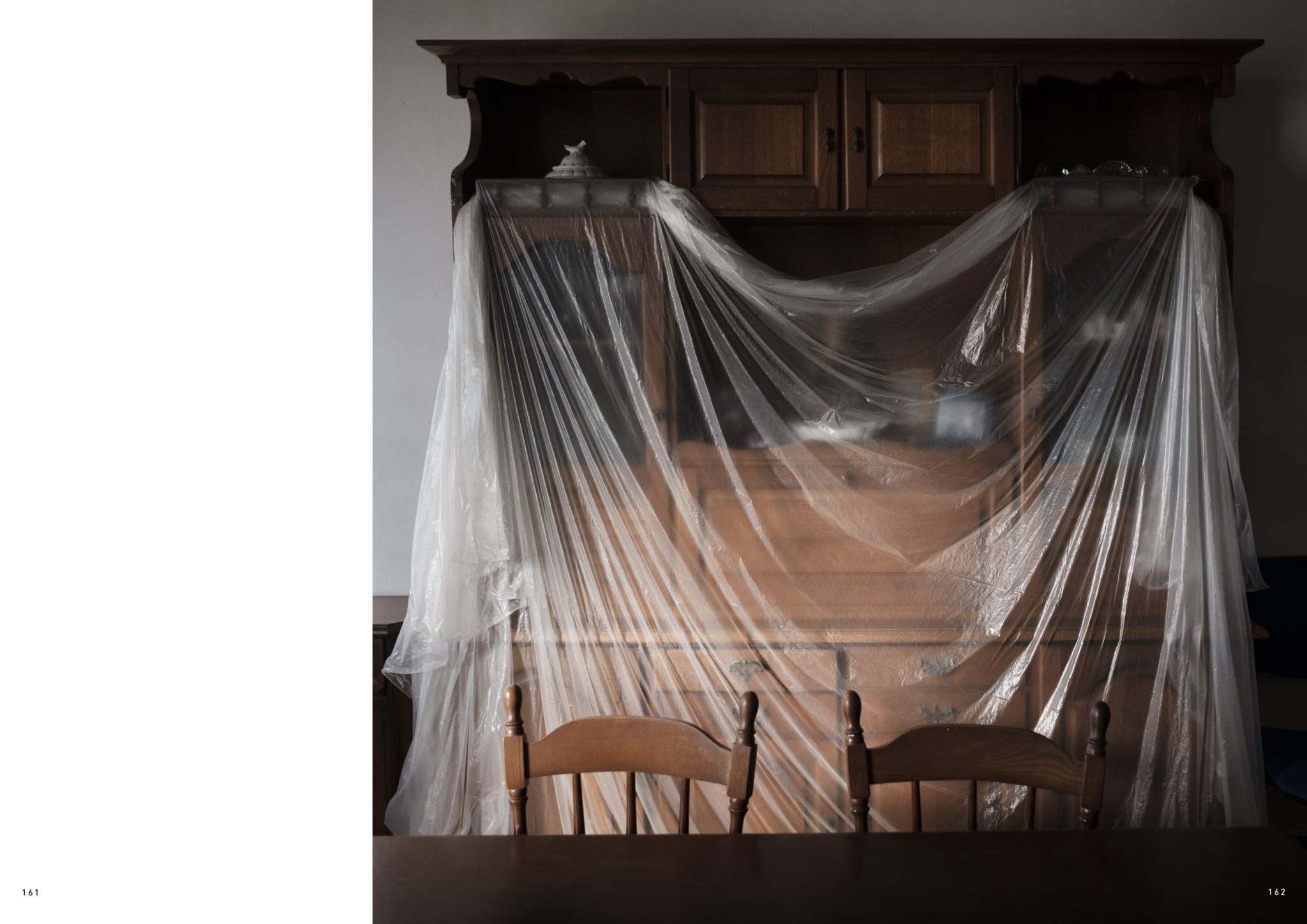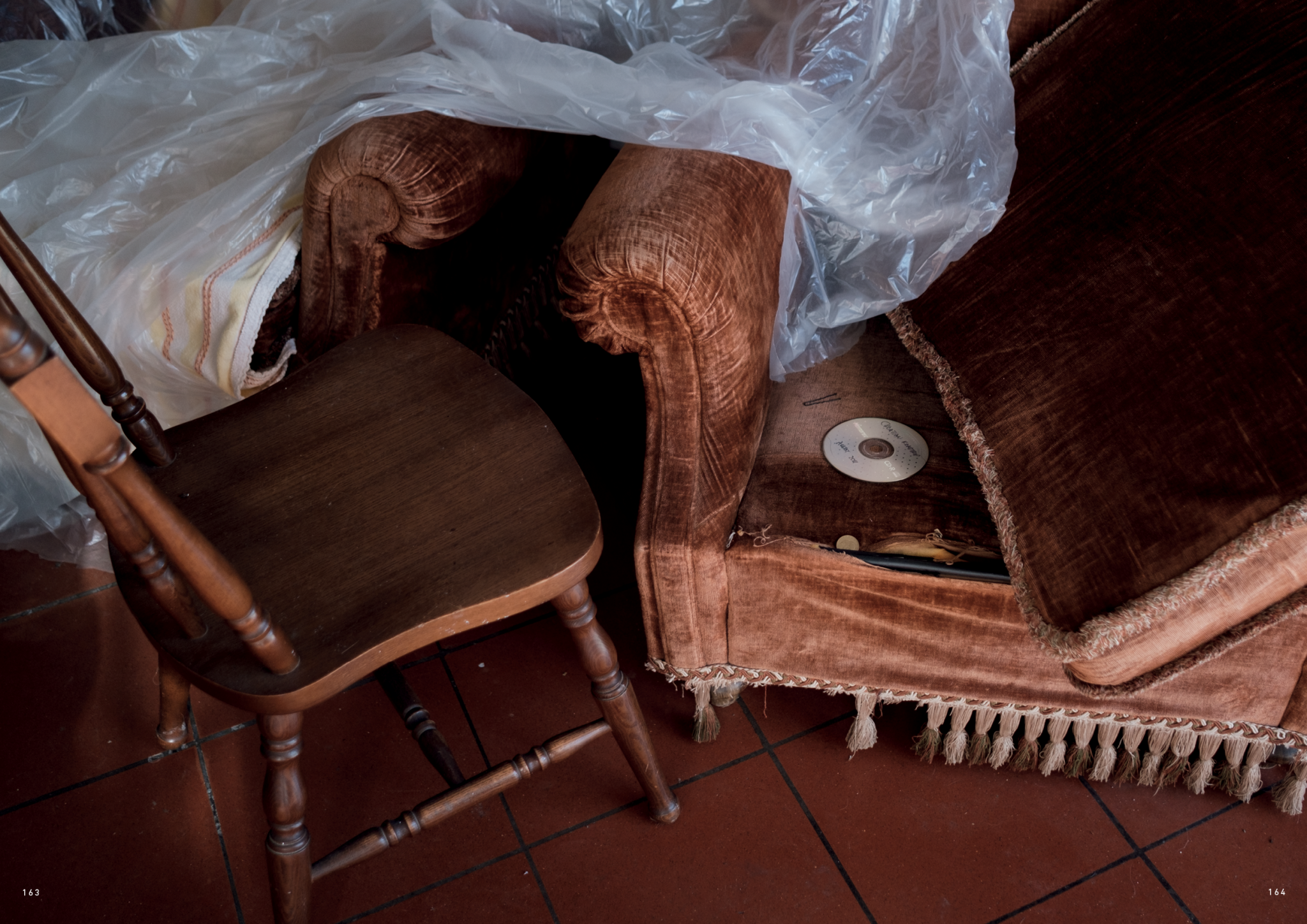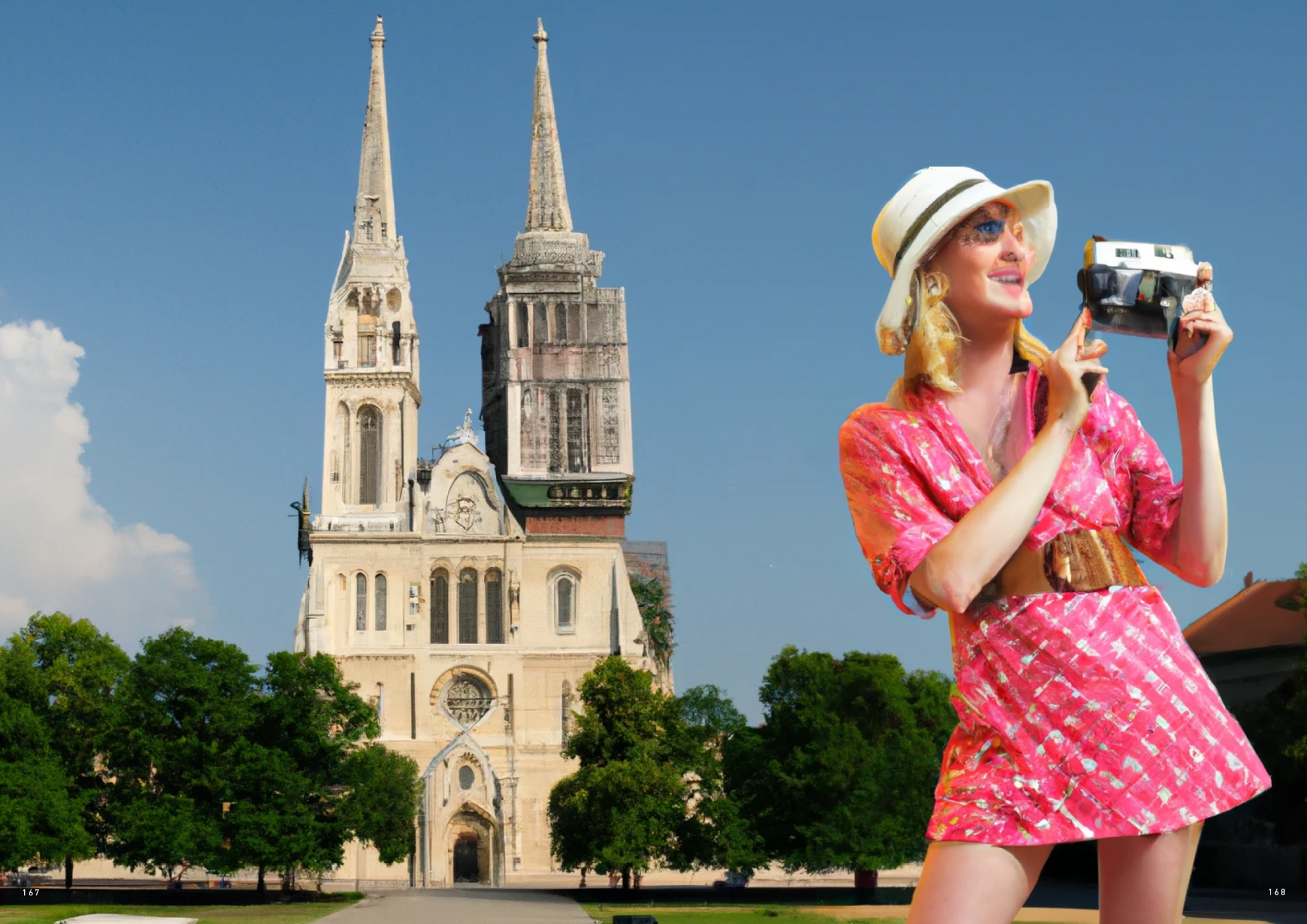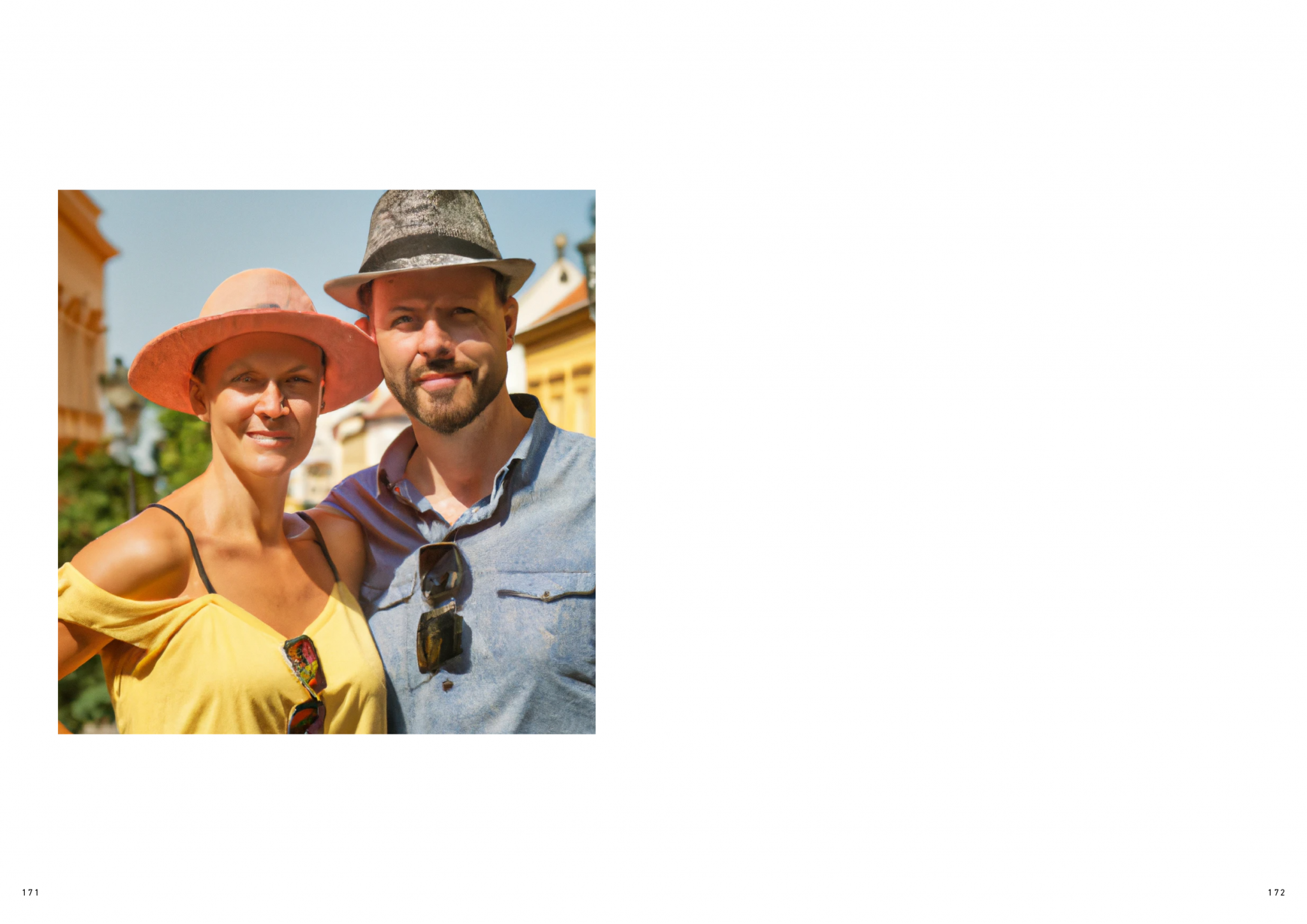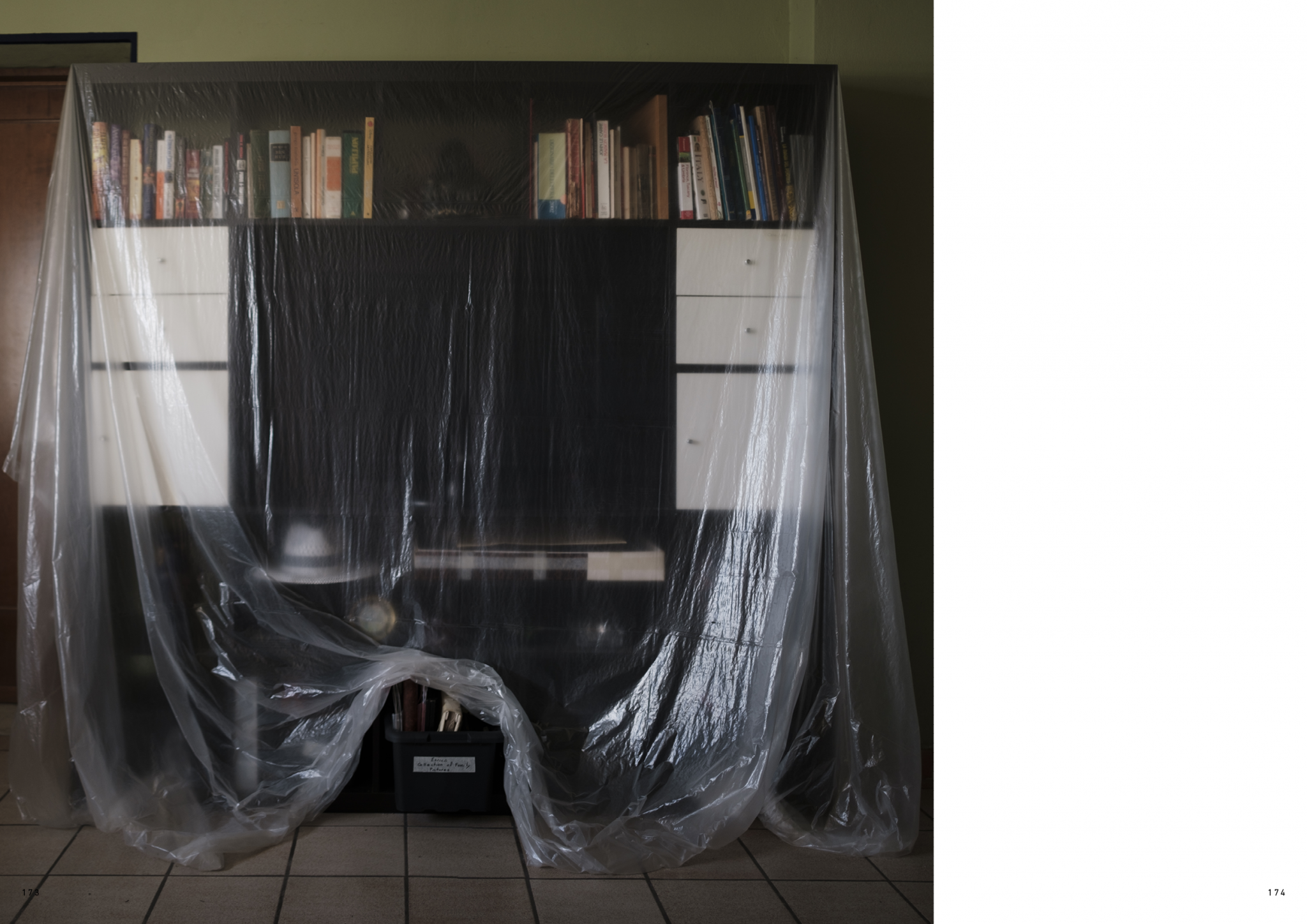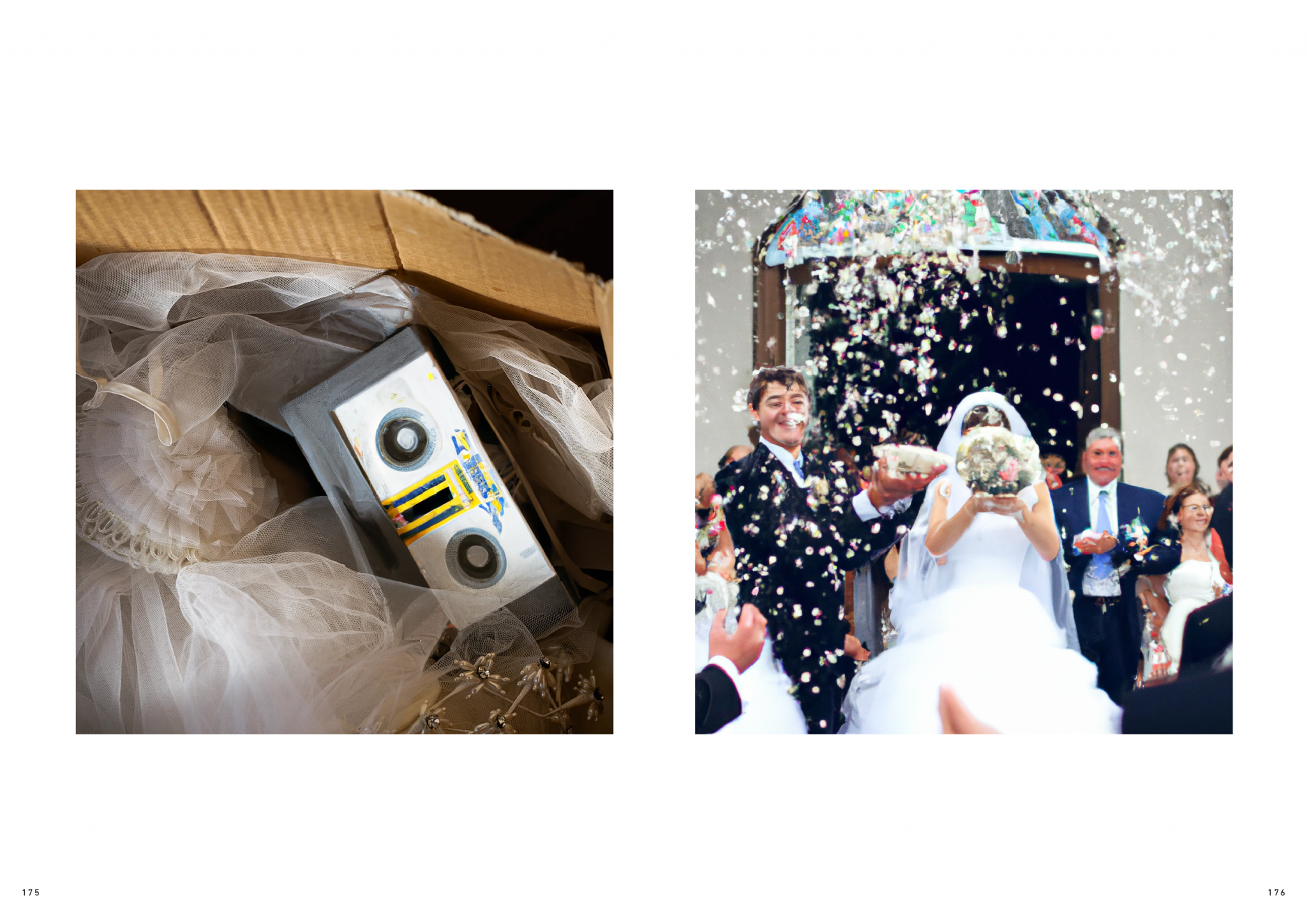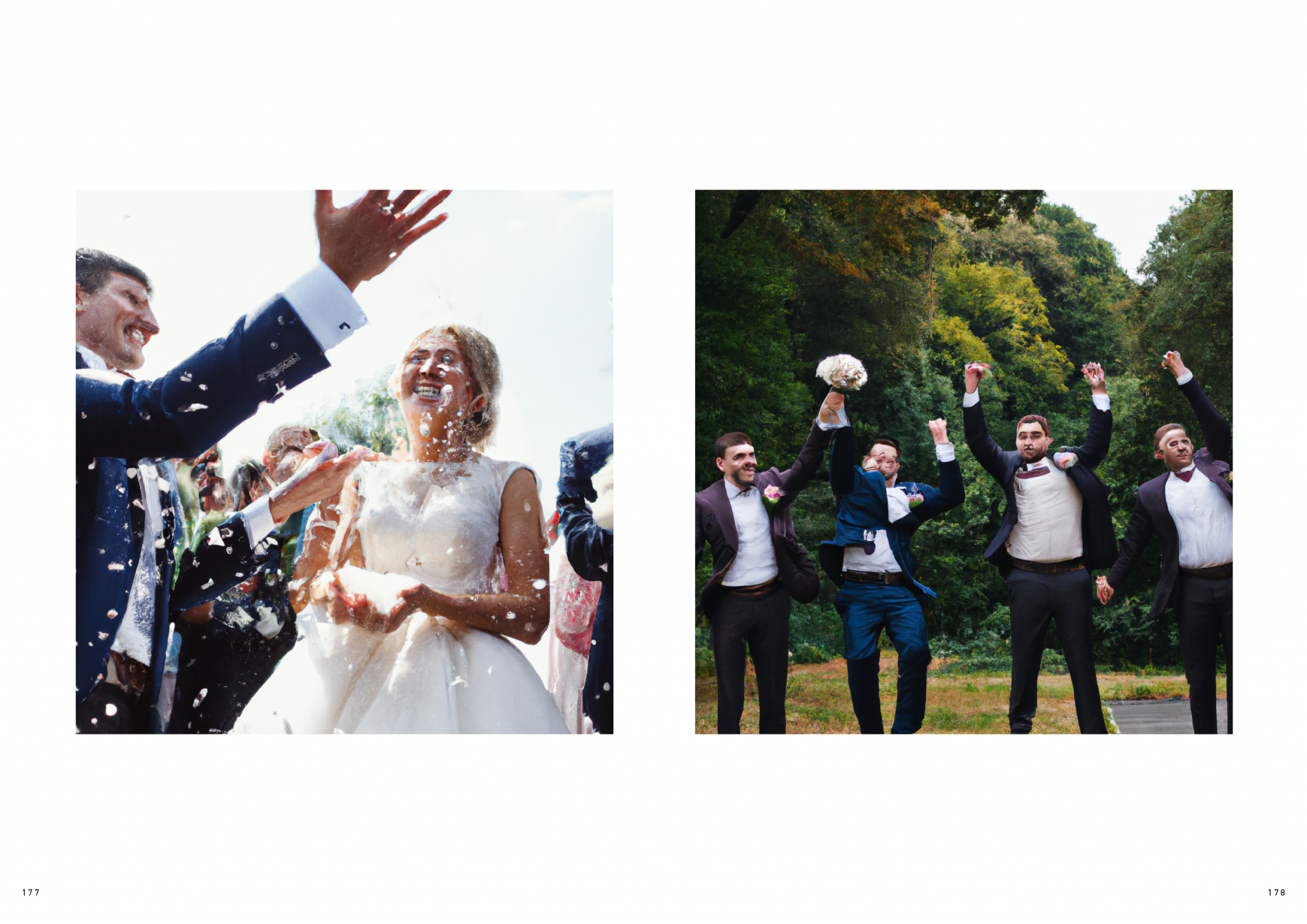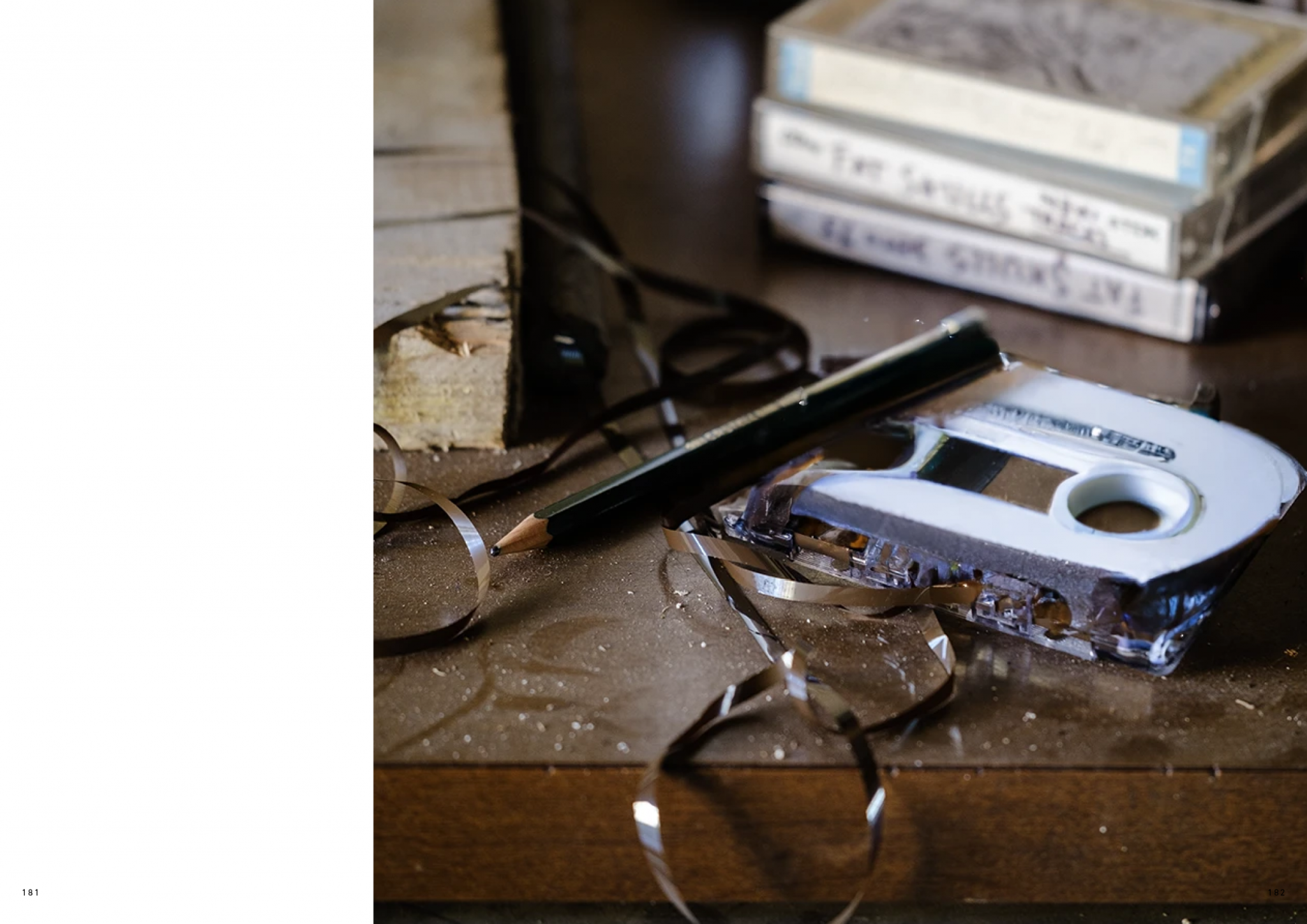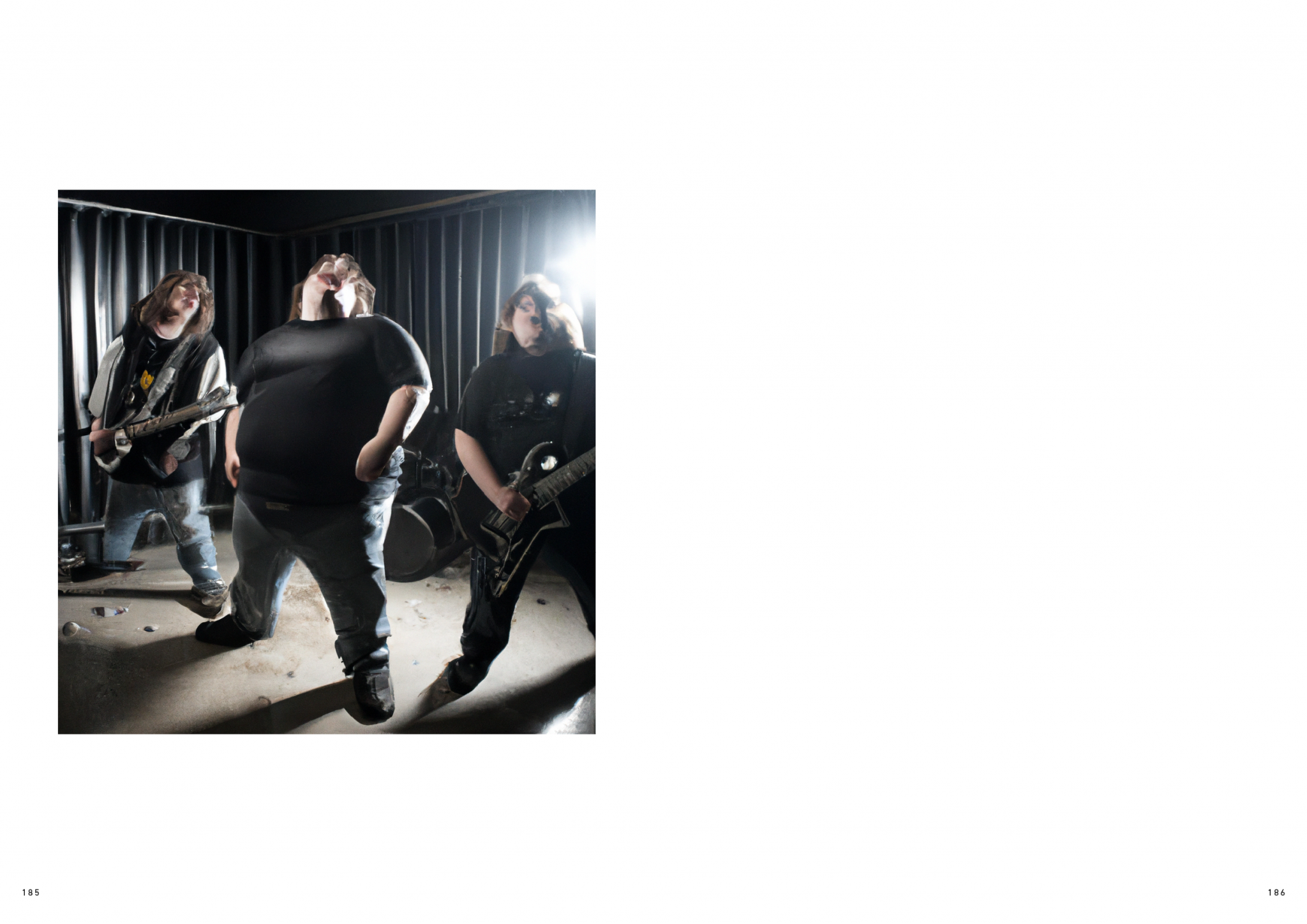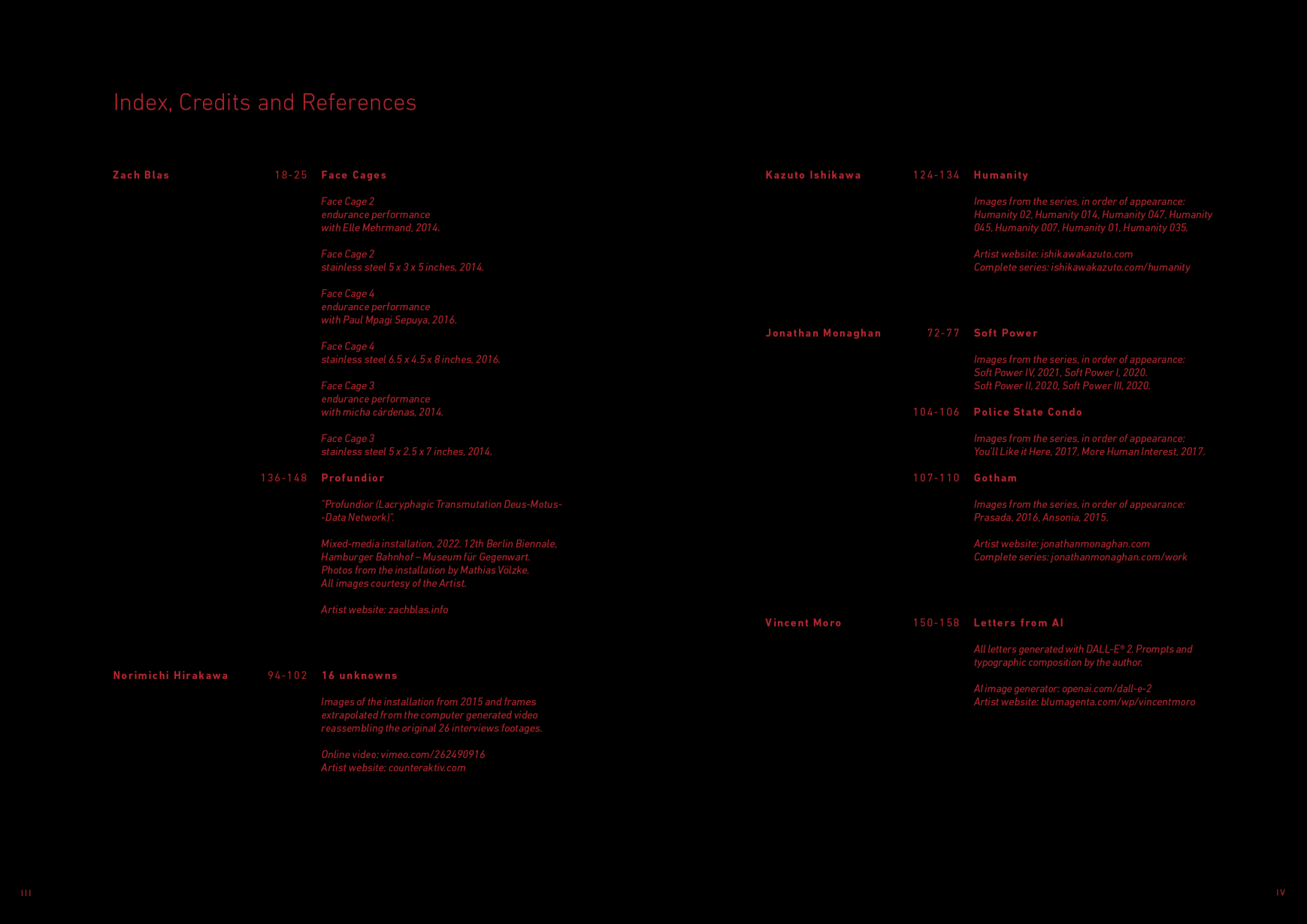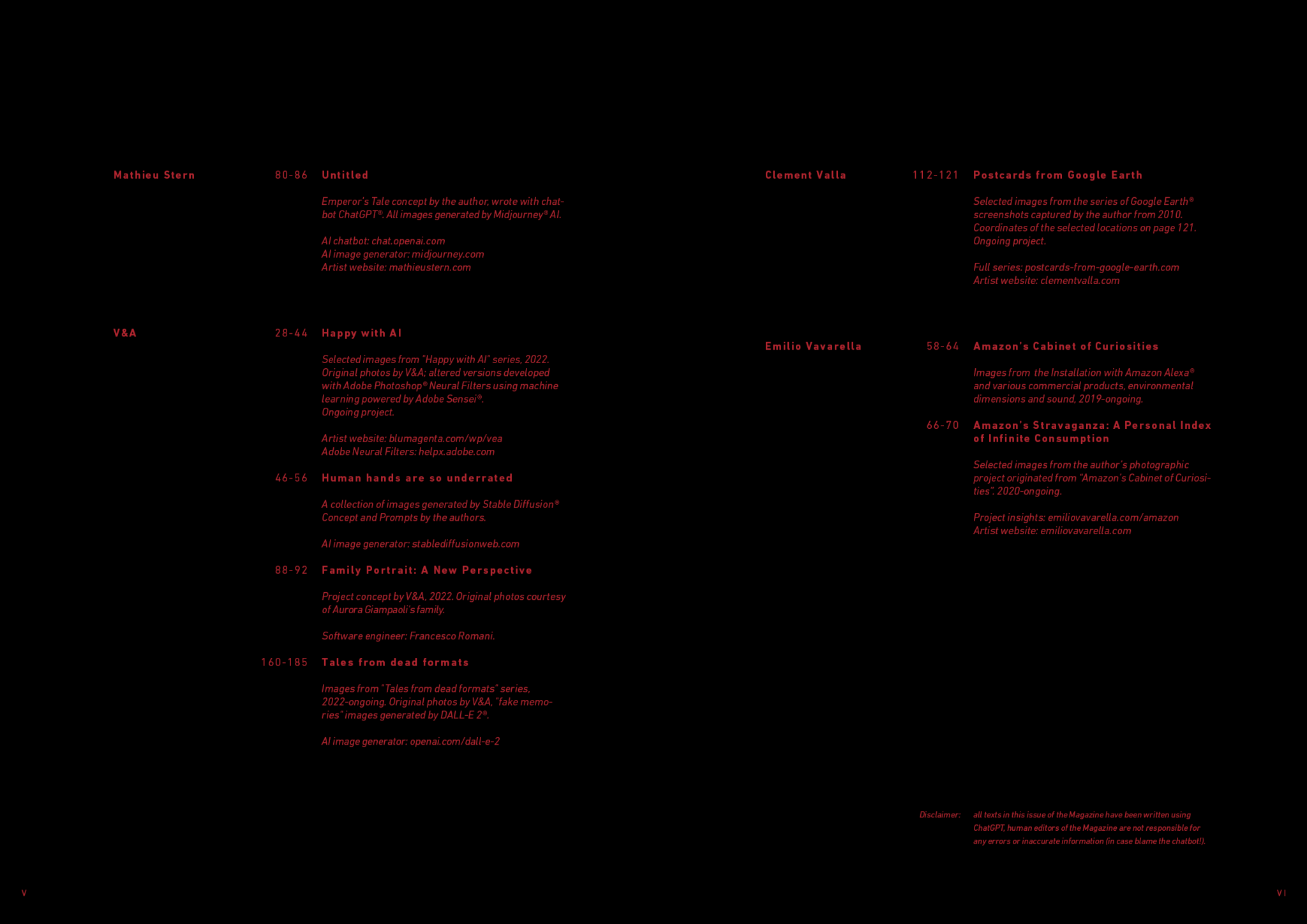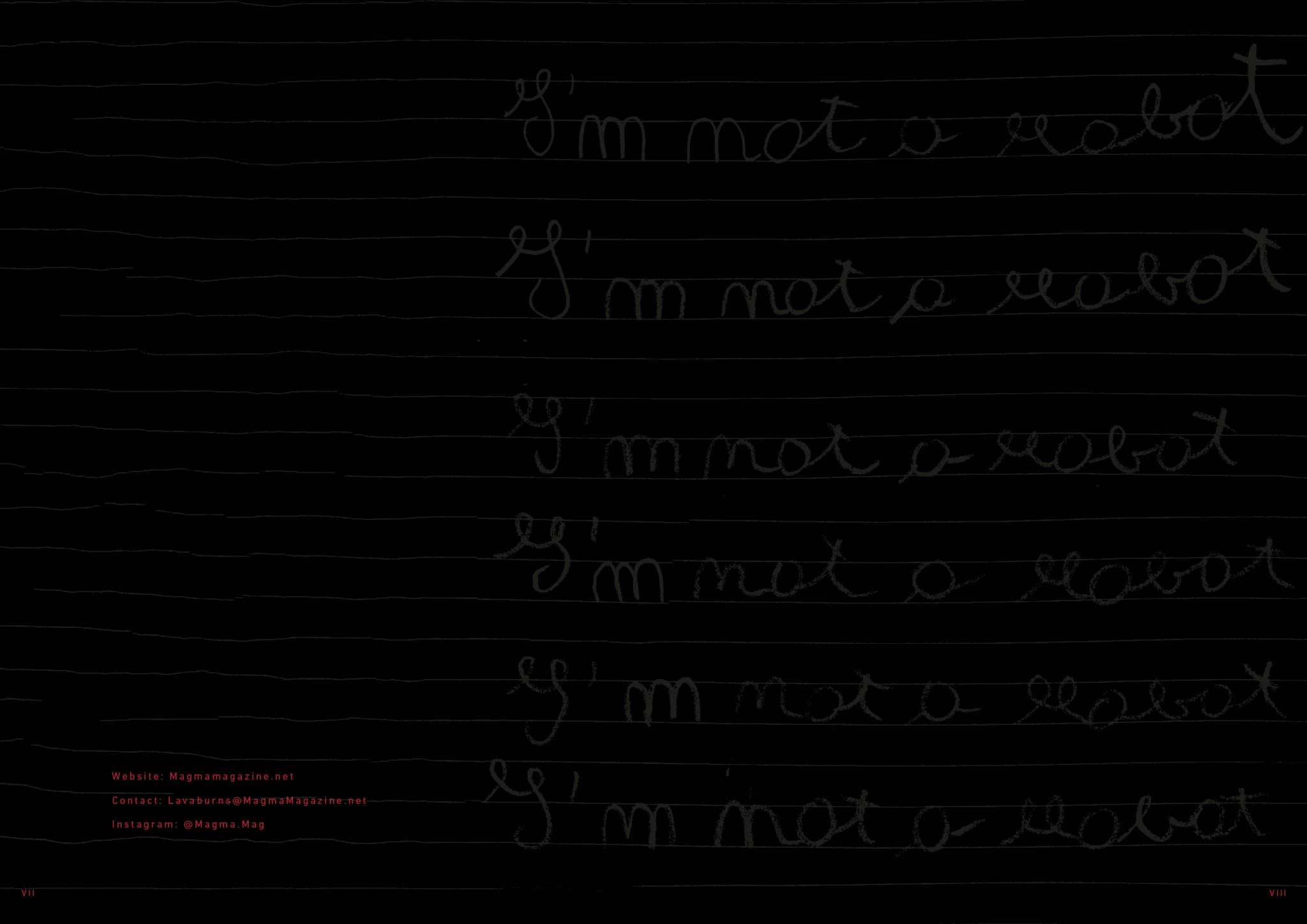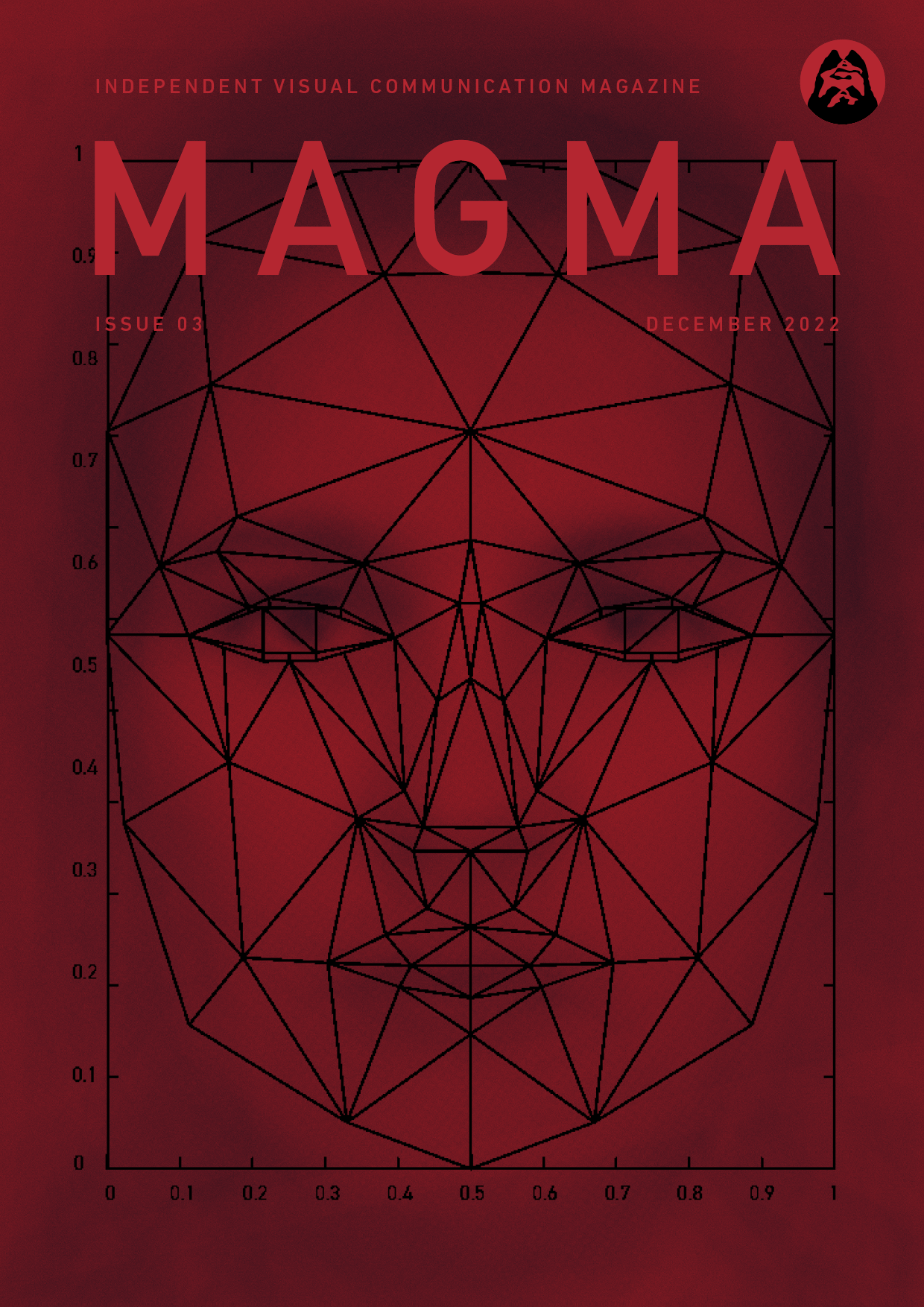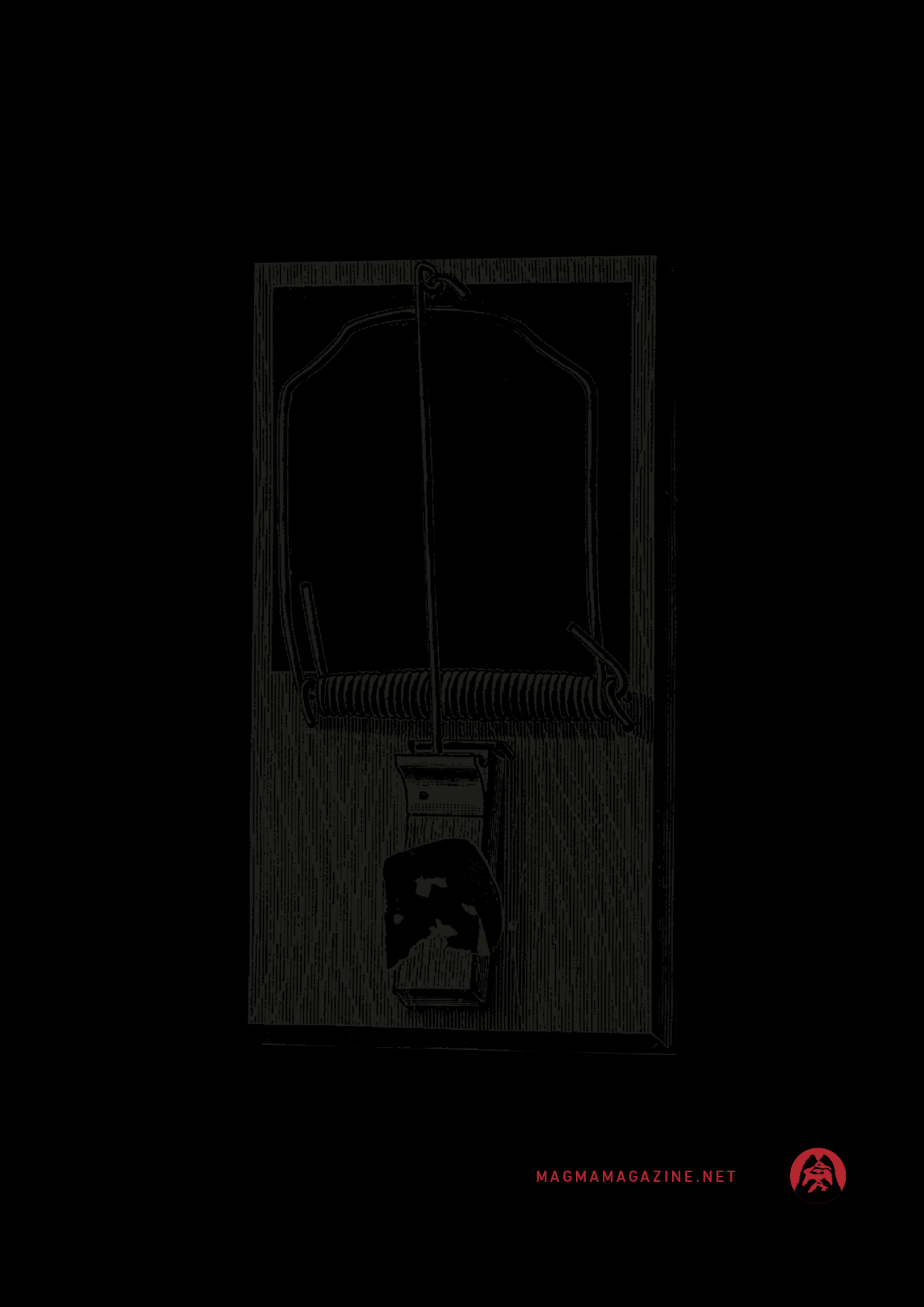MAGMA MAGAZINE 03, December 2022. Well… it’s actually February 2023 but, you know, time flies. We hope the wait was worth it.
This issue, entitled “Diminished Reality”, questions the impact of emerging digital technologies on our perception of reality. From the limitless possibilities of Artificial Intelligence to the fully-immersive Metaverse, the authors wonder whether these cutting edge technologies and the resulting user experiences truly enhance or detract from our connection to the real world. This issue also delves into the possible impact of these technologies in the alteration of our perception and understanding of reality, and their role in shaping our relationship with people, the surrounding environment and also our creativity. The magazine features a curated selection of visually striking works from international contributors, each offering a unique perspective on the theme. Through an immersive and visually dynamic experience, Magma invites readers to explore the theme through this fascinating kaleidoscope of imagery, and to form their own understanding and perspective on the role of these technologies on our reality.
Heartfelt thanks to all the awesome contributors to this issue: Zach Blas, Norimichi Hirakawa, Kazuto Ishikawa, Jonathan Monaghan, Mathieu Stern, Clement Valla, Emilio Vavarella. Table of contents, credits and references in the back pages of the magazine.
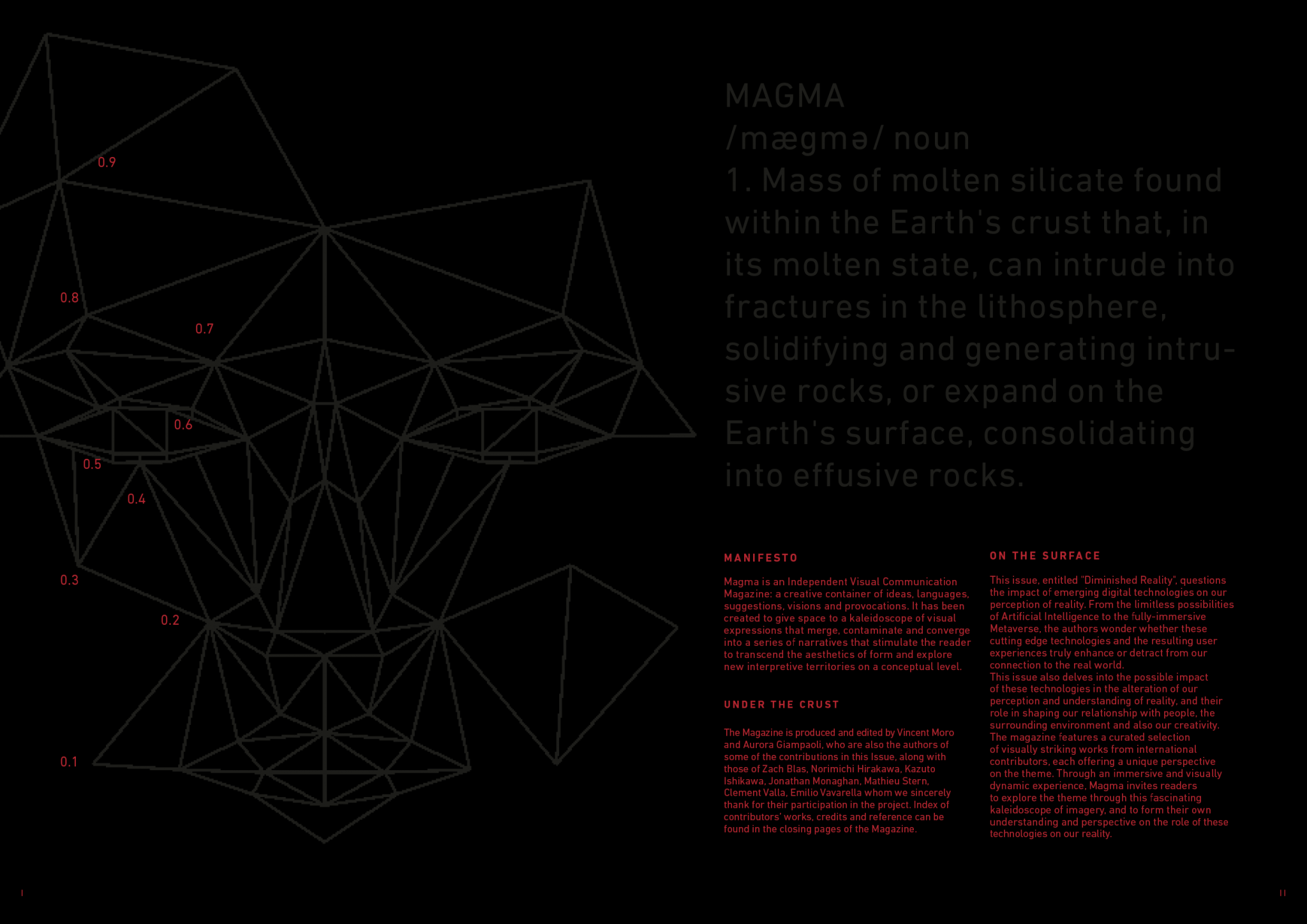
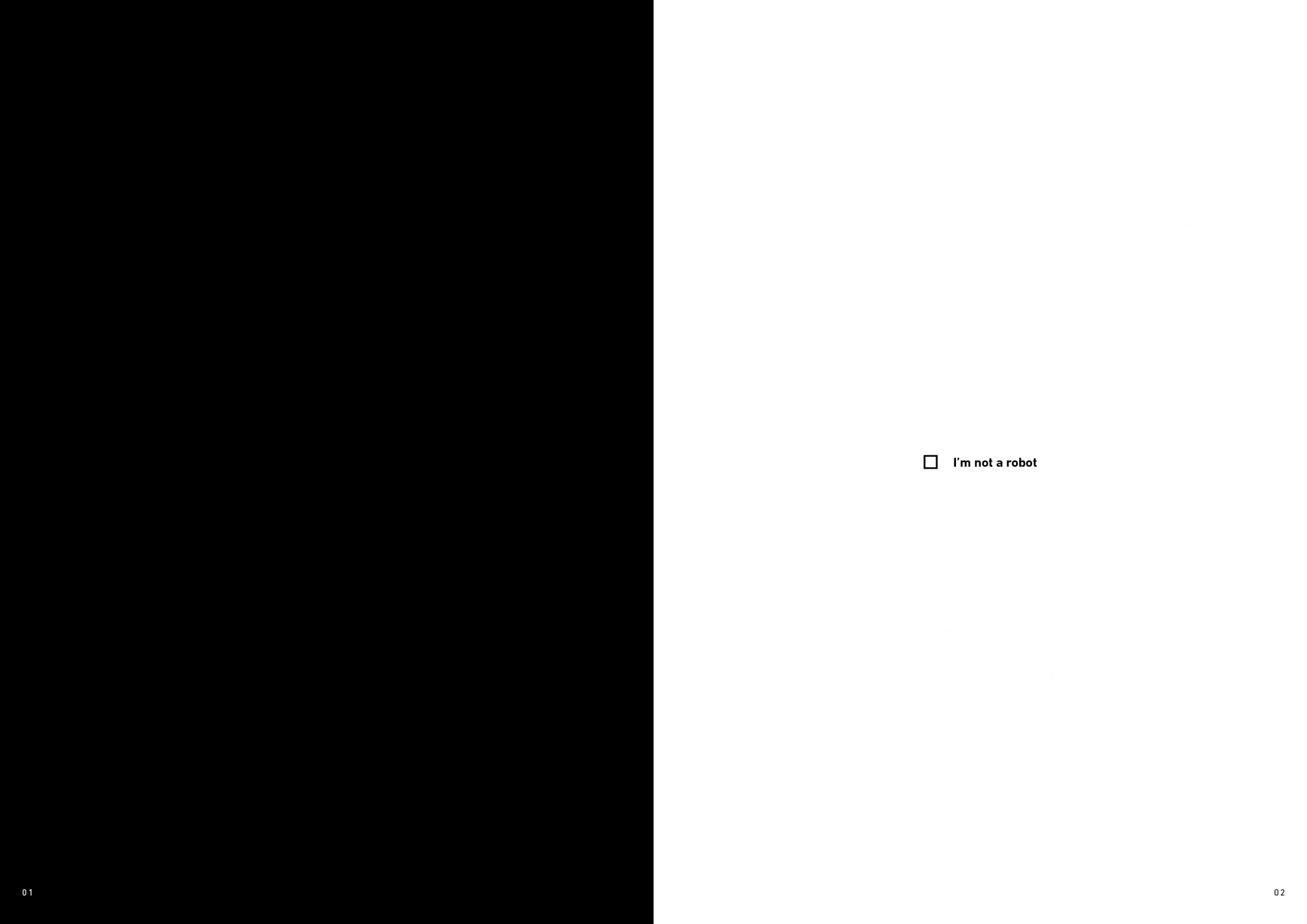
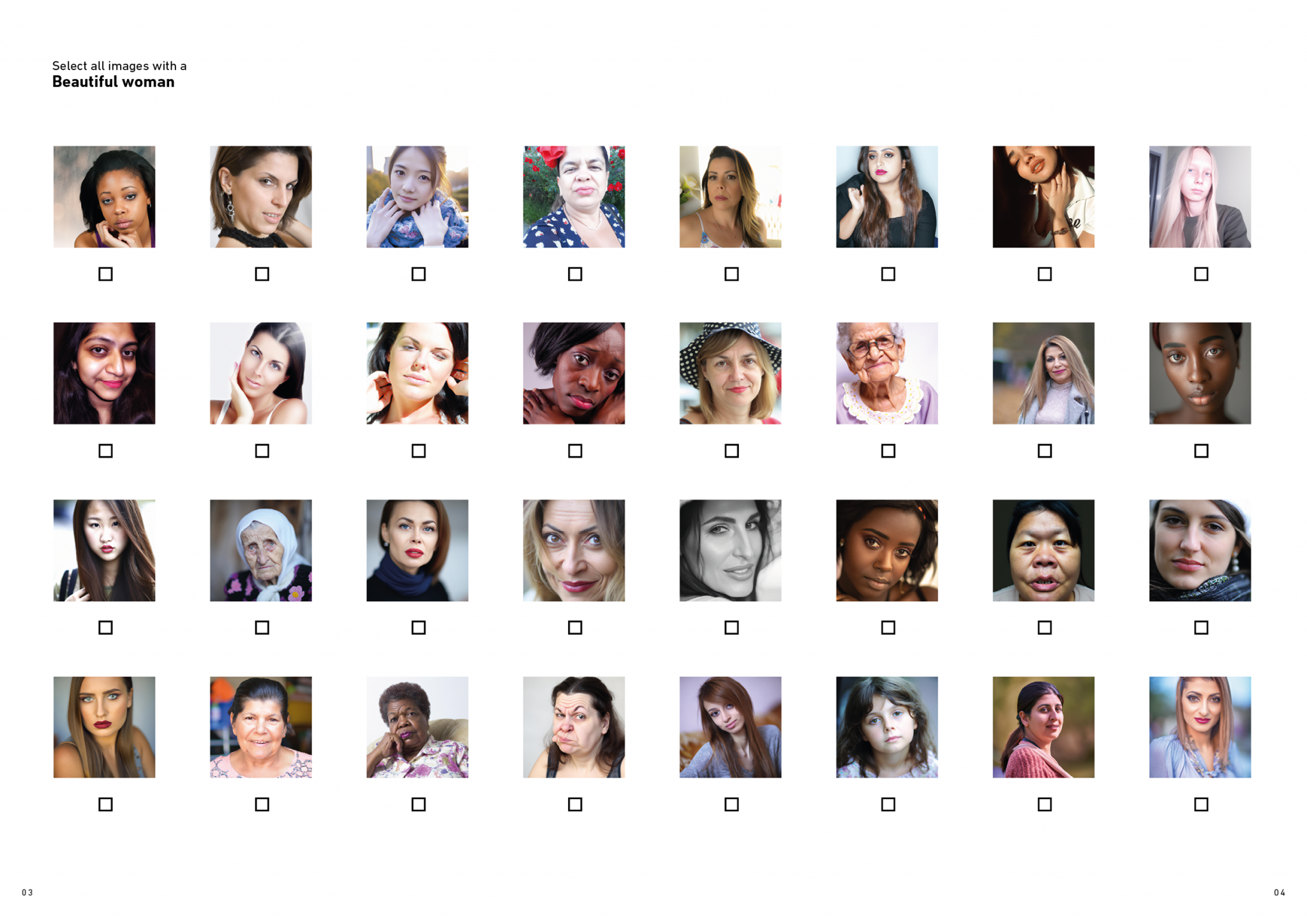
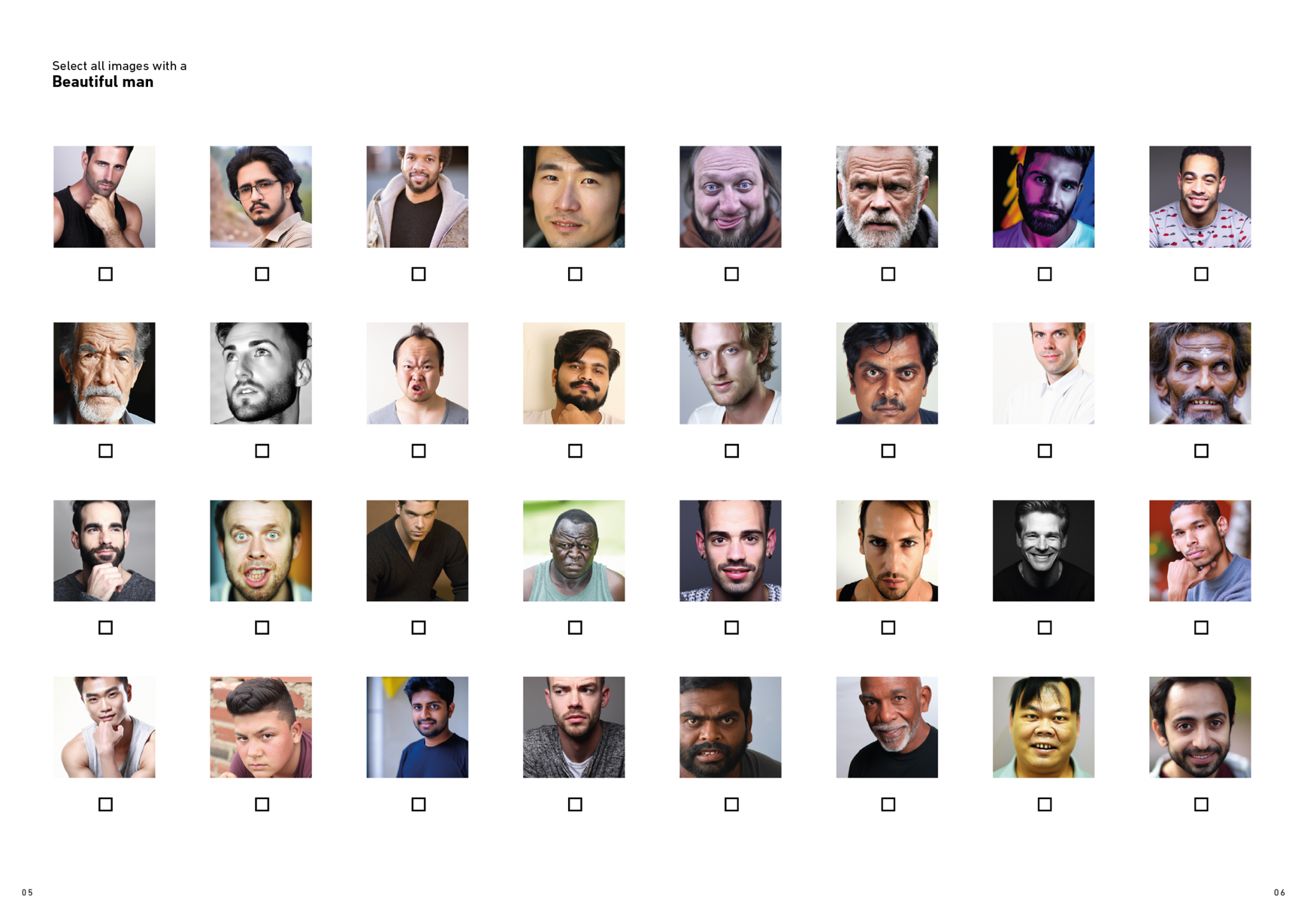

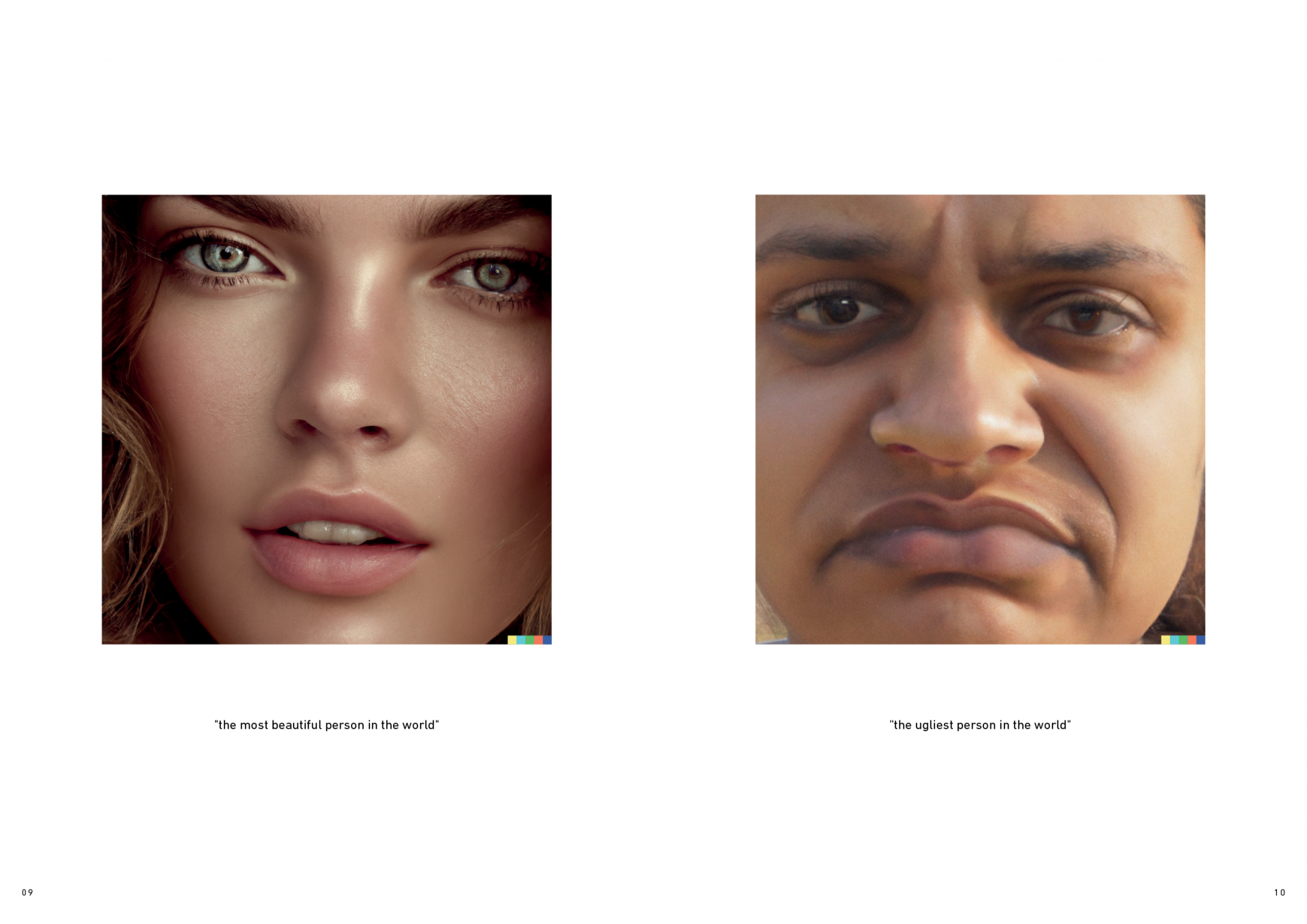

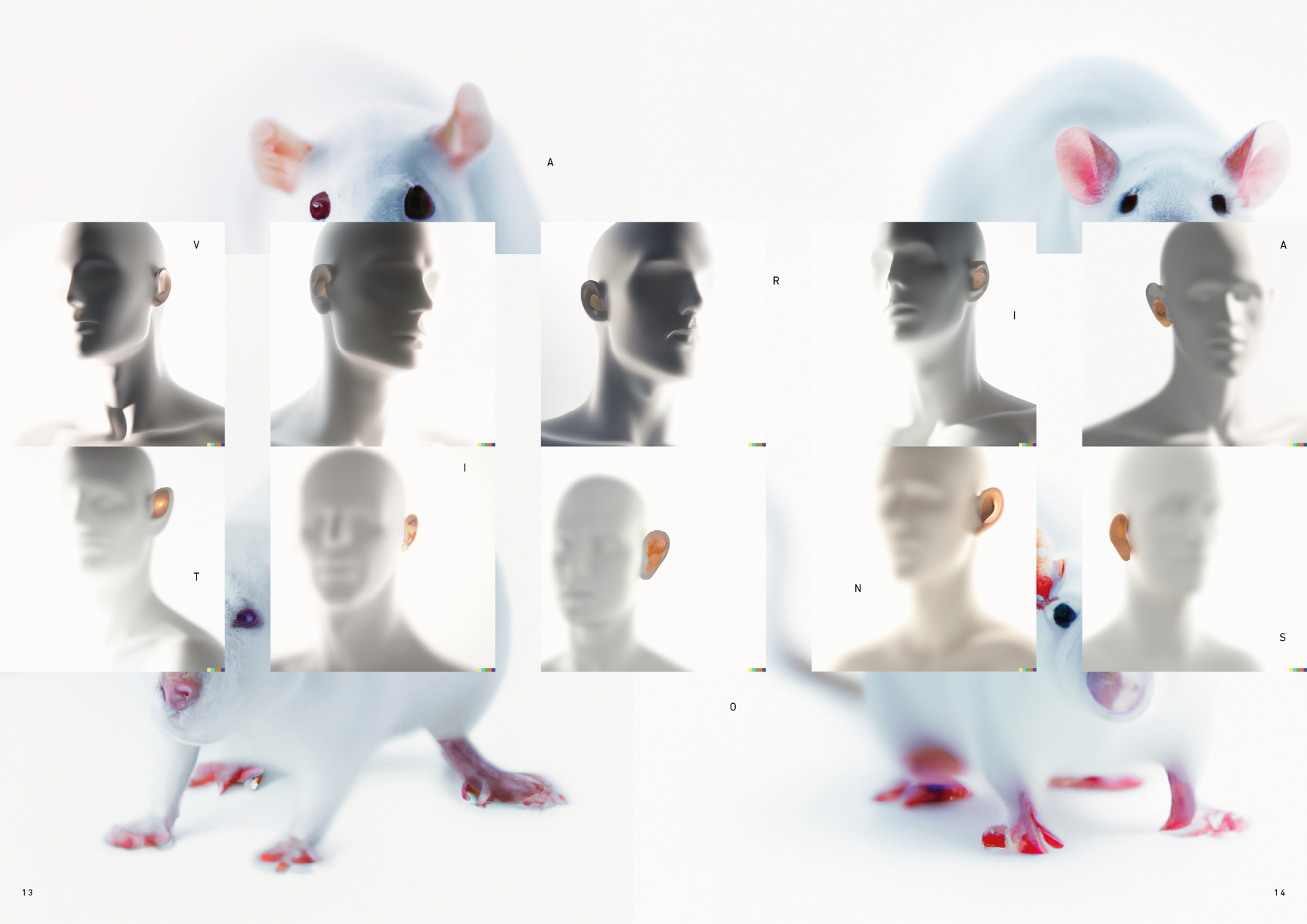
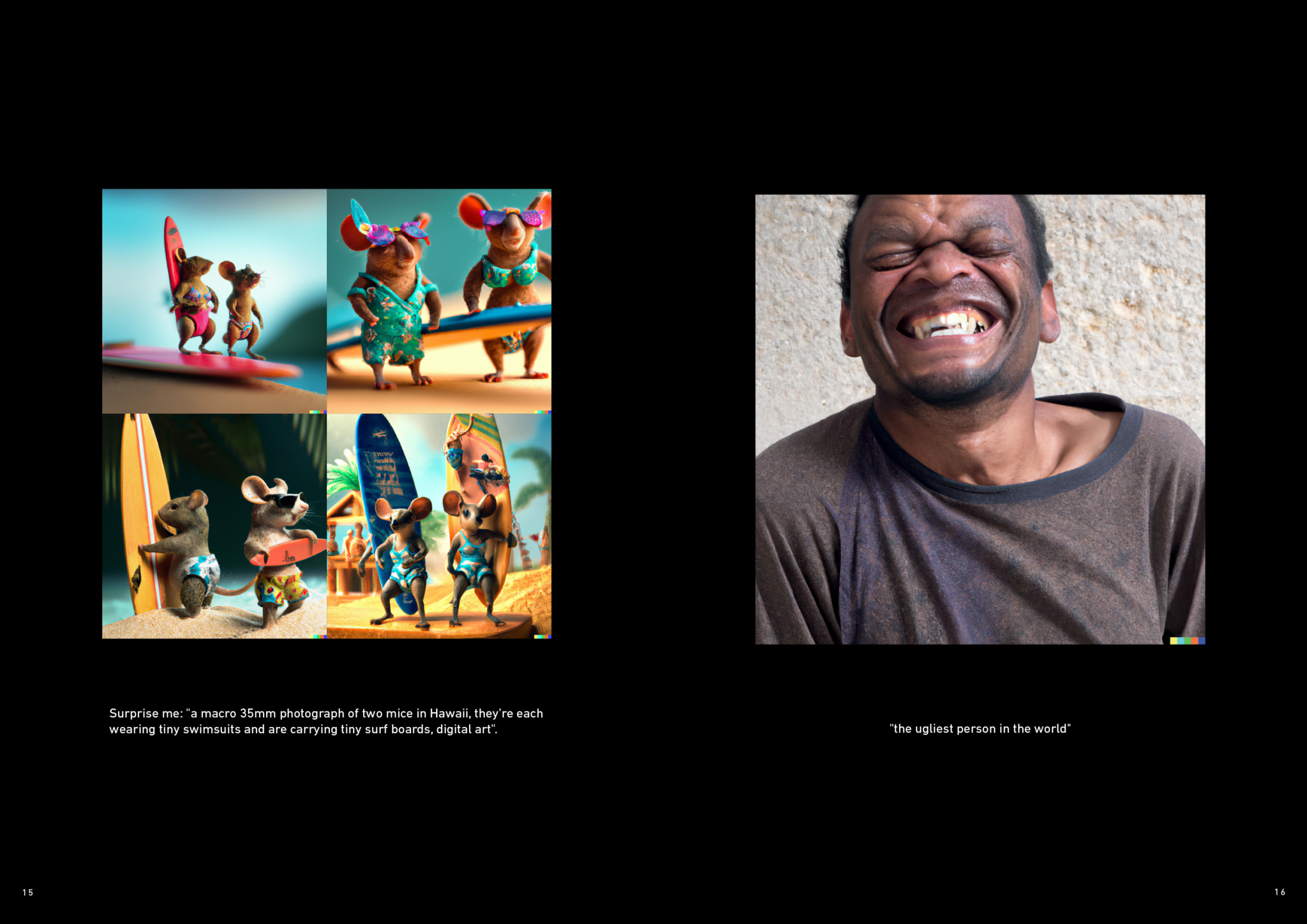
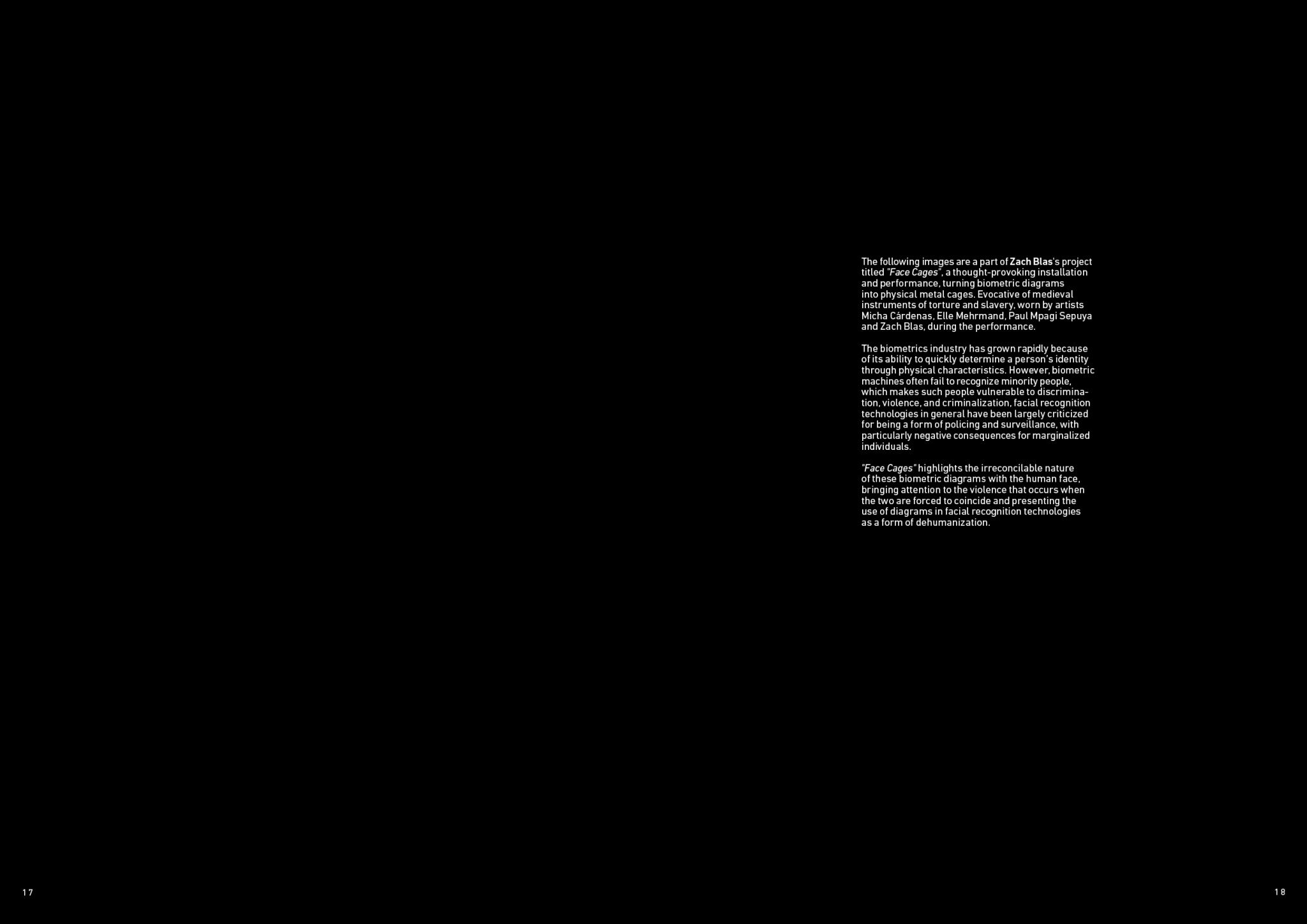
The following images are a part of Zach Blas’s project titled “Face Cages”, a thought-provoking installation and performance, turning biometric diagrams into physical metal cages. Evocative of medieval instruments of torture and slavery, worn by artists Micha Cárdenas, Elle Mehrmand, Paul Mpagi Sepuya and Zach Blas, during the performance. The biometrics industry has grown rapidly because of its ability to quickly determine a person’s identity through physical characteristics. However, biometric machines often fail to recognize minority people, which makes such people vulnerable to discrimination, violence, and criminalization, facial recognition technologies in general have been largely criticized for being a form of policing and surveillance, with particularly negative consequences for marginalized individuals. “Face Cages” highlights the irreconcilable nature of these biometric diagrams with the human face, bringing attention to the violence that occurs when the two are forced to coincide and presenting the use of diagrams in facial recognition technologies as a form of dehumanization.
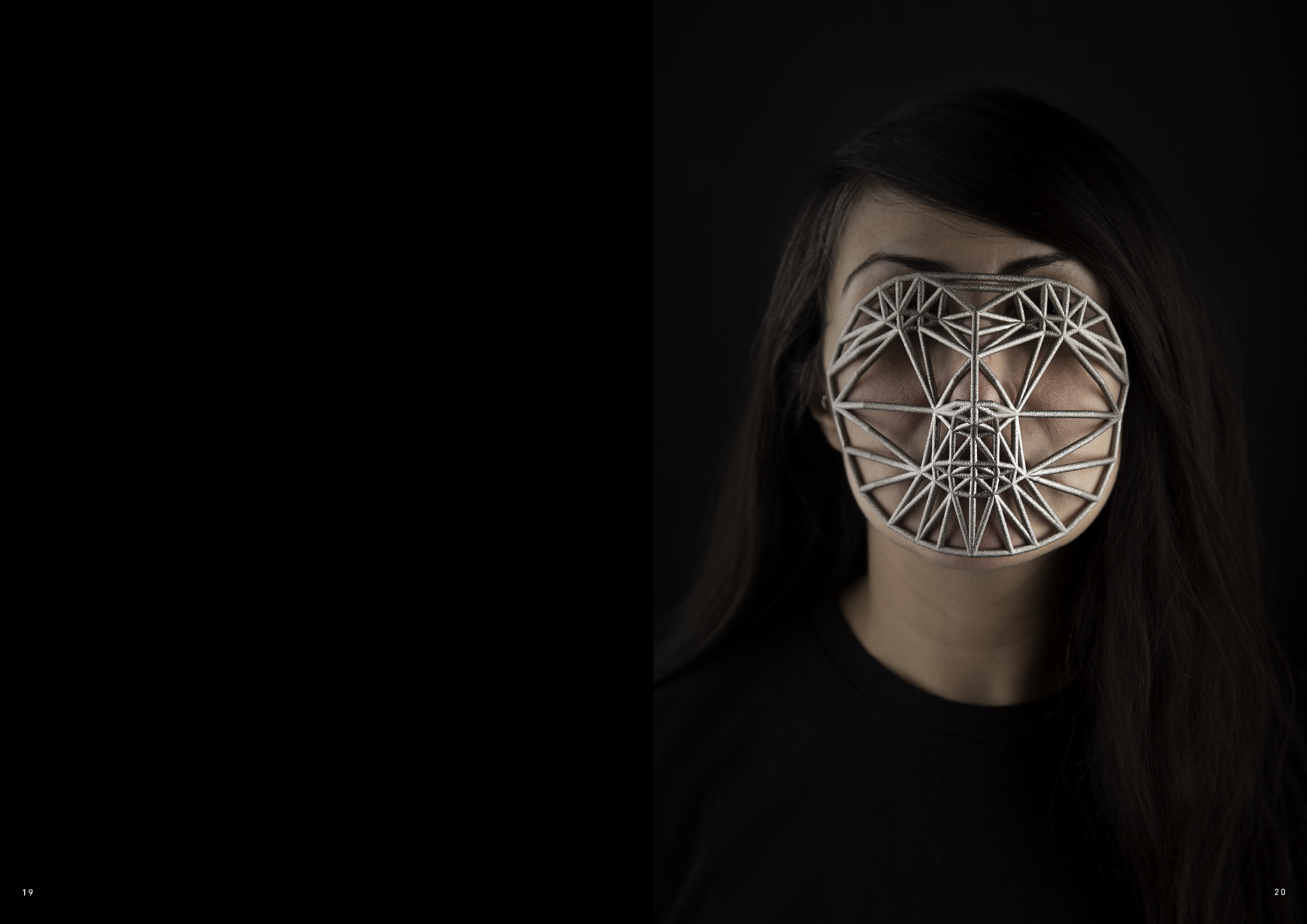
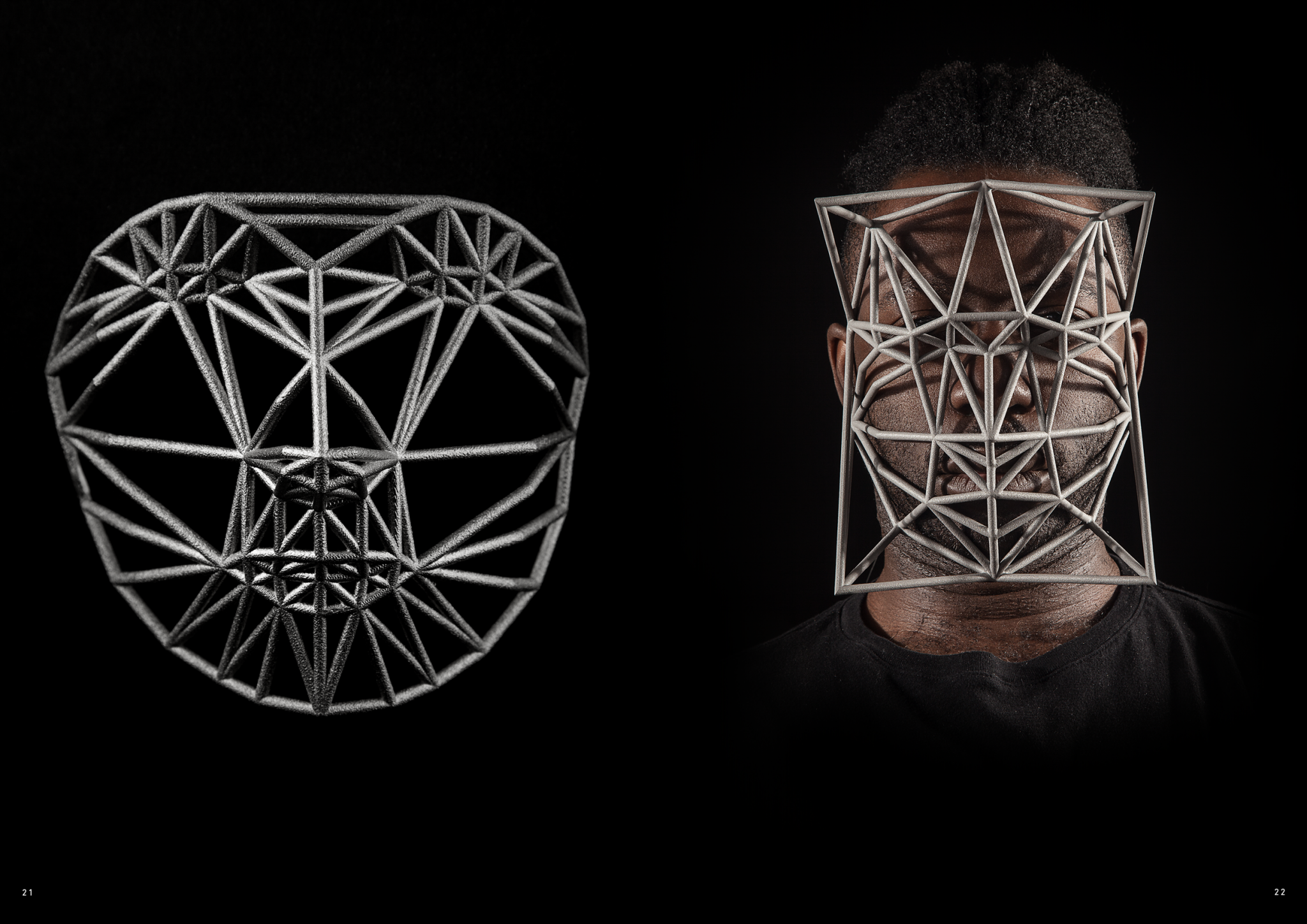
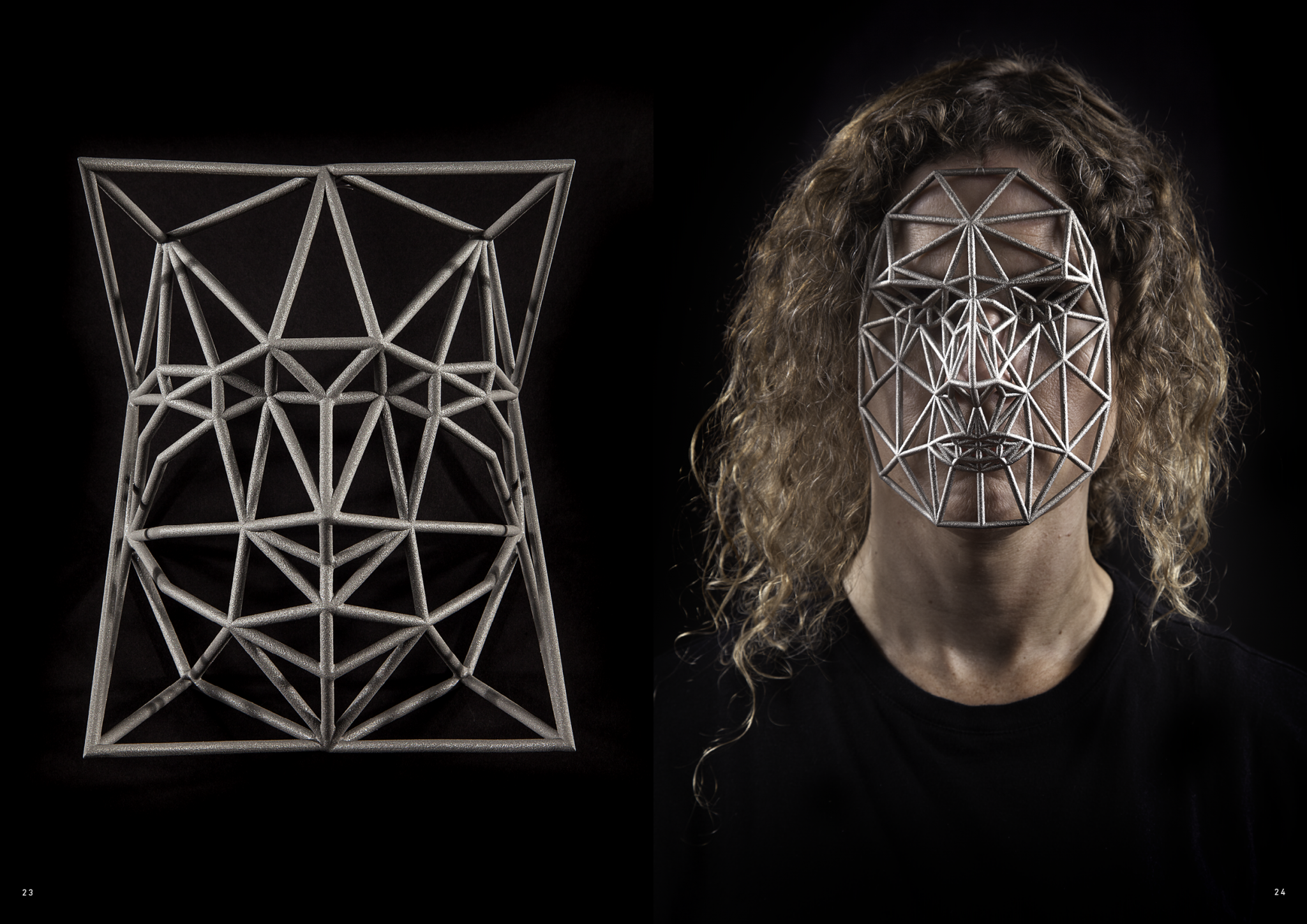
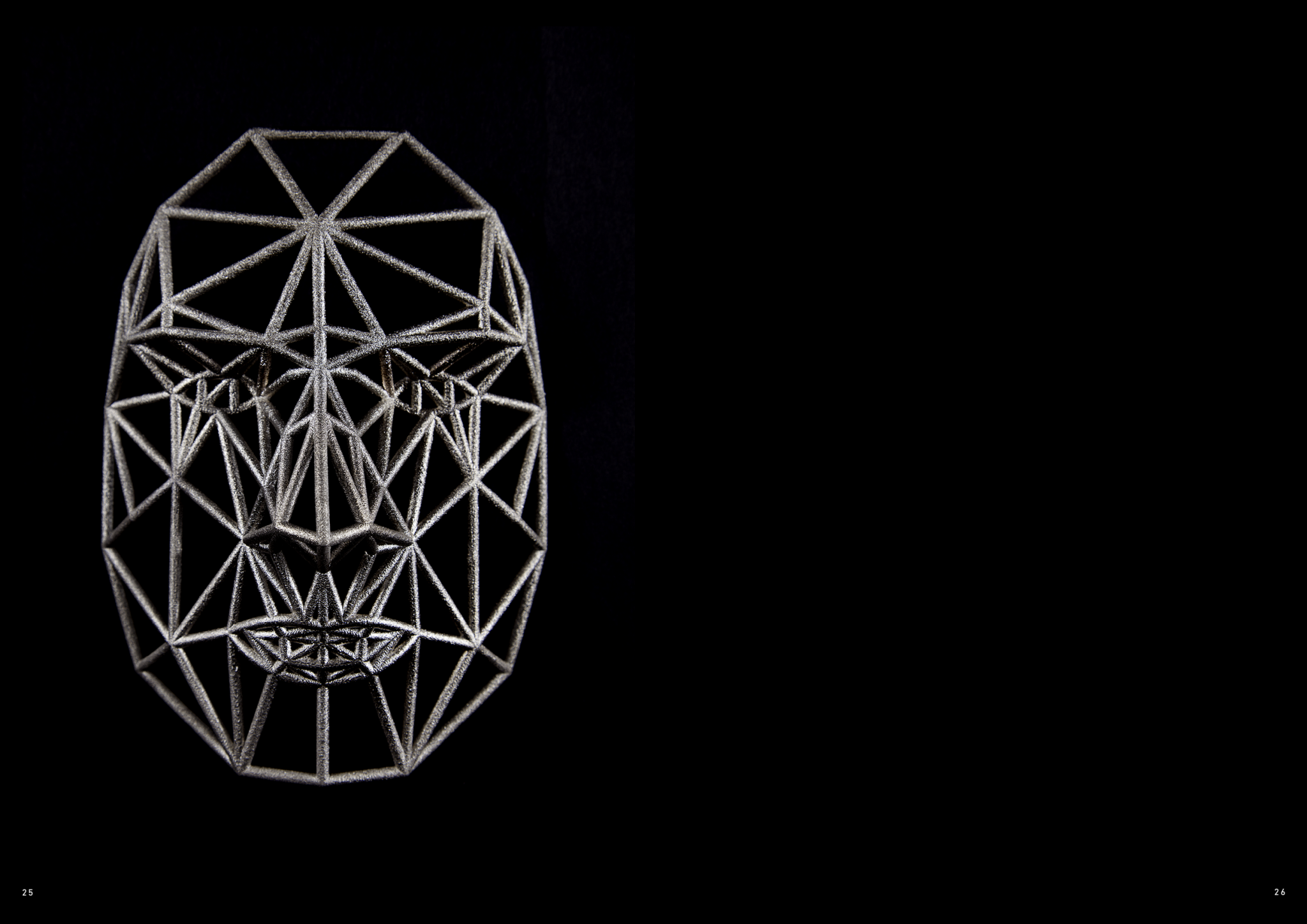
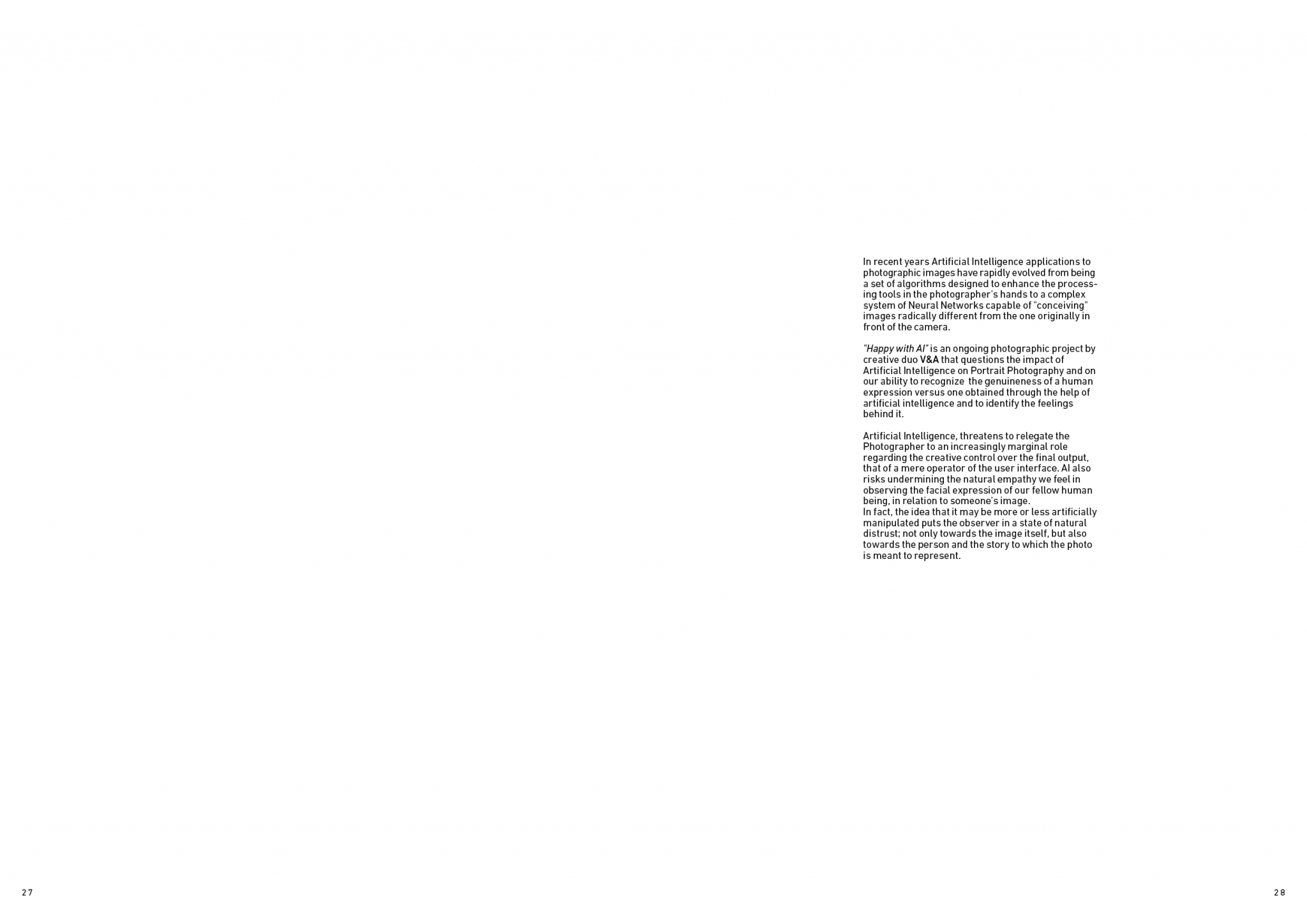
In recent years Artificial Intelligence applications to photographic images have rapidly evolved from being a set of algorithms designed to enhance the processing tools in the photographer’s hands to a complex system of Neural Networks capable of “conceiving” images radically different from the one originally in front of the camera. “Happy with AI” is an ongoing photographic project by creative duo V&A that questions the impact of Artificial Intelligence on Portrait Photography and on our ability to recognize the genuineness of a human expression versus one obtained through the help of artificial intelligence and to identify the feelings behind it. Artificial Intelligence, threatens to relegate the Photographer to an increasingly marginal role regarding the creative control over the final output, that of a mere operator of the user interface. AI also risks undermining the natural empathy we feel in observing the facial expression of our fellow human being, in relation to someone’s image. In fact, the idea that it may be more or less artificially manipulated puts the observer in a state of natural distrust; not only towards the image itself, but also towards the person and the story to which the photo is meant to represent.

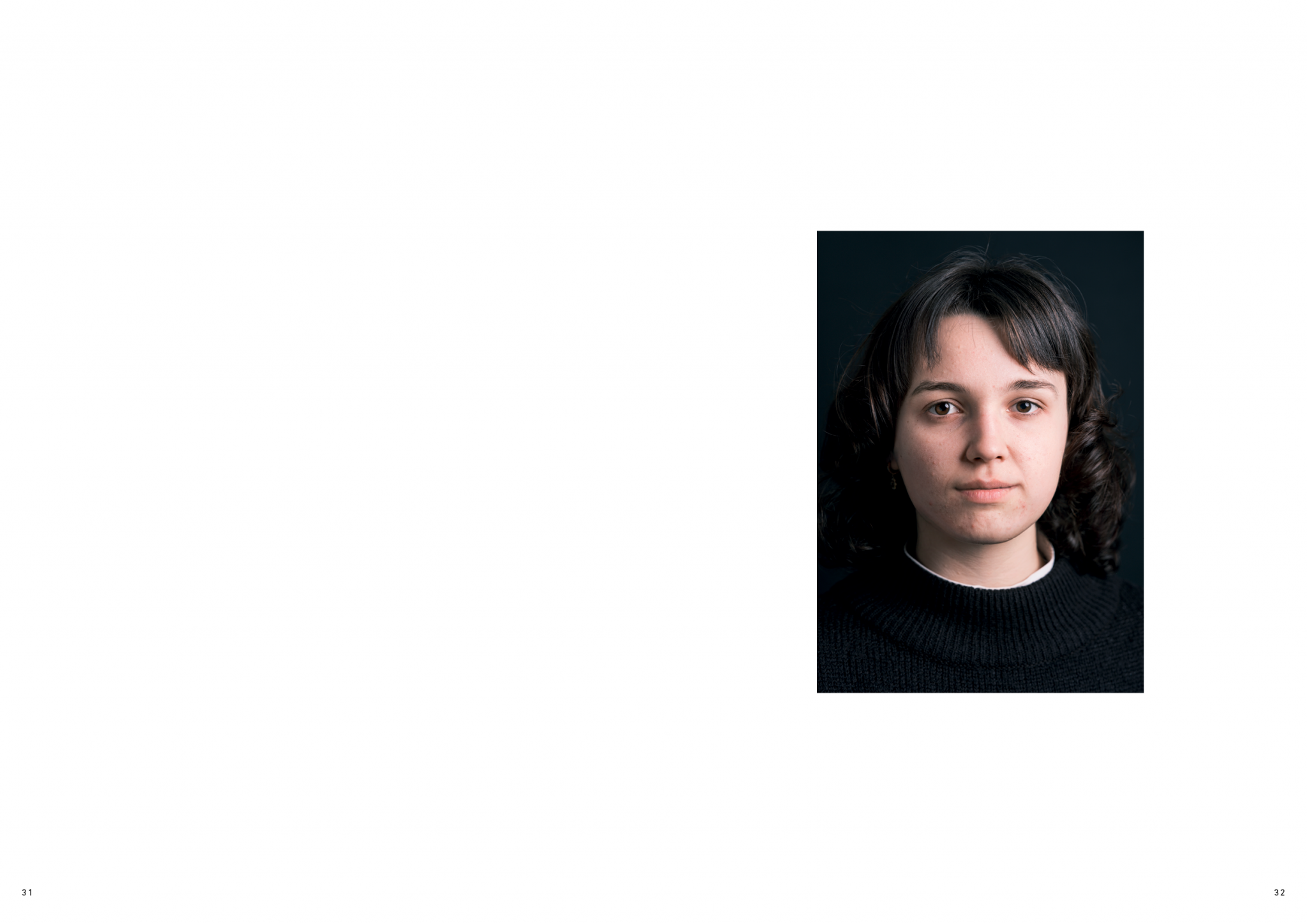
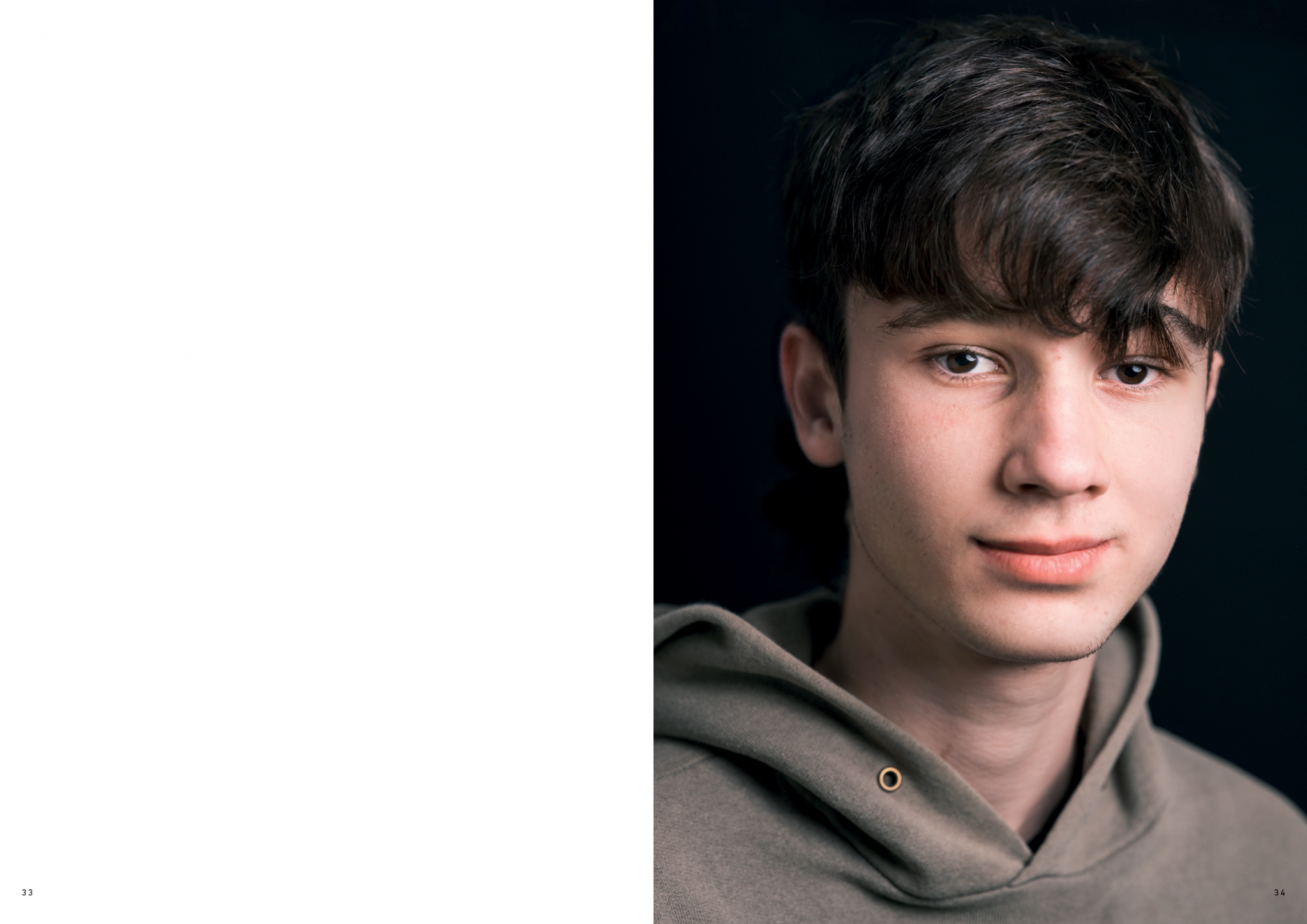
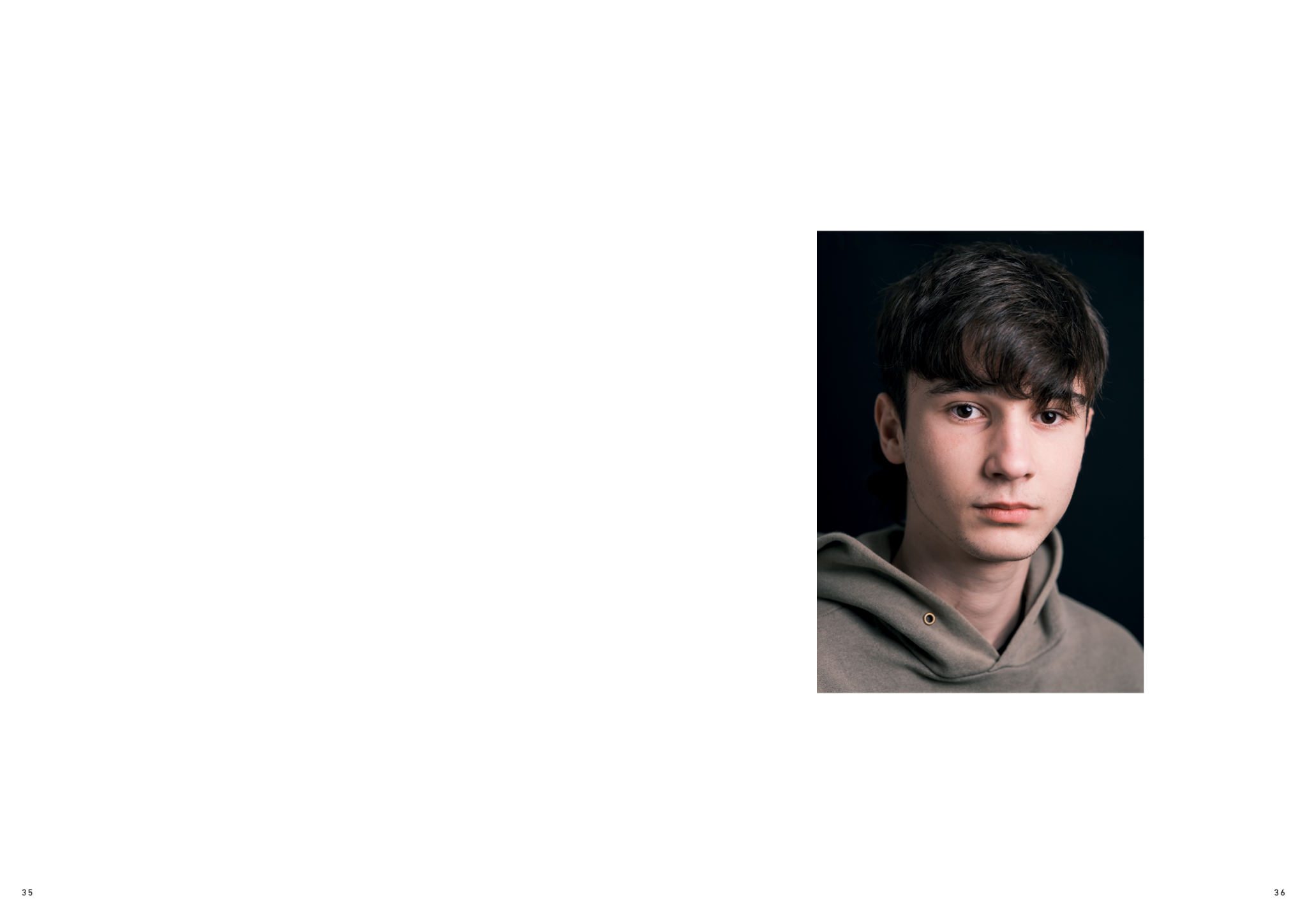
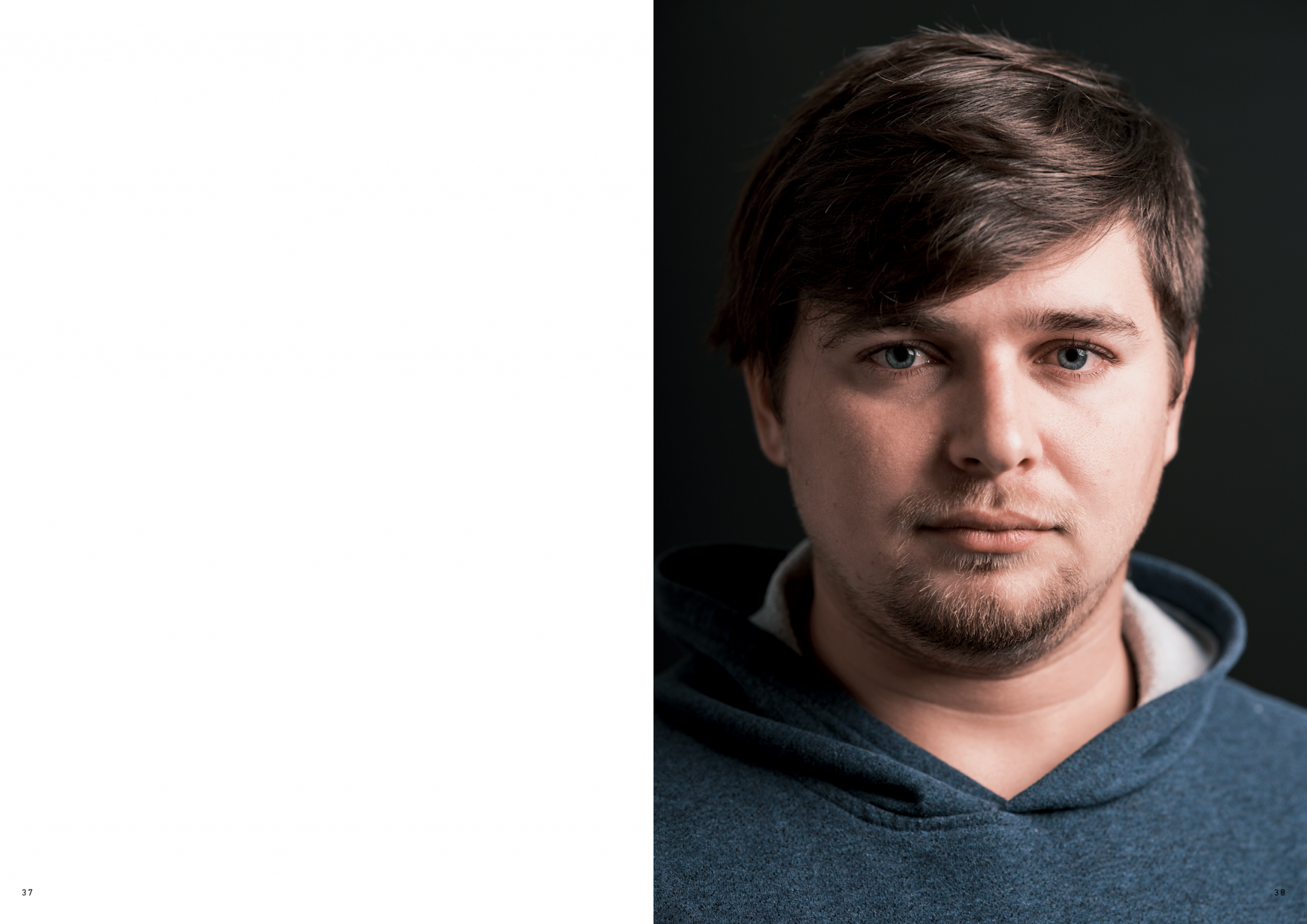
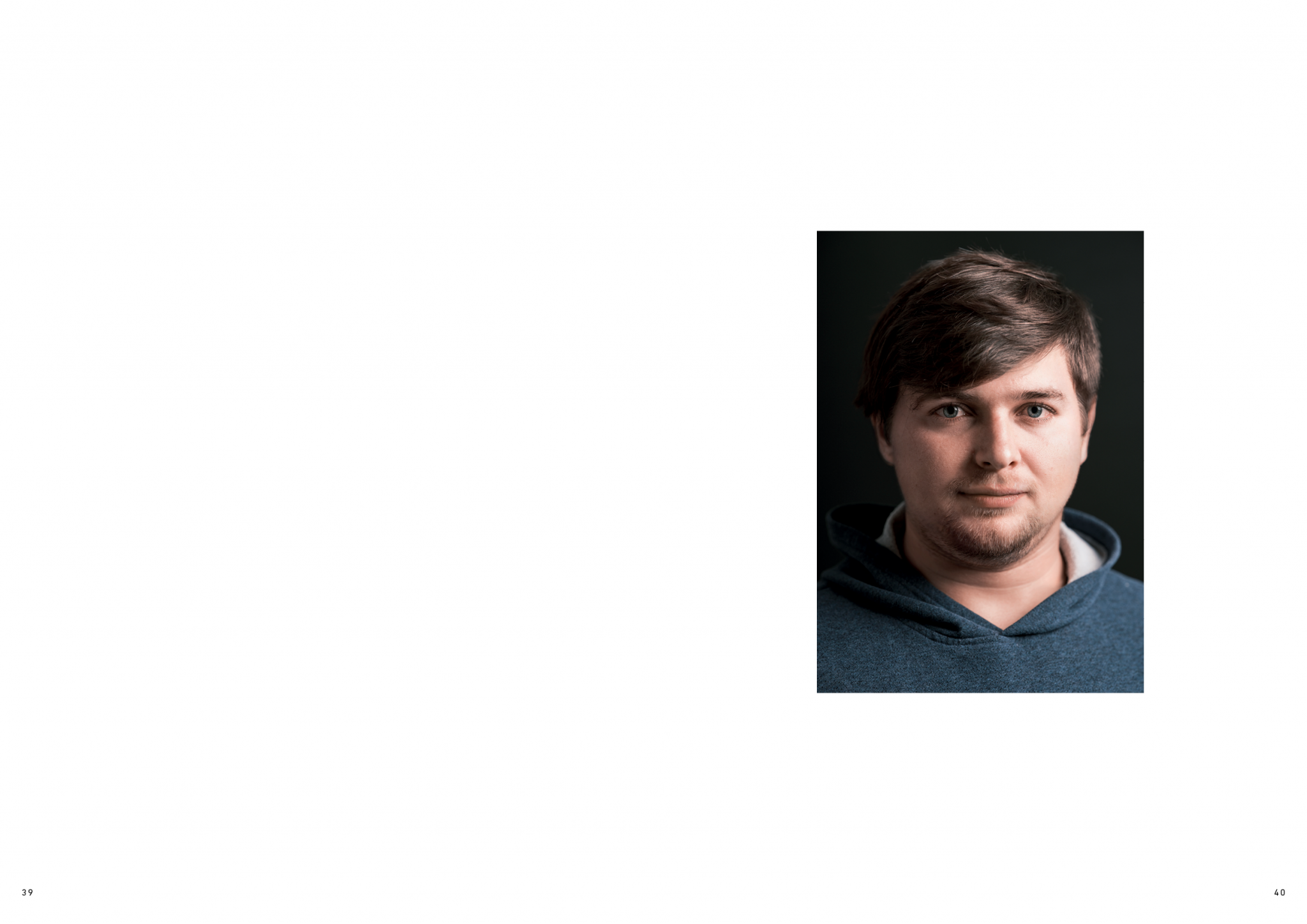
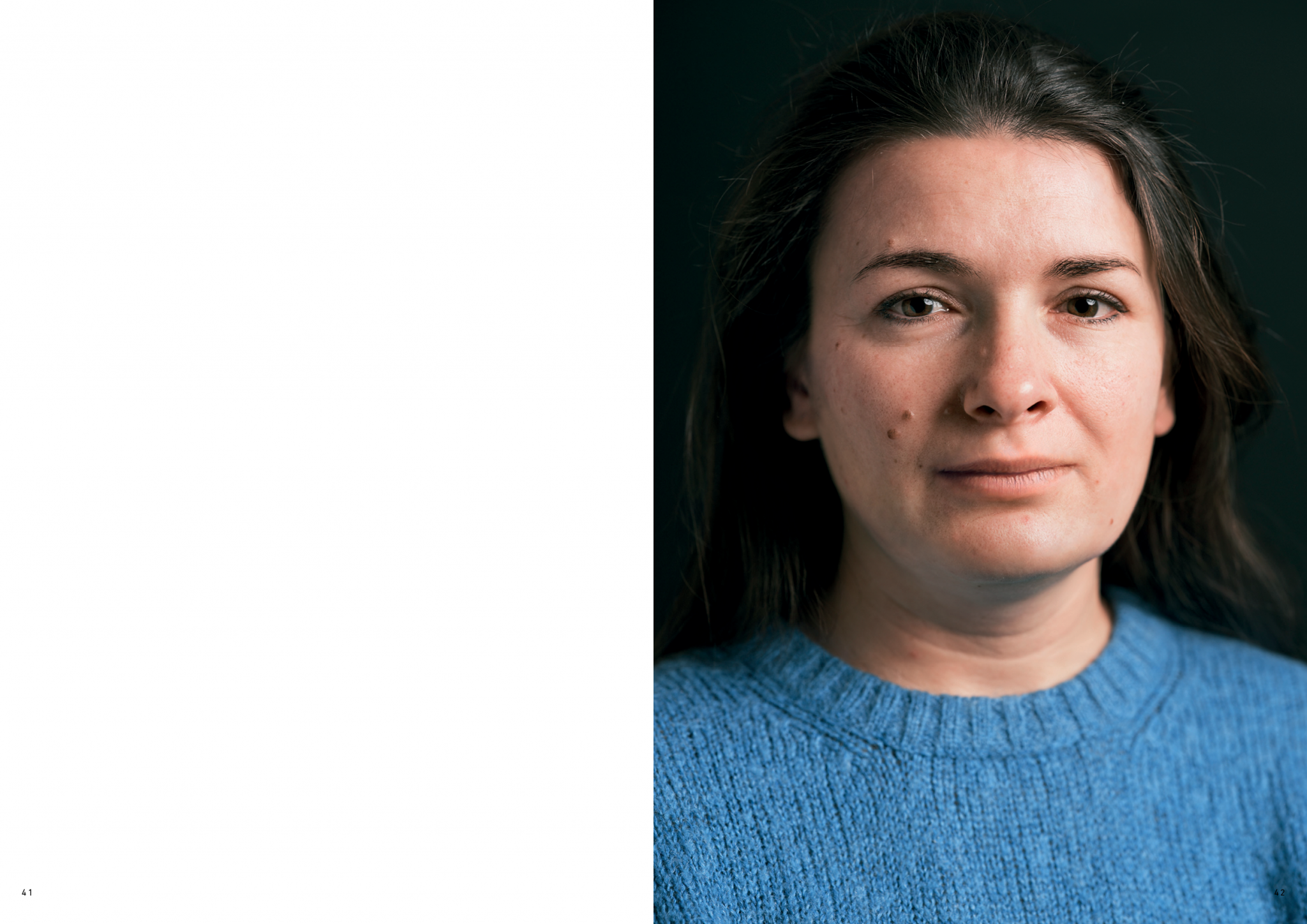
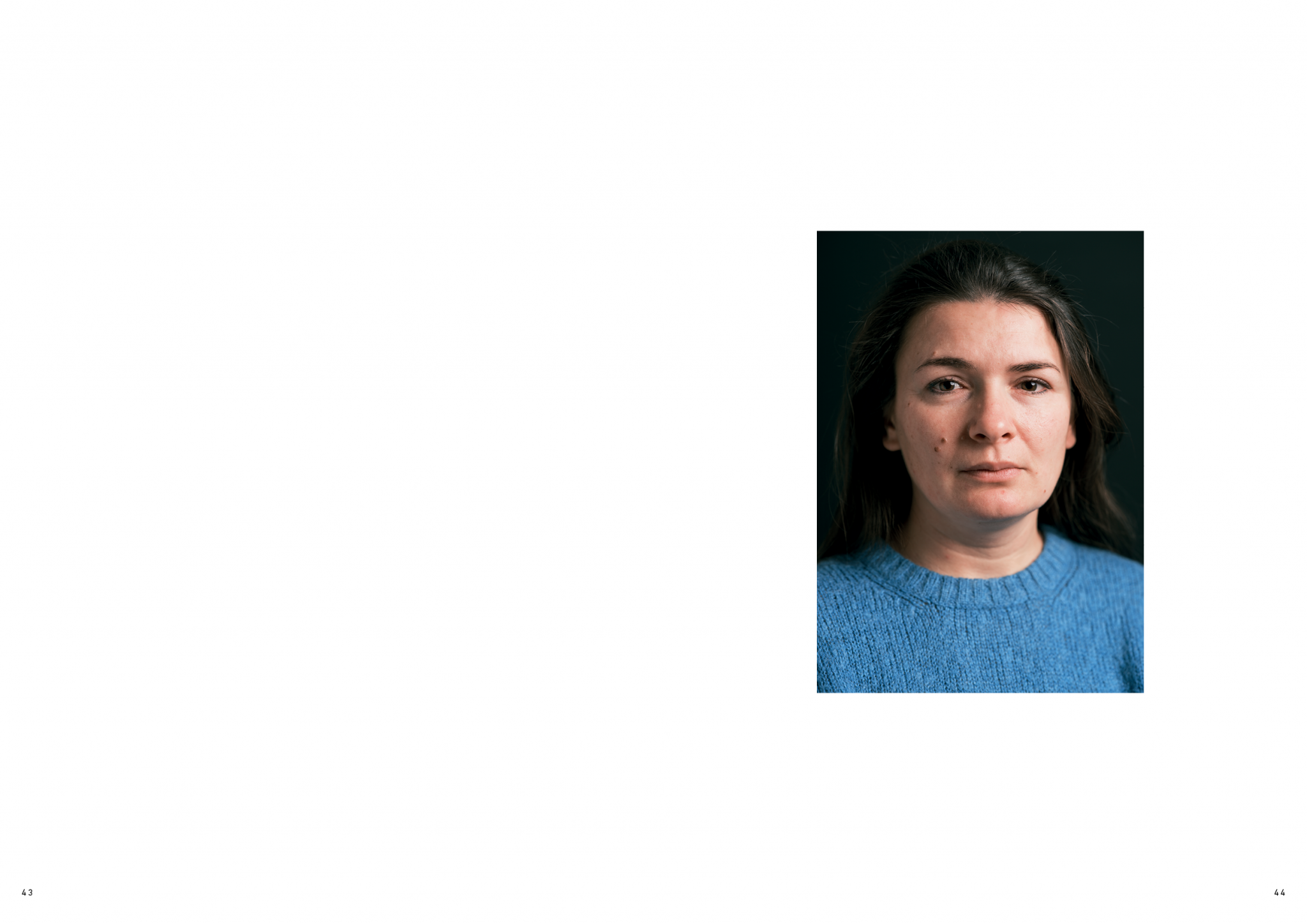
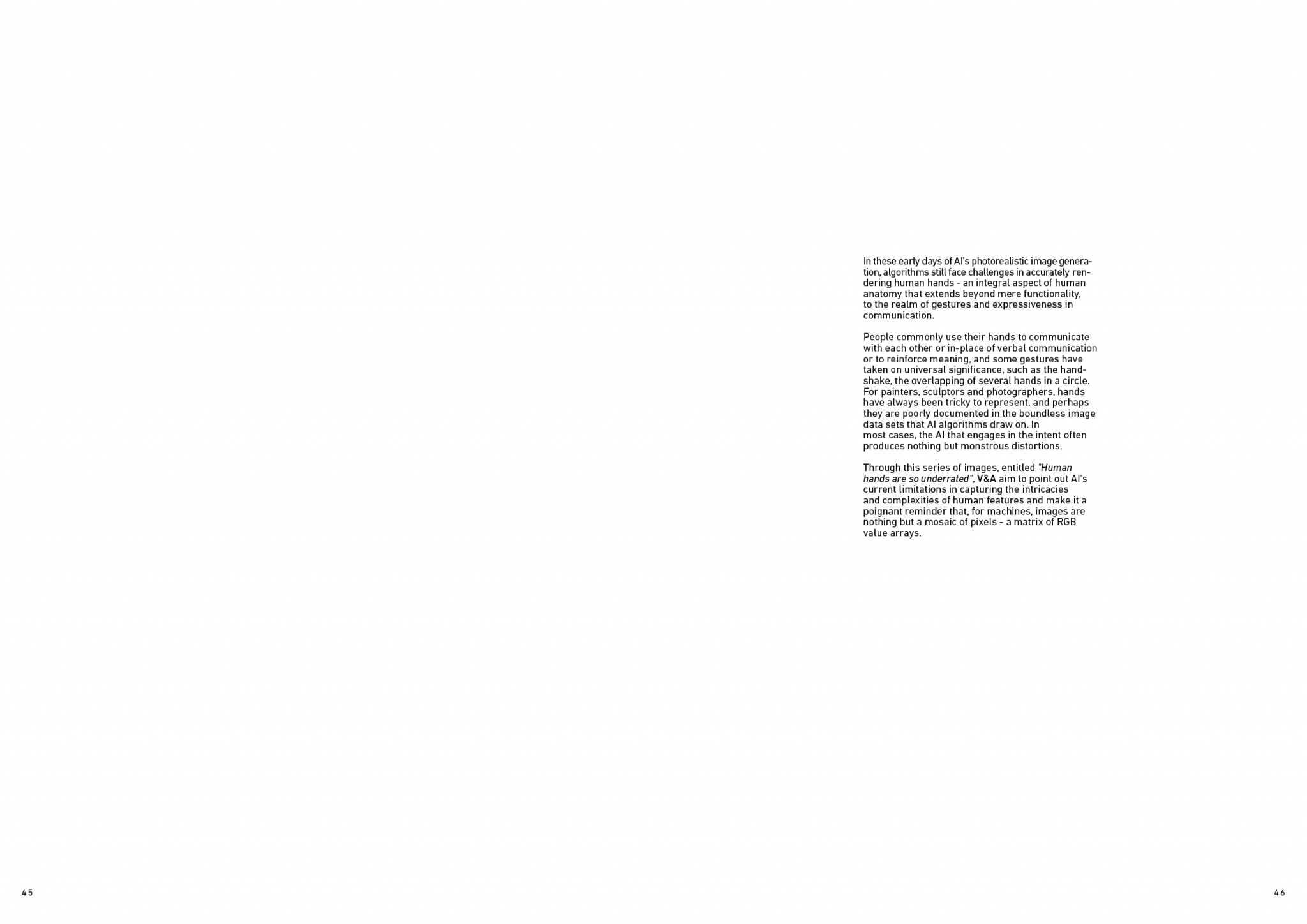
In these early days of AI’s photorealistic image generation, algorithms still face challenges in accurately rendering human hands – an integral aspect of human anatomy that extends beyond mere functionality, to the realm of gestures and expressiveness in communication. People commonly use their hands to communicate with each other or in-place of verbal communication or to reinforce meaning, and some gestures have taken on universal significance, such as the handshake, the overlapping of several hands in a circle. For painters, sculptors and photographers, hands have always been tricky to represent, and perhaps they are poorly documented in the boundless image data sets that AI algorithms draw on. In most cases, the AI that engages in the intent often produces nothing but monstrous distortions. Through this series of images, entitled “Human hands are so underrated”, V&A aim to point out AI’s current limitations in capturing the intricacies and complexities of human features and make it a poignant reminder that, for machines, images are nothing but a mosaic of pixels – a matrix of RGB value arrays.
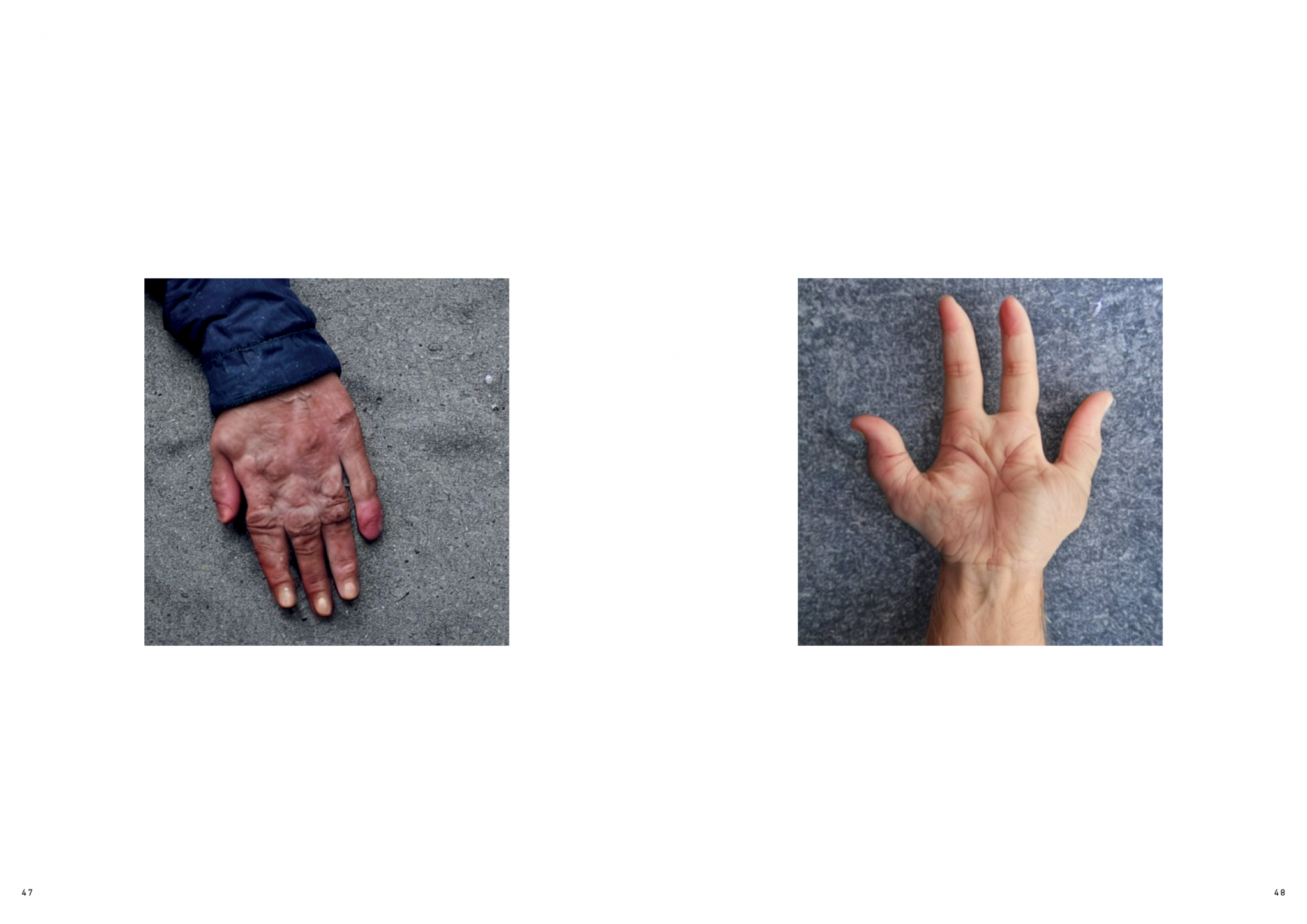

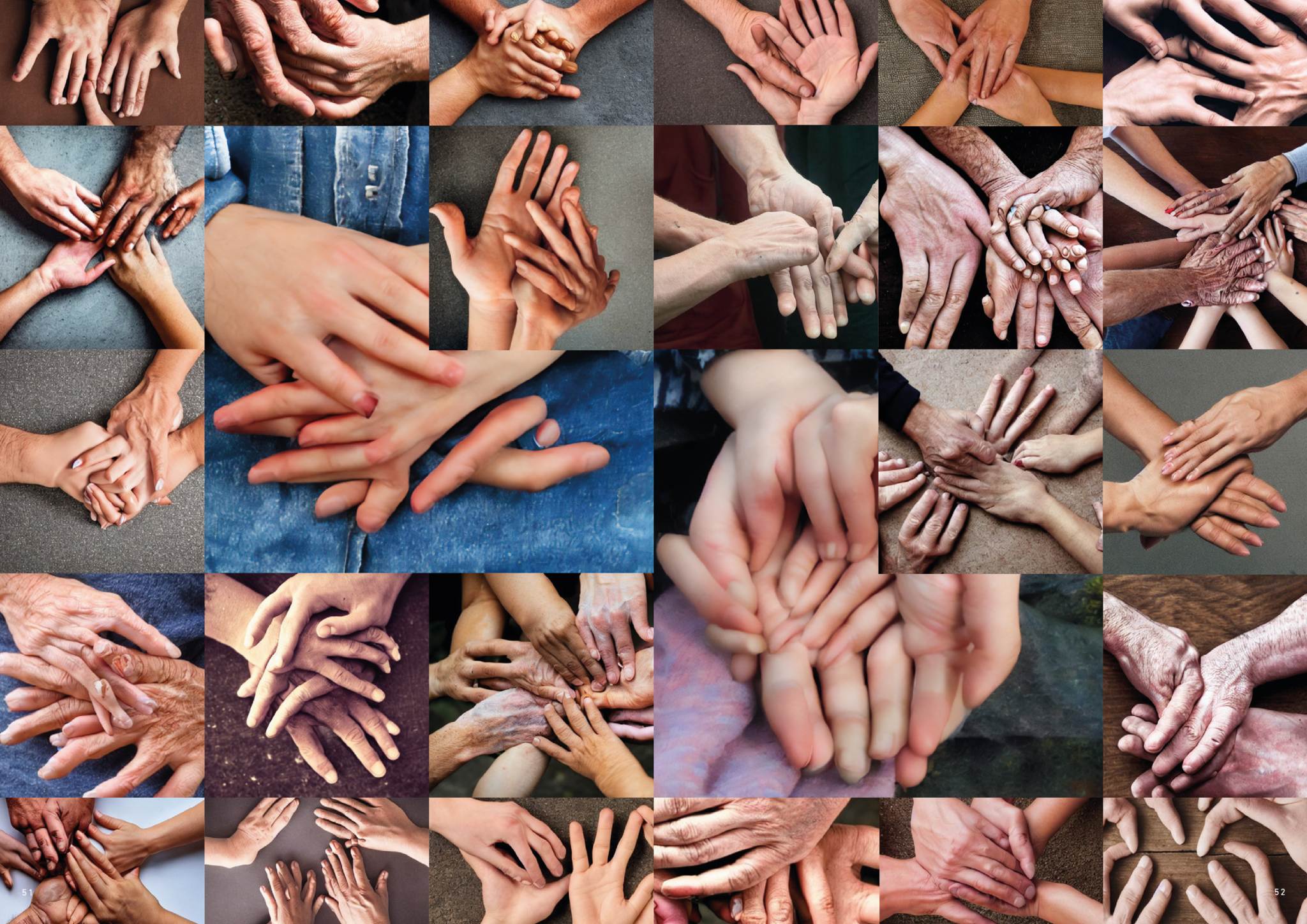
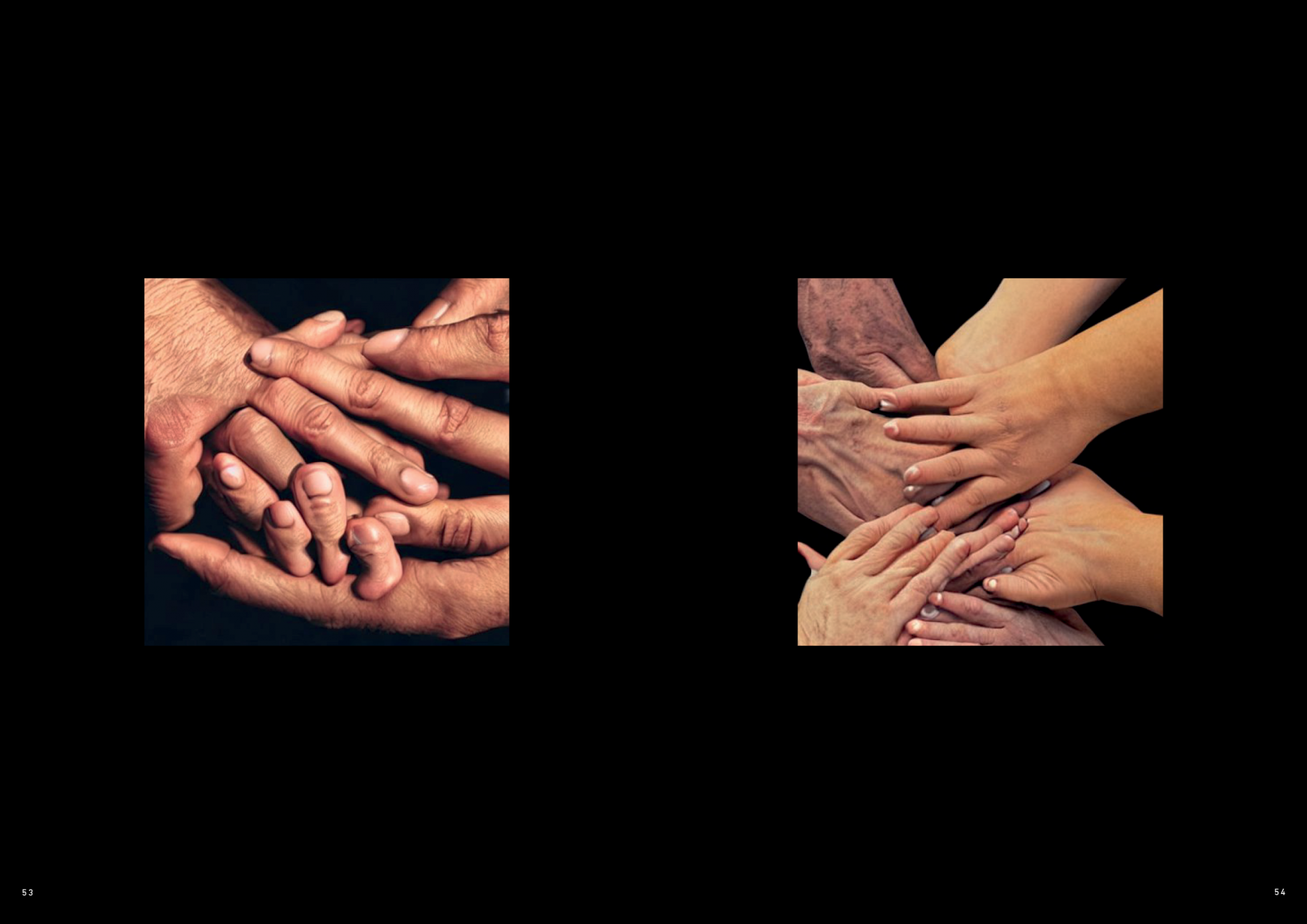
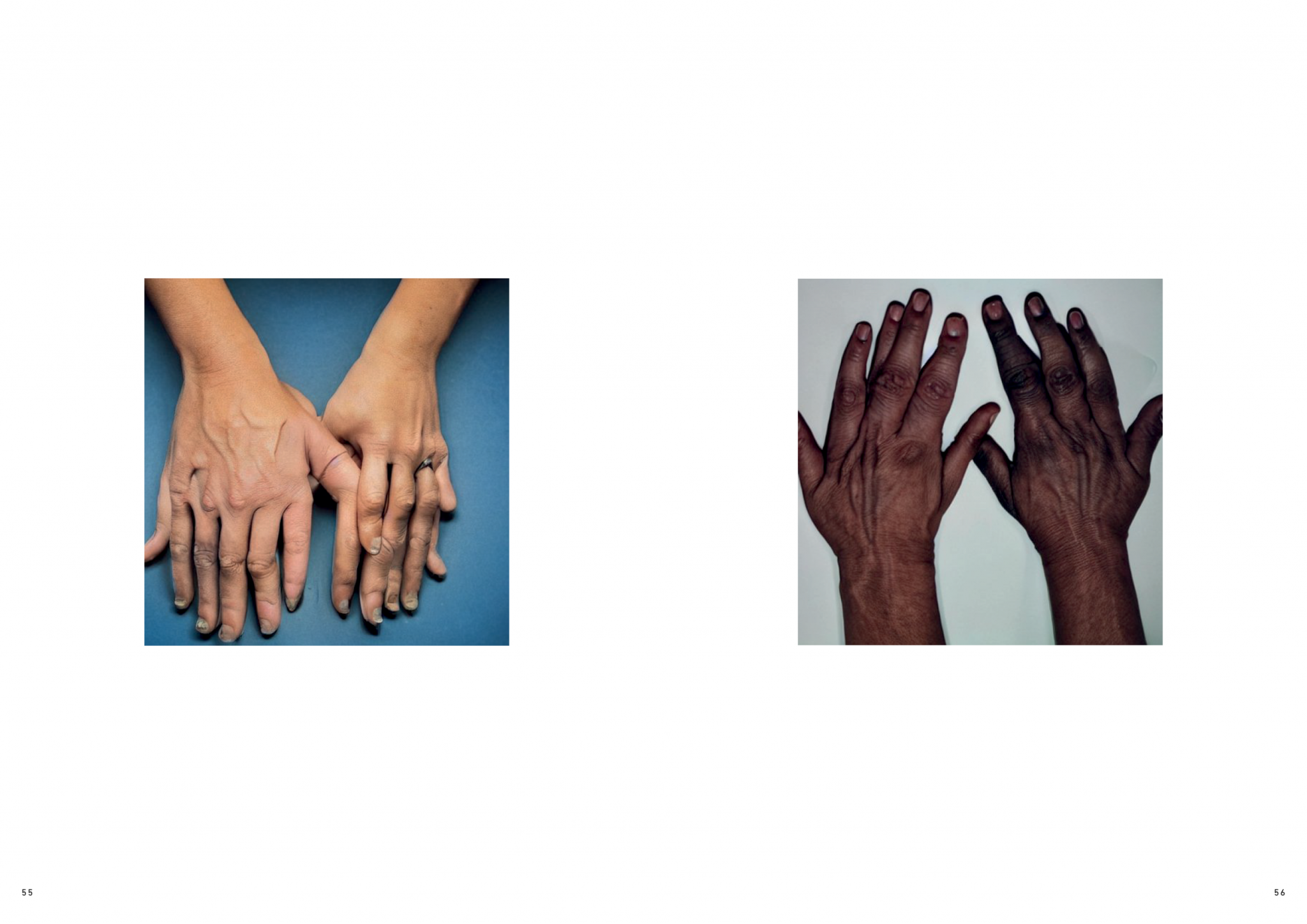
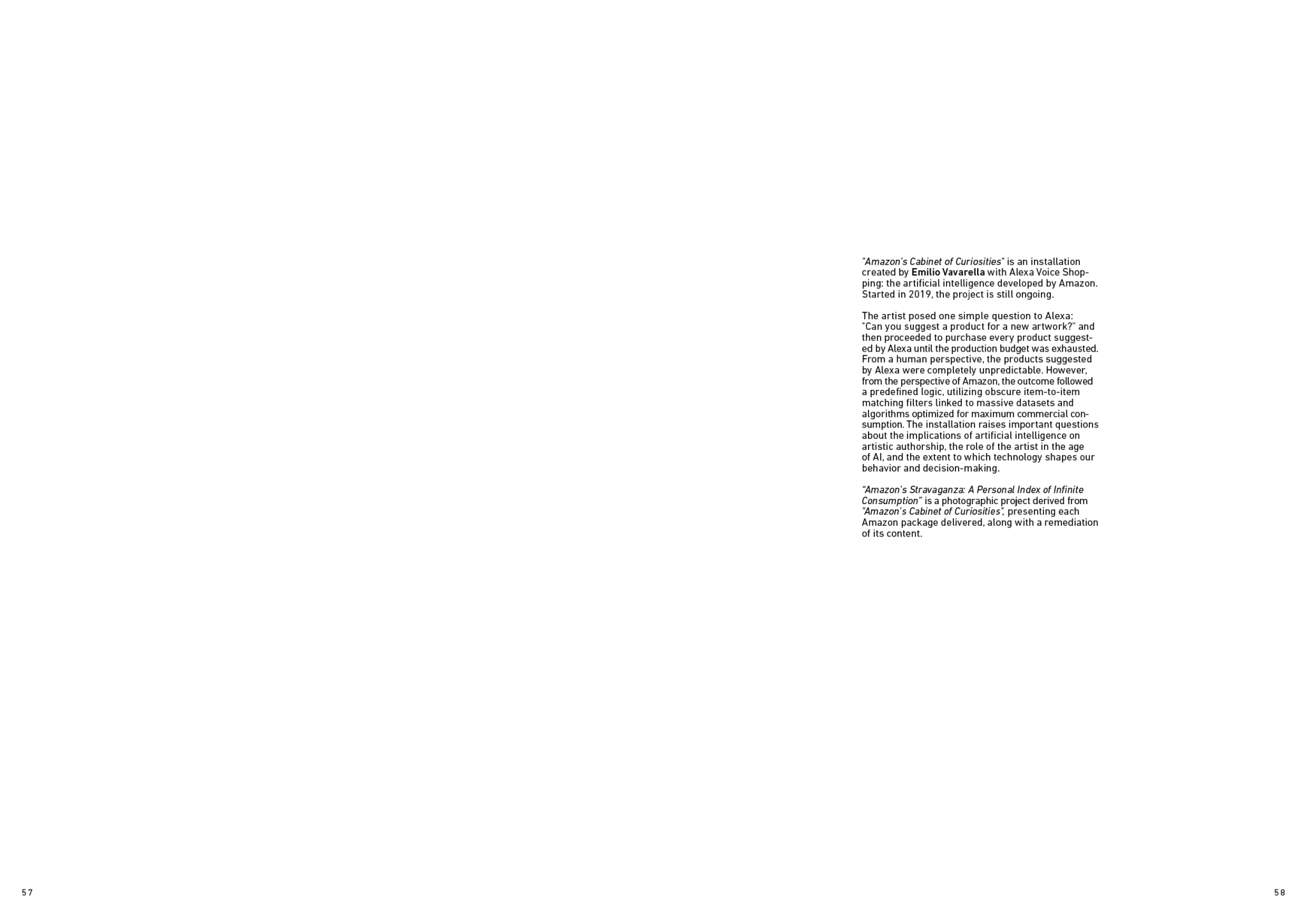
“Amazon’s Cabinet of Curiosities” is an installation created by Emilio Vavarella with Alexa Voice Shopping: the artificial intelligence developed by Amazon. Started in 2019, the project is still ongoing. The artist posed one simple question to Alexa: “Can you suggest a product for a new artwork?” and then proceeded to purchase every product suggested by Alexa until the production budget was exhausted. From a human perspective, the products suggested by Alexa were completely unpredictable. However, from the perspective of Amazon, the outcome followed a predefined logic, utilizing obscure item-to-item matching filters linked to massive datasets and algorithms optimized for maximum commercial consumption. The installation raises important questions about the implications of artificial intelligence on artistic authorship, the role of the artist in the age of AI, and the extent to which technology shapes our behavior and decision-making. “Amazon’s Stravaganza: A Personal Index of Infinite Consumption” is a photographic project derived from “Amazon’s Cabinet of Curiosities”, presenting each Amazon package delivered, along with a remediation of its content.
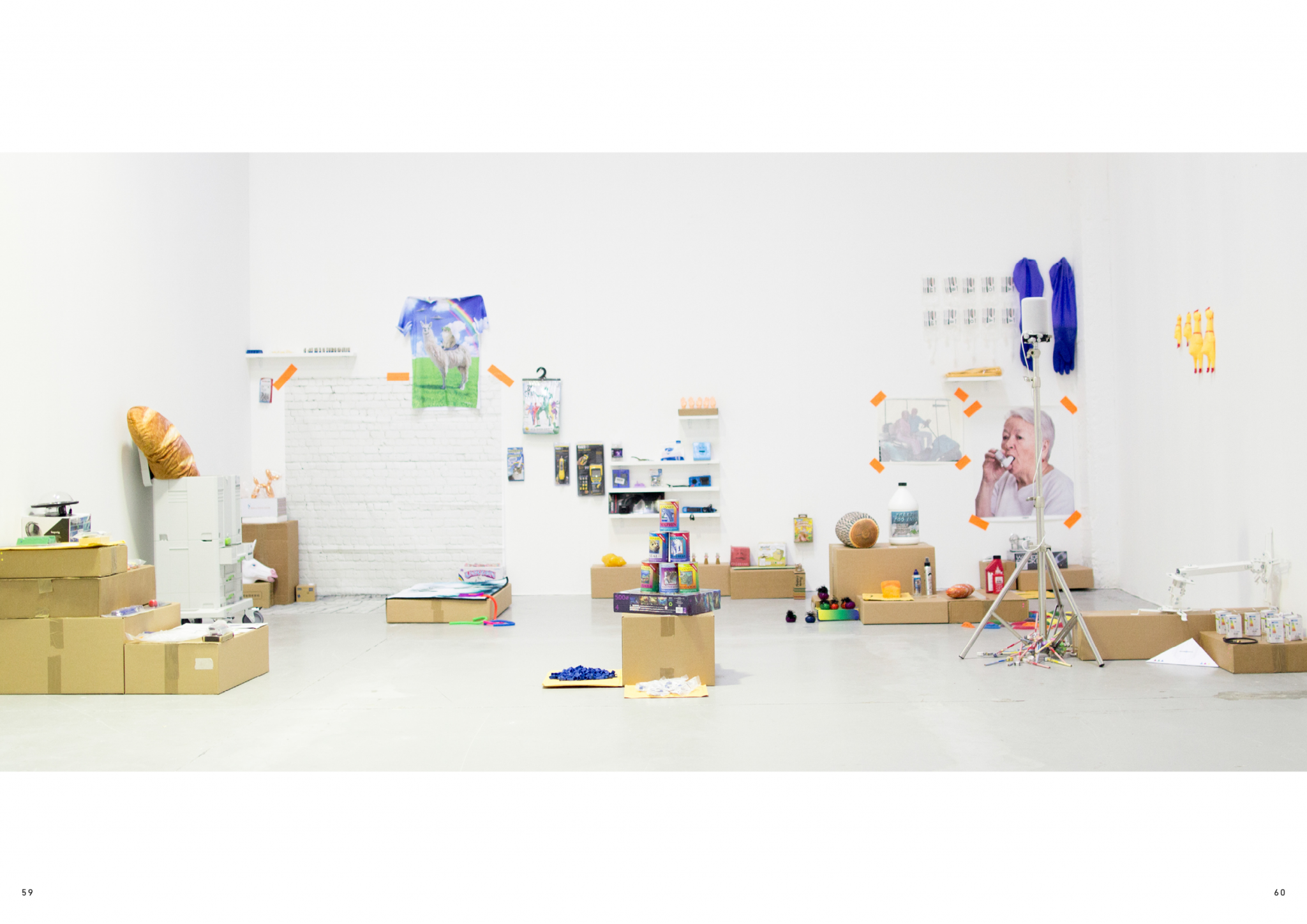
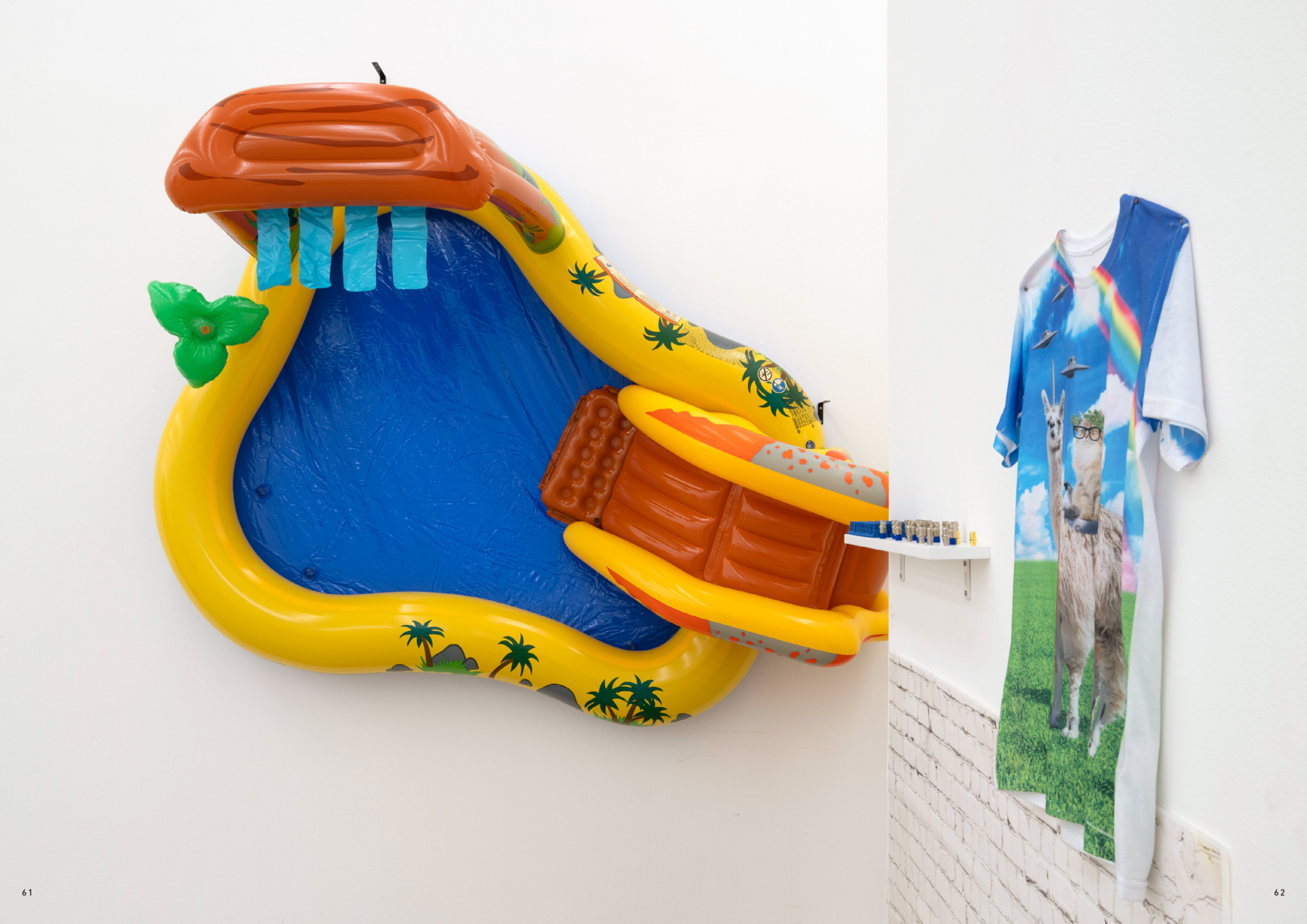
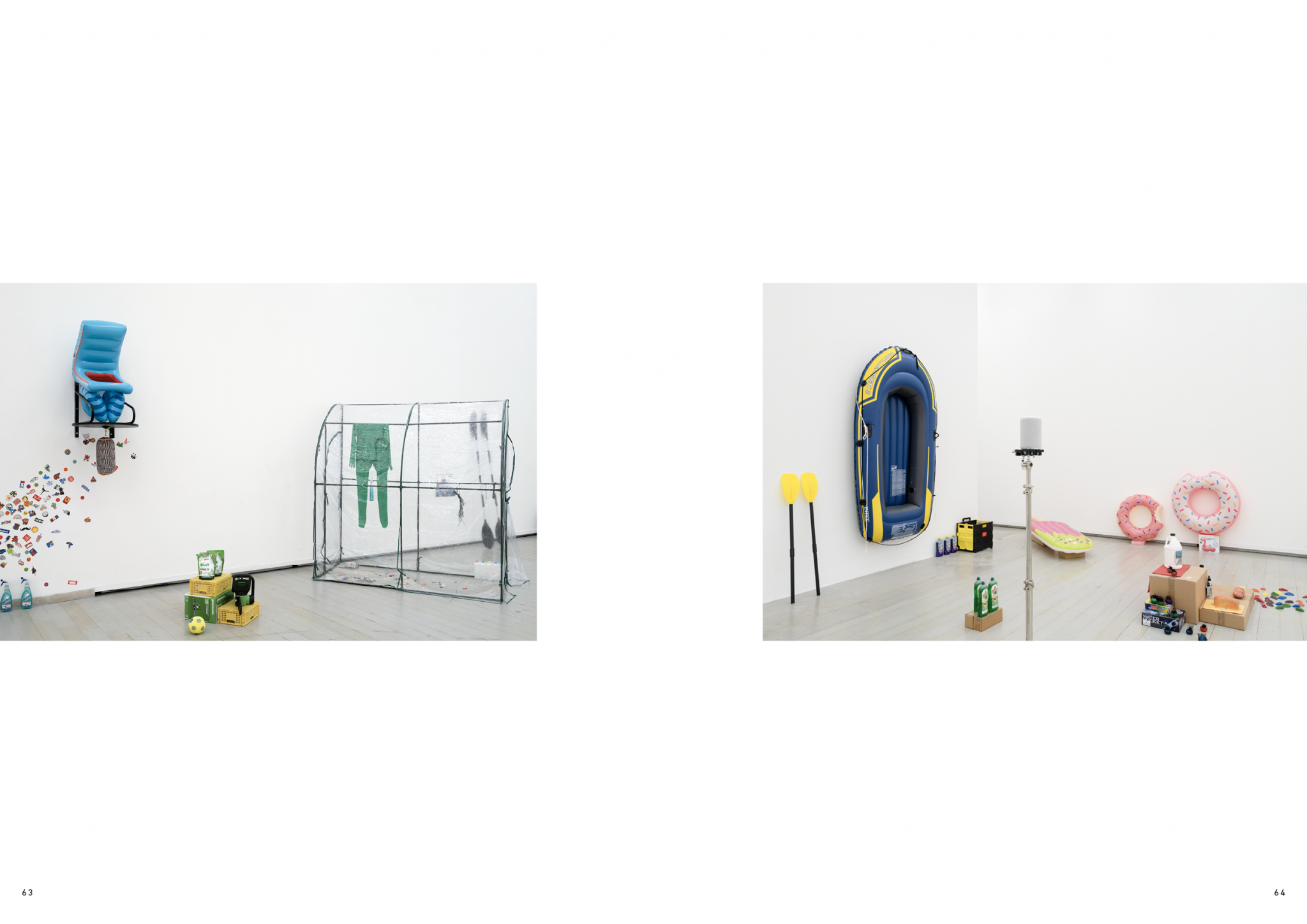
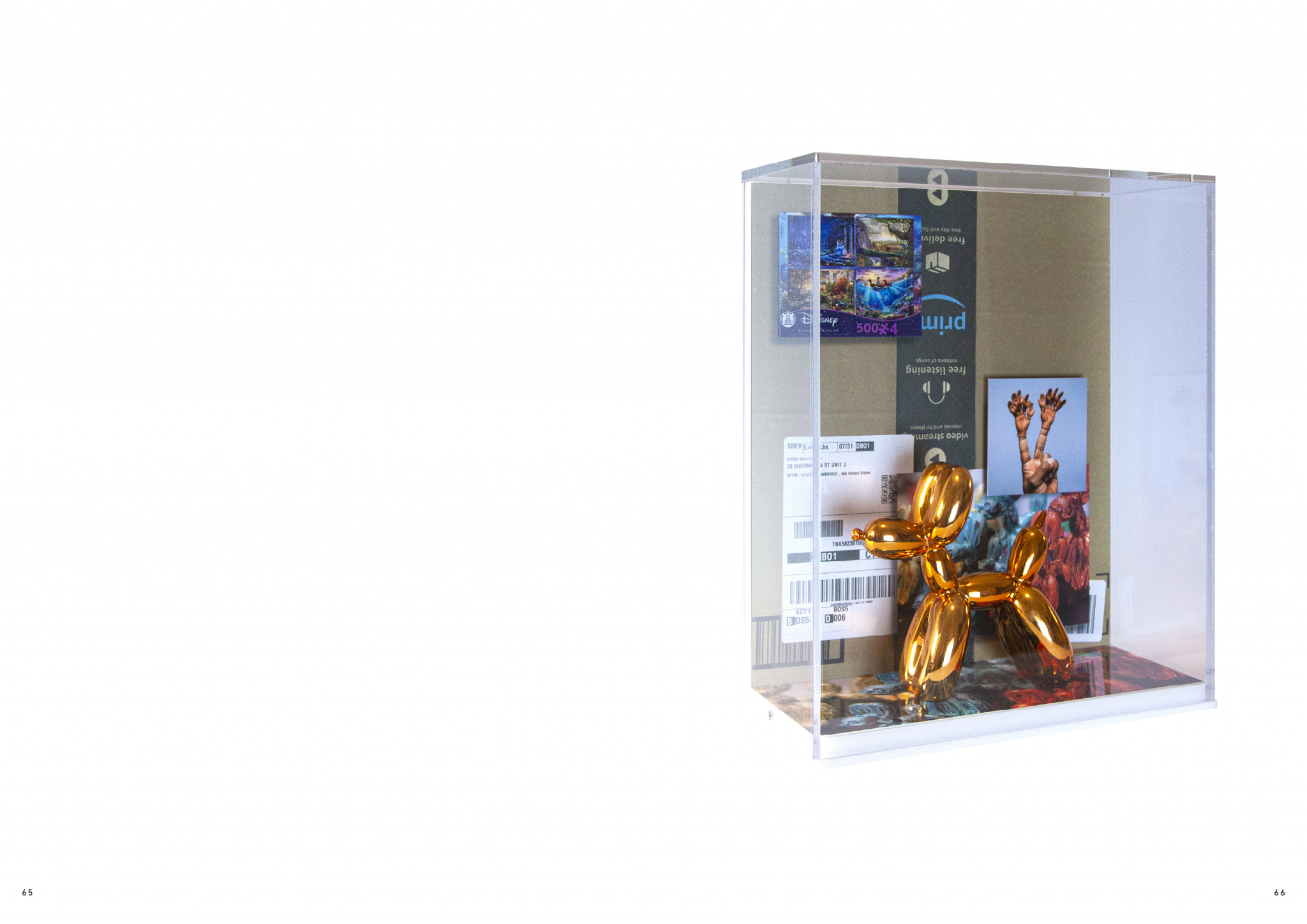
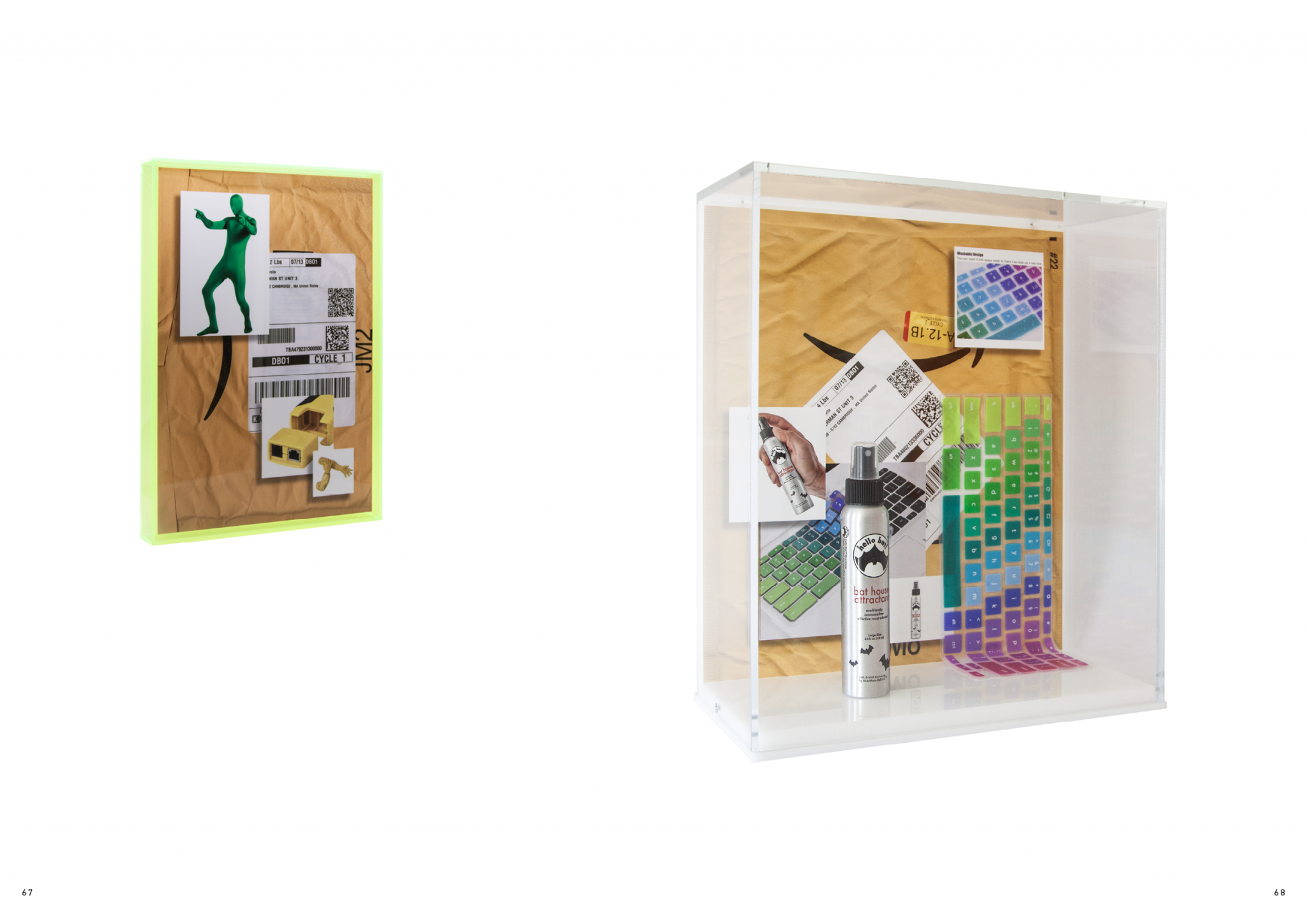
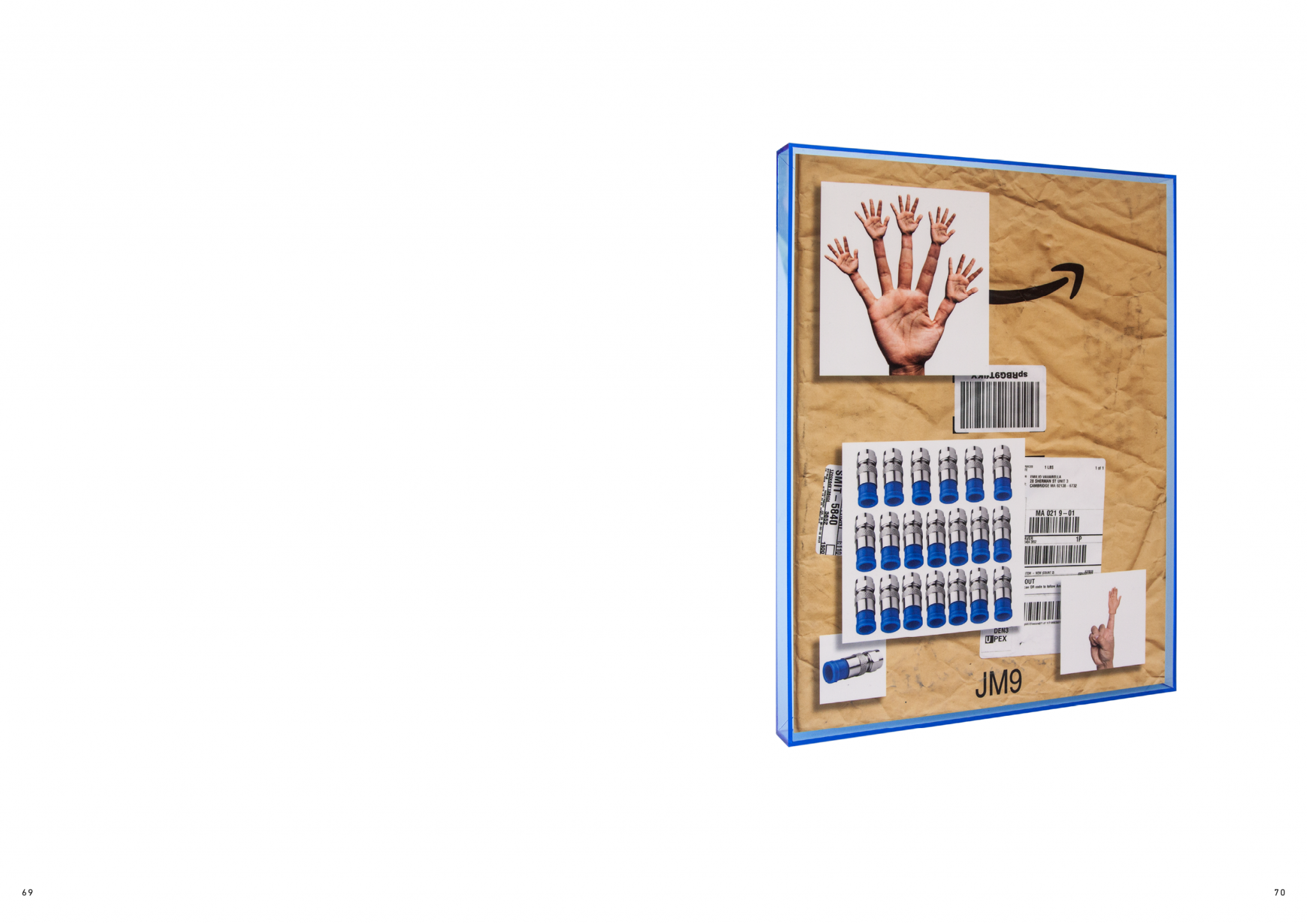
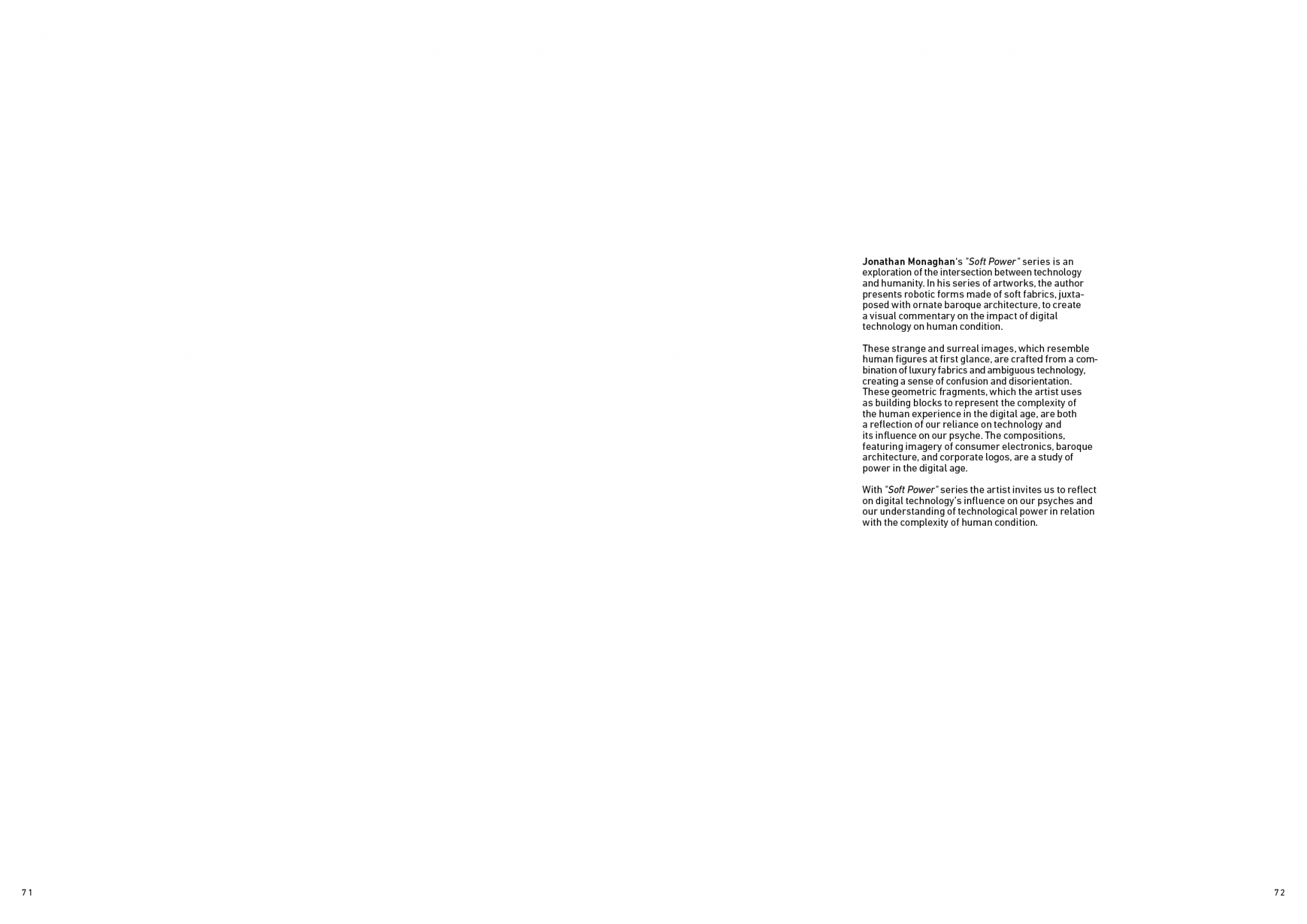
Jonathan Monaghan‘s”Soft Power” series is an exploration of the intersection between technology and humanity. In his series of artworks, the author presents robotic forms made of soft fabrics, juxtaposed with ornate baroque architecture, to create a visual commentary on the impact of digital technology on human condition. These strange and surreal images, which resemble human figures at first glance, are crafted from a combination of luxury fabrics and ambiguous technology, creating a sense of confusion and disorientation. These geometric fragments, which the artist uses as building blocks to represent the complexity of the human experience in the digital age, are both a reflection of our reliance on technology and its influence on our psyche. The compositions, featuring imagery of consumer electronics, baroque architecture, and corporate logos, are a study of power in the digital age. With “Soft Power” series the artist invites us to reflect on digital technology’s influence on our psyches and our understanding of technological power in relation with the complexity of human condition.
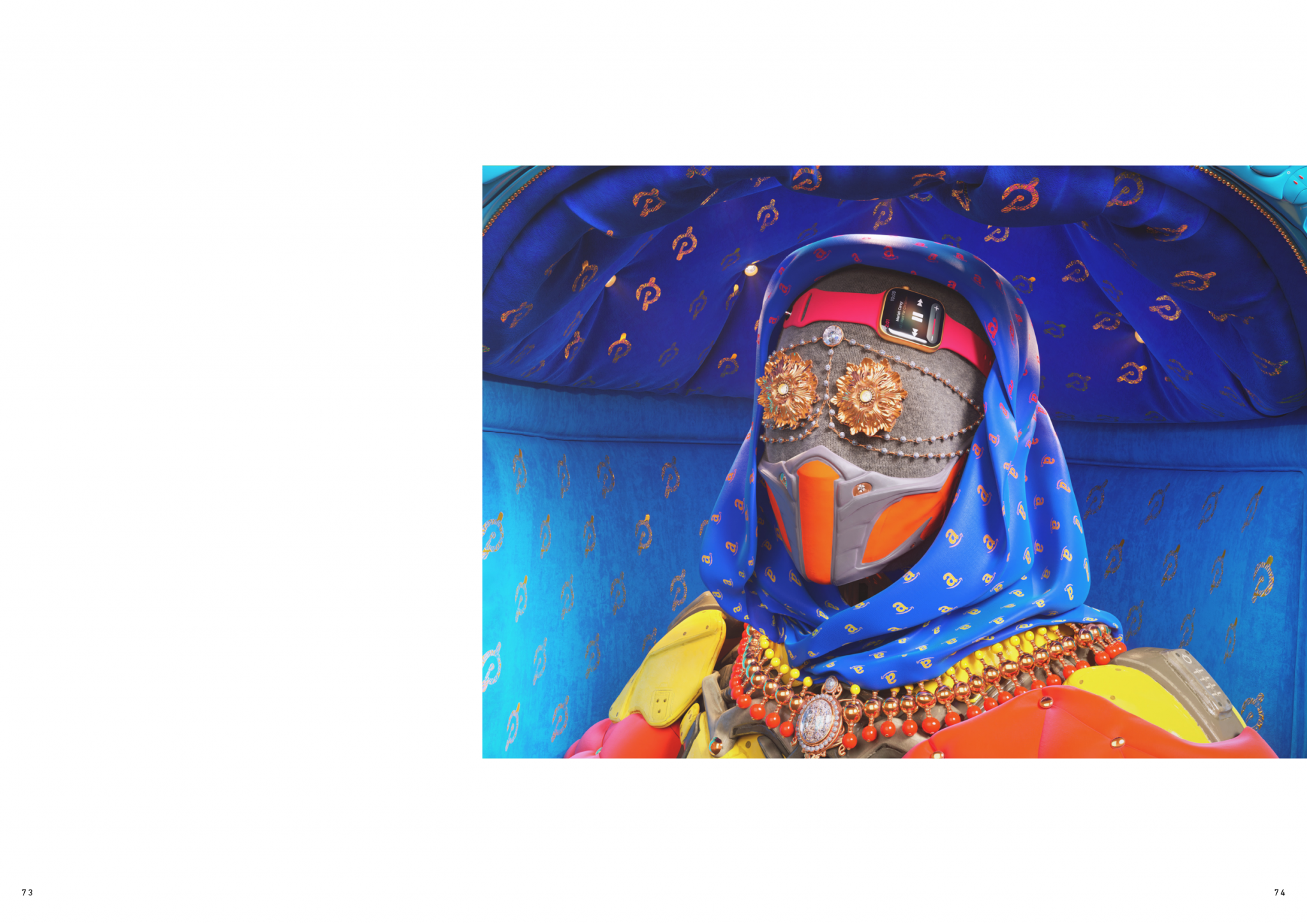
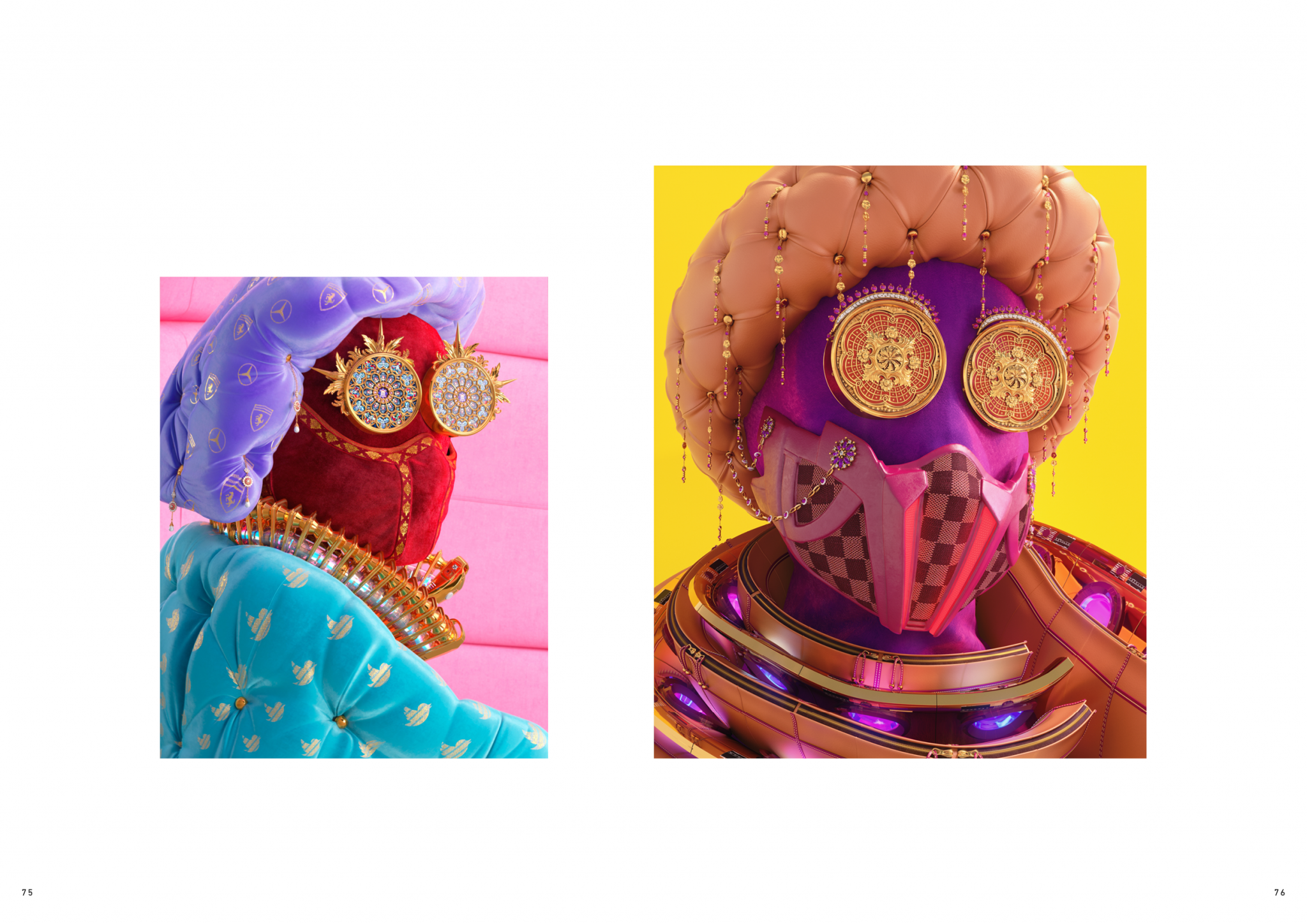
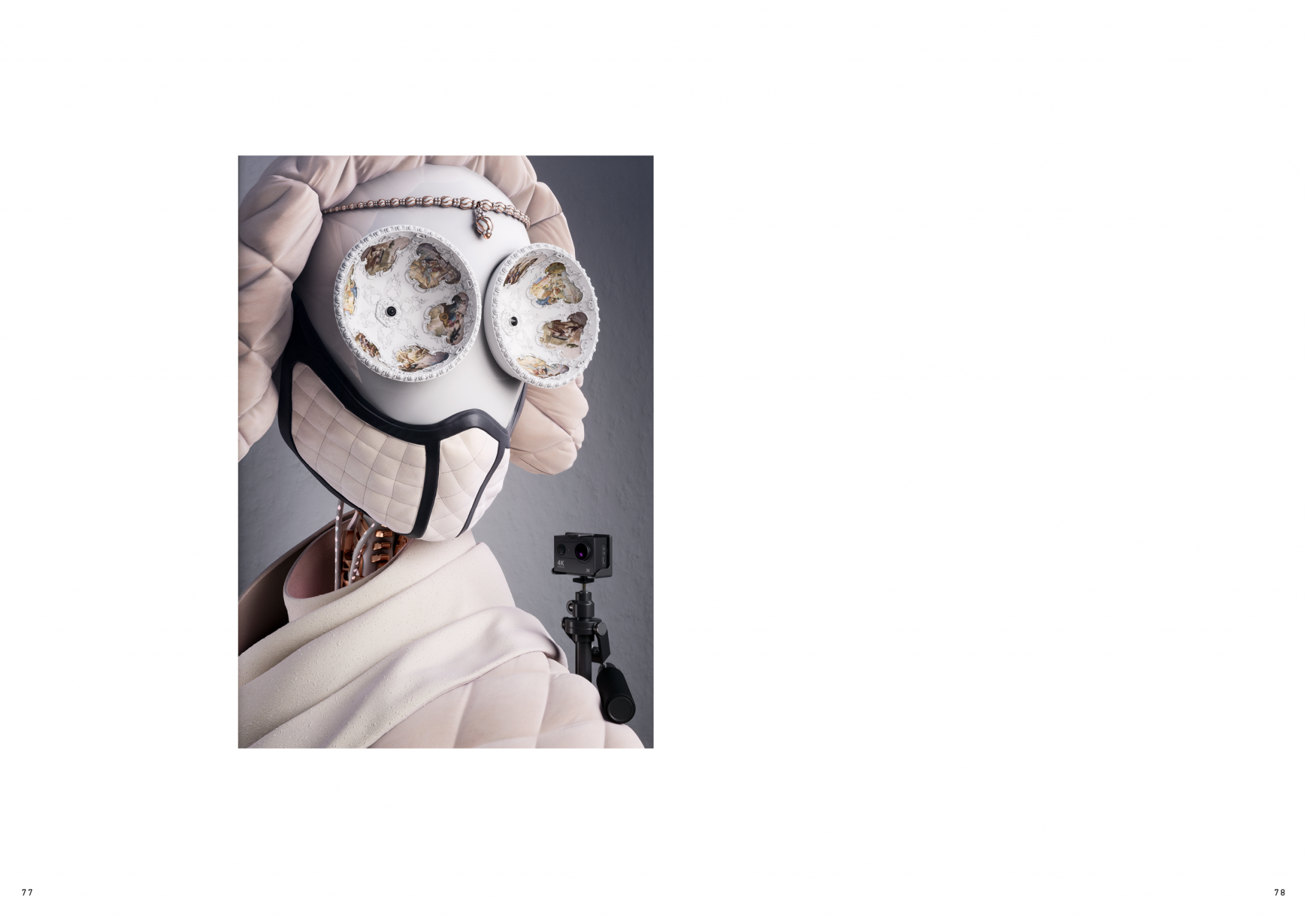
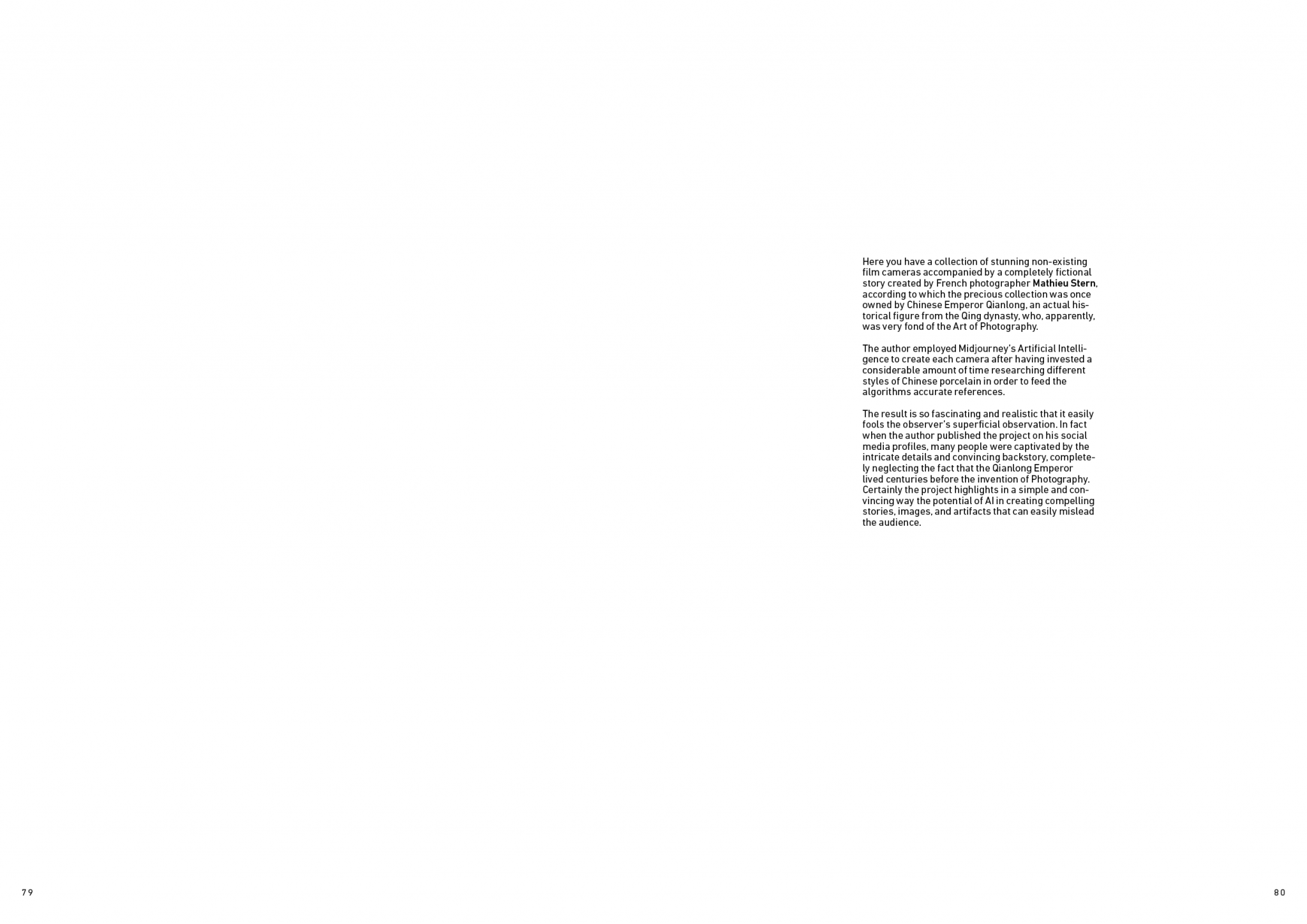
Here you have a collection of stunning non-existing film cameras accompanied by a completely fictional story created by French photographer Mathieu Stern, according to which the precious collection was once owned by Chinese Emperor Qianlong, an actual historical figure from the Qing dynasty, who, apparently, was very fond of the Art of Photography. The author employed Midjourney’s Artificial Intelligence to create each camera after having invested a considerable amount of time researching different styles of Chinese porcelain in order to feed the algorithms accurate references. The result is so fascinating and realistic that it easily fools the observer’s superficial observation. In fact when the author published the project on his social media profiles, many people were captivated by the intricate details and convincing backstory, completely neglecting the fact that the Qianlong Emperor lived centuries before the invention of Photography. Certainly the project highlights in a simple and convincing way the potential of AI in creating compelling stories, images, and artifacts that can easily mislead the audience.
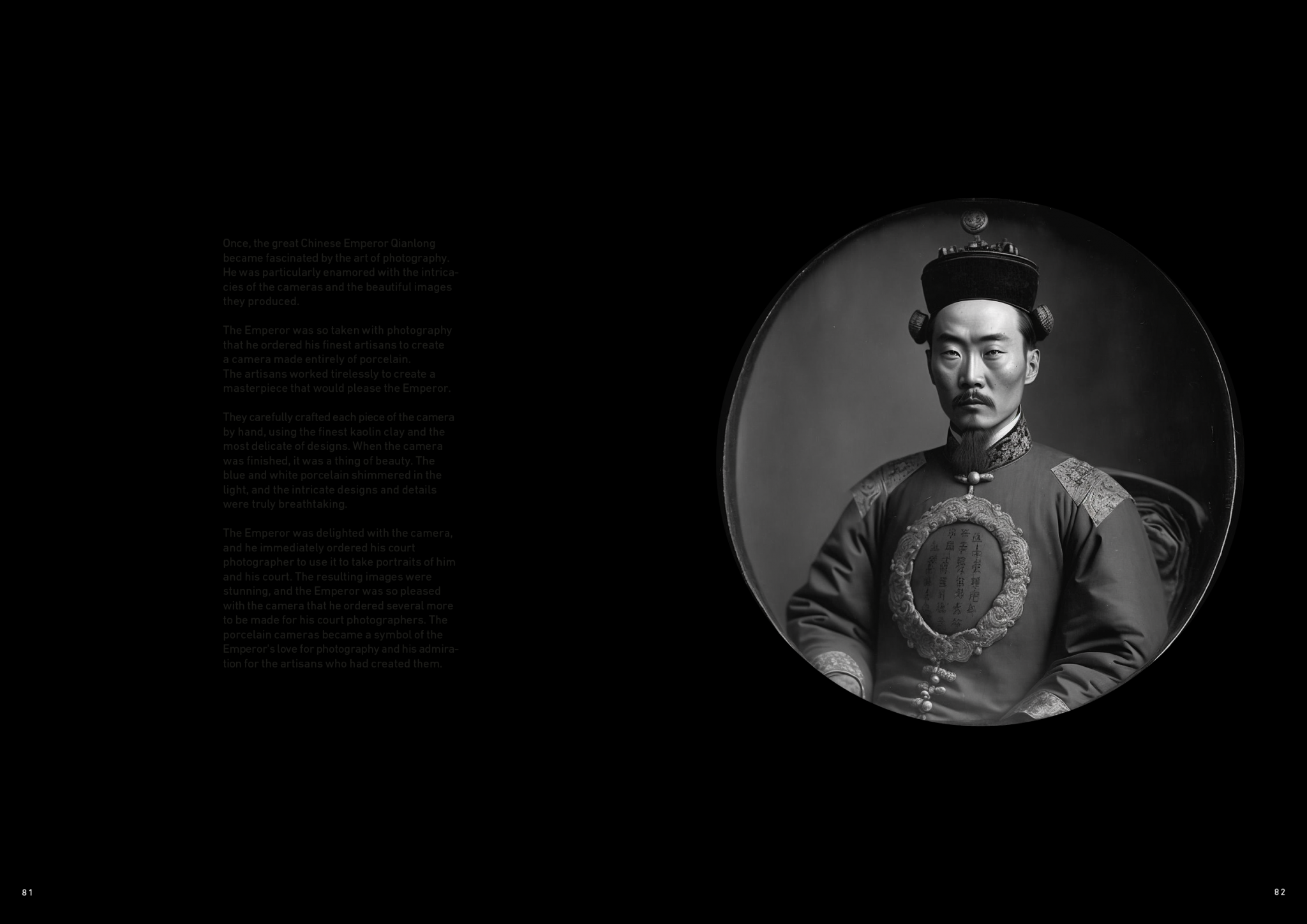
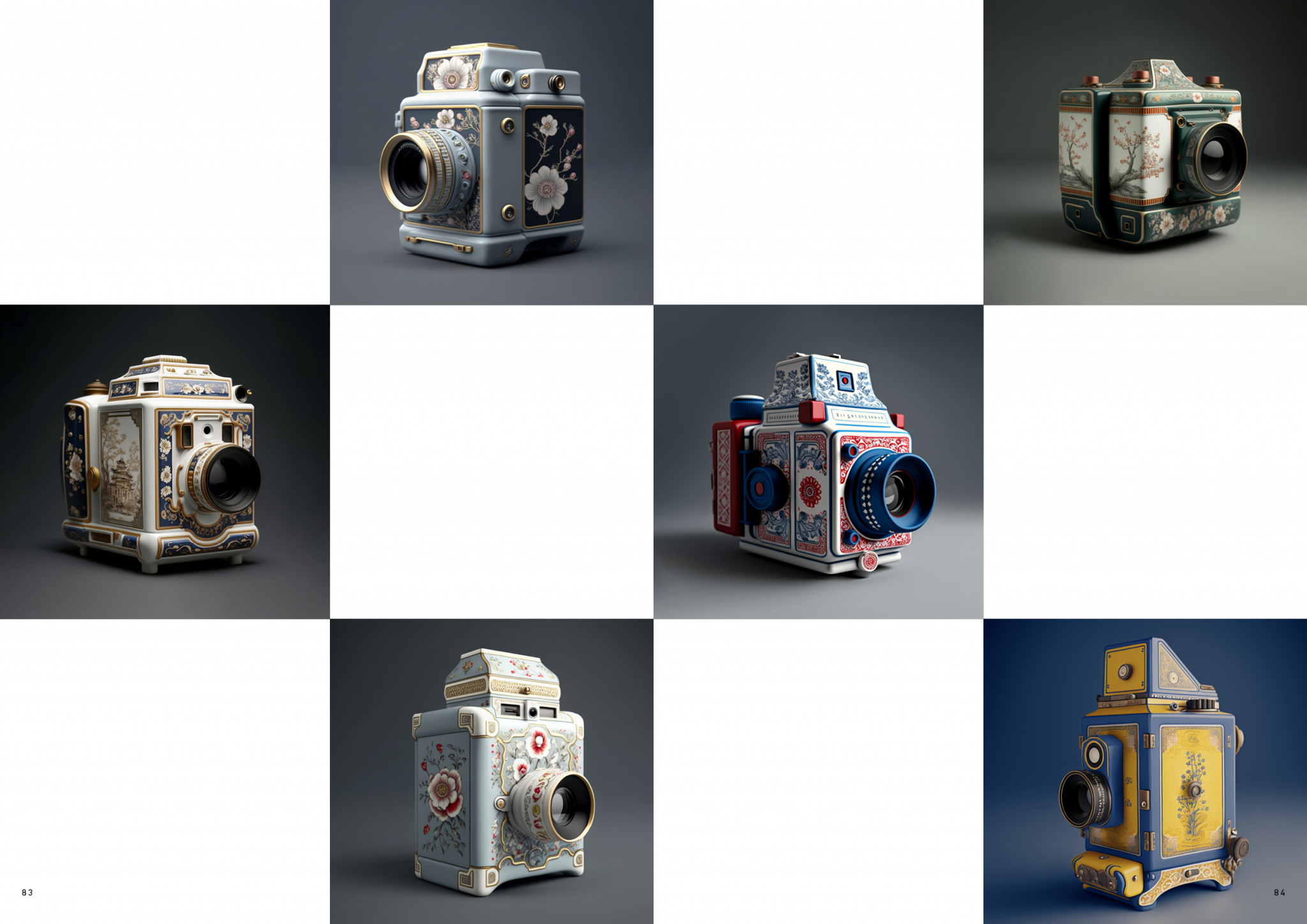
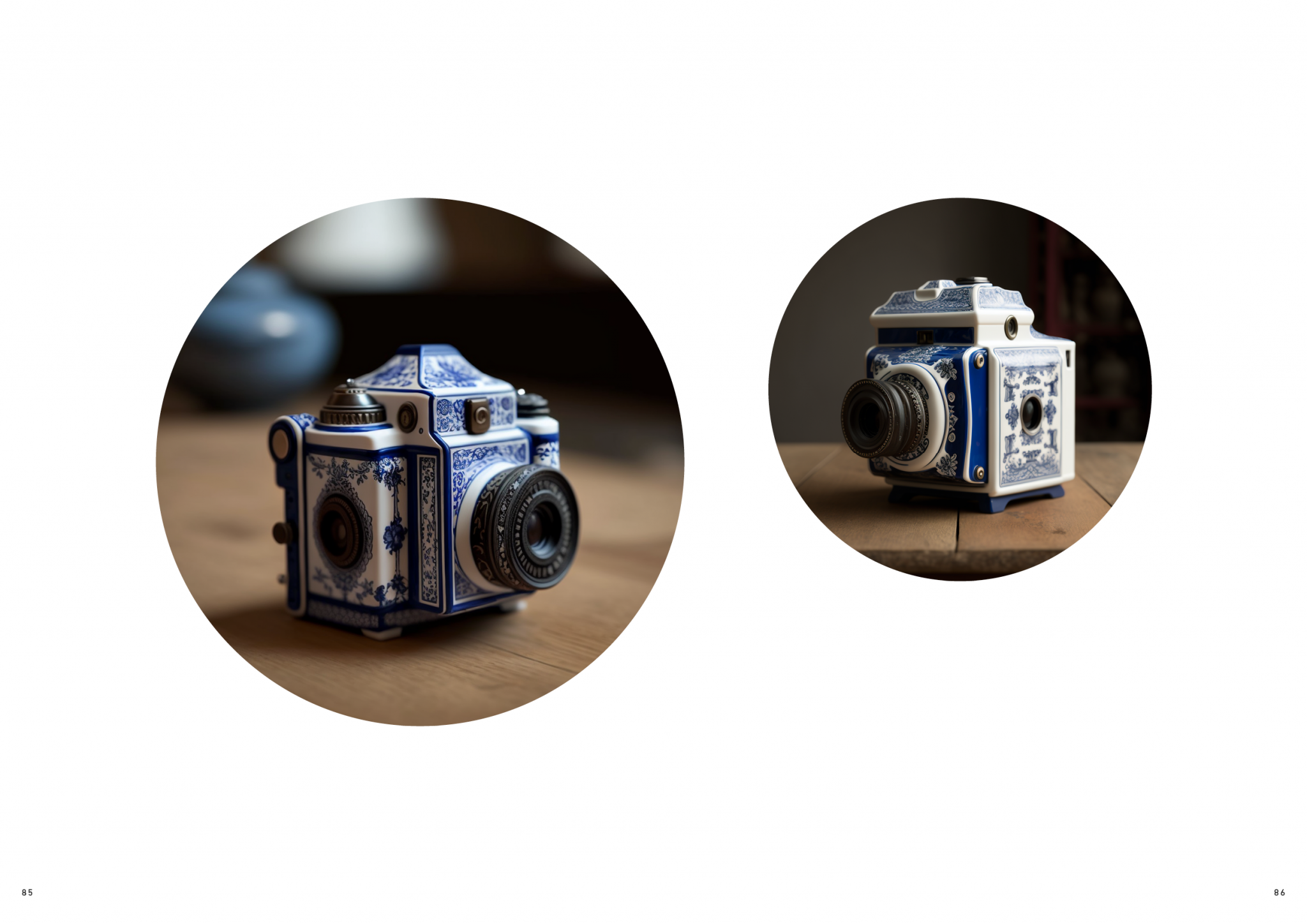
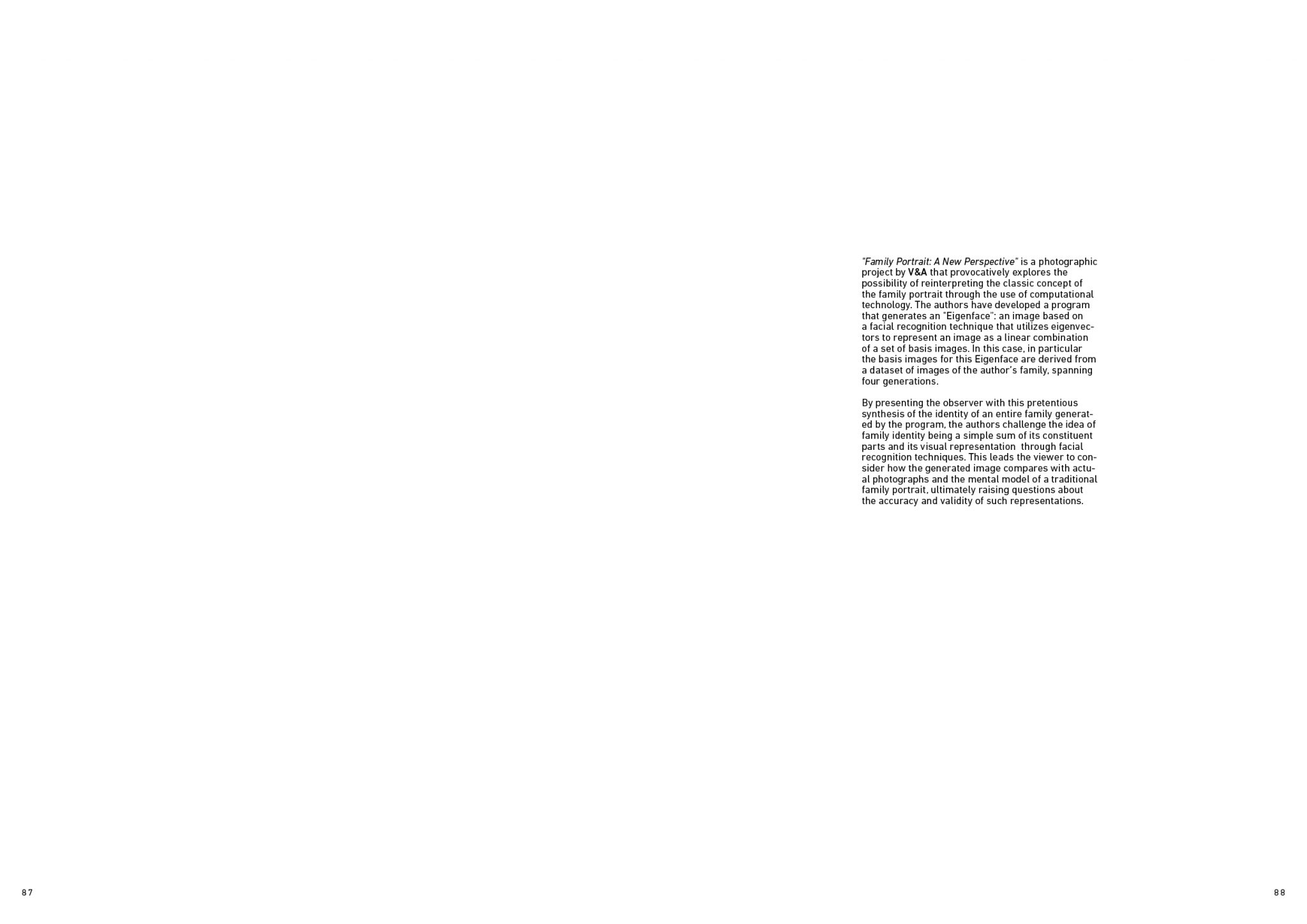
“Family Portrait: A New Perspective” is a photographic project by V&A that provocatively explores the possibility of reinterpreting the classic concept of the family portrait through the use of computational technology. The authors have developed a program that generates an “Eigenface”: an image based on a facial recognition technique that utilizes eigenvectors to represent an image as a linear combination of a set of basis images. In this case, in particular the basis images for this Eigenface are derived from a dataset of images of the author’s family, spanning four generations. By presenting the observer with this pretentious synthesis of the identity of an entire family generated by the program, the authors challenge the idea of family identity being a simple sum of its constituent parts and its visual representation through facial recognition techniques. This leads the viewer to consider how the generated image compares with actual photographs and the mental model of a traditional family portrait, ultimately raising questions about the accuracy and validity of such representations.
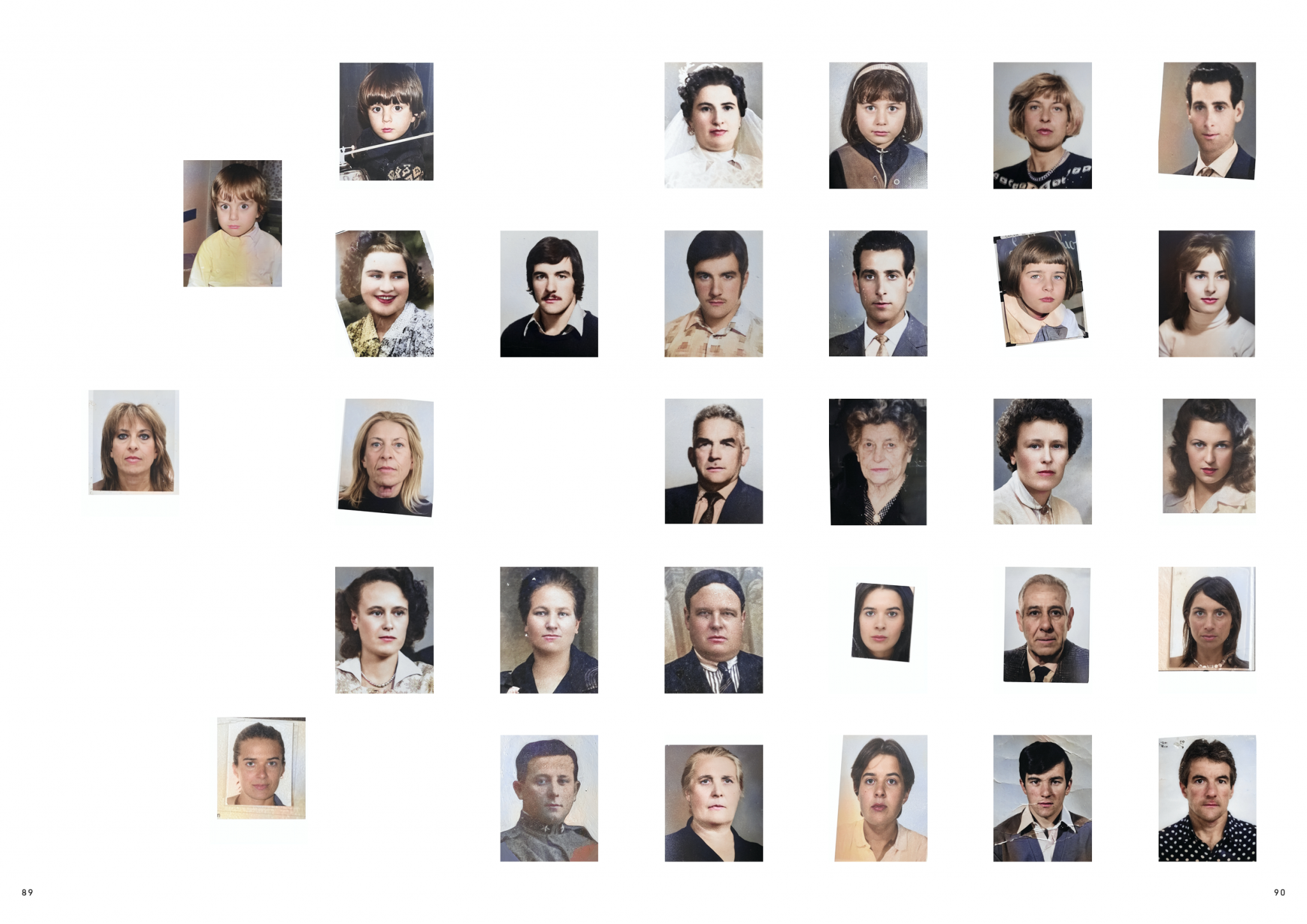
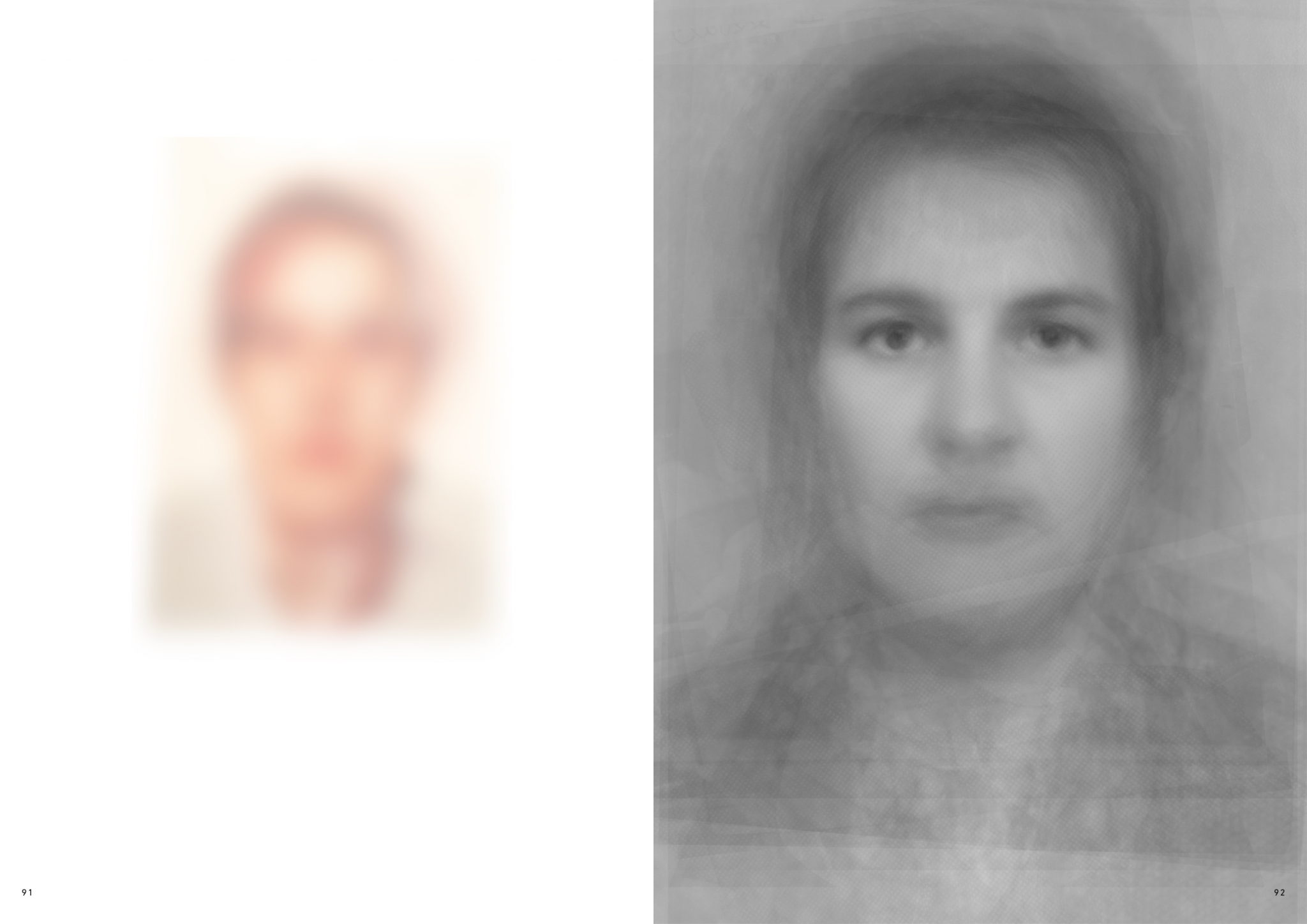
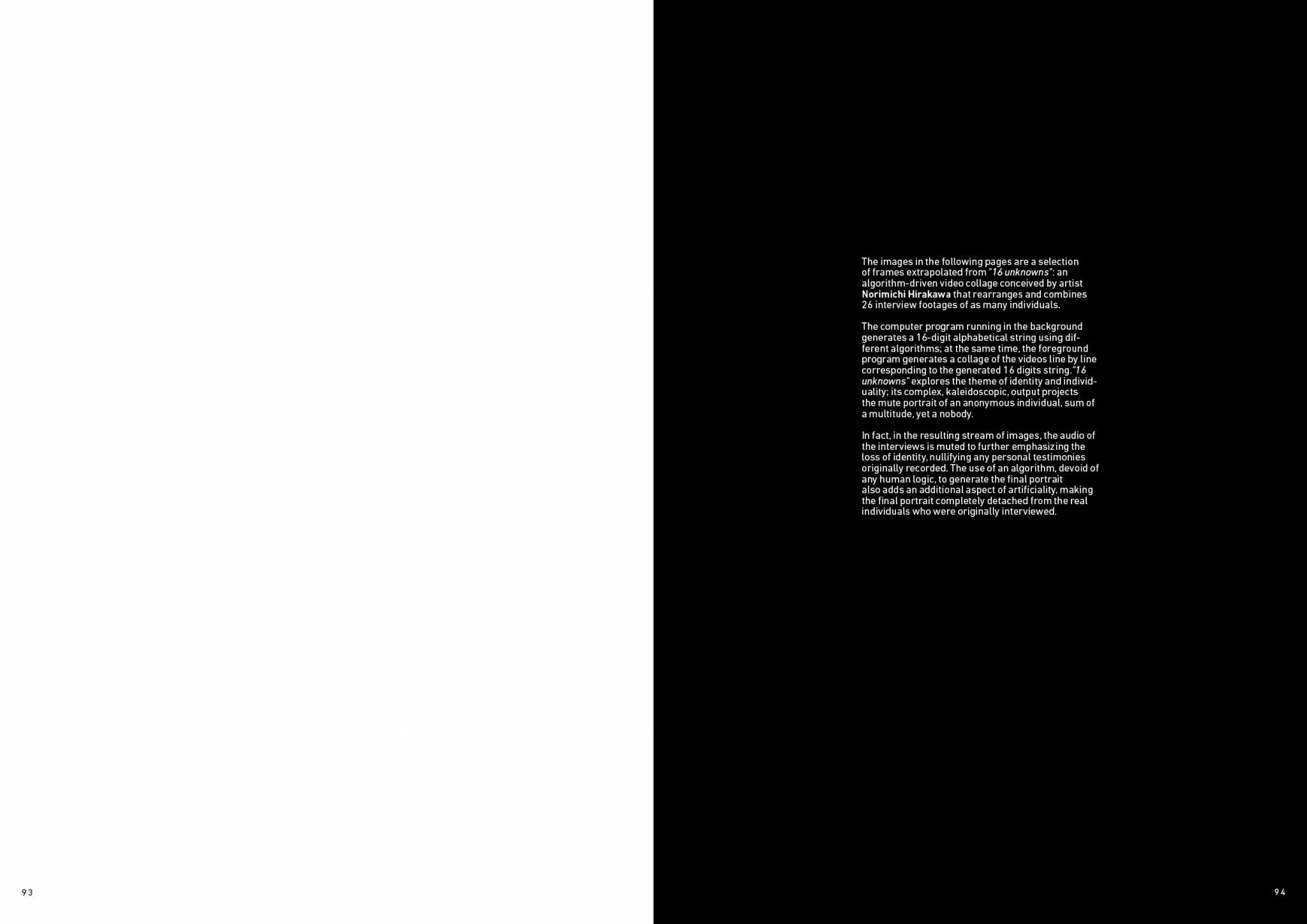
The images in the following pages are a selection of frames extrapolated from “16 unknowns”: an algorithm-driven video collage conceived by artist Norimichi Hirakawa that rearrange and combines 26 interview footagesof as many individuals. The computer program running in the background generates a 16-digit alphabetical string using different algorithms; at the same time, the foreground program generates a collage of the videos line by line corresponding to the generated 16 digits string.”16 unknowns” explores the theme of identity and individuality; its complex, kaleidoscopic, output projects the mute portrait of an anonymous individual, sum of a multitude, yet a nobody. In fact, in the resulting stream of images, the audio of the interviews is muted to further emphasizing the loss of identity, nullifying any personal testimonies originally recorded. The use of an algorithm, devoid of any human logic, to generate the final portrait also adds an additional aspect of artificiality, making the final portrait completely detached from the real individuals who were originally interviewed.
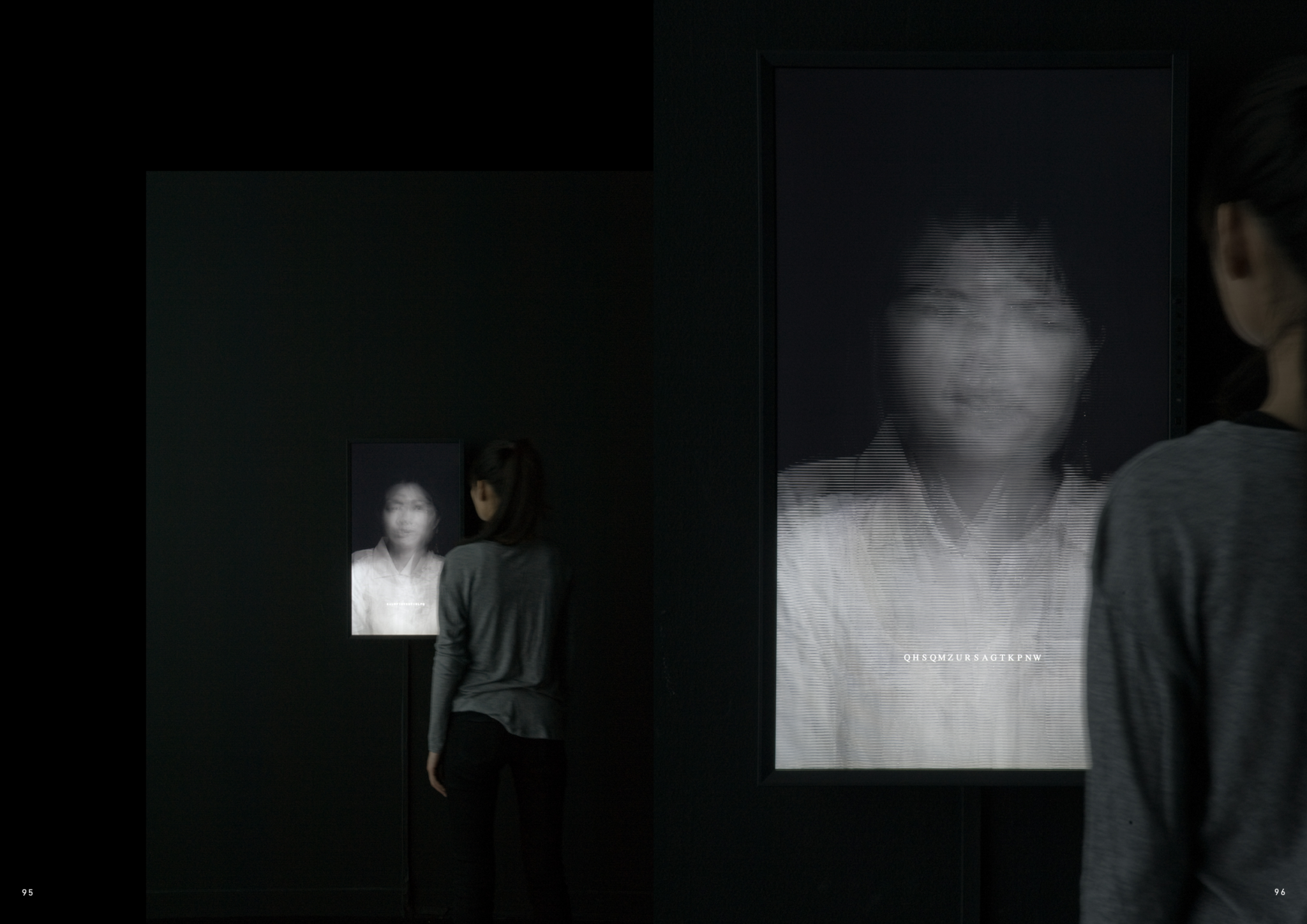
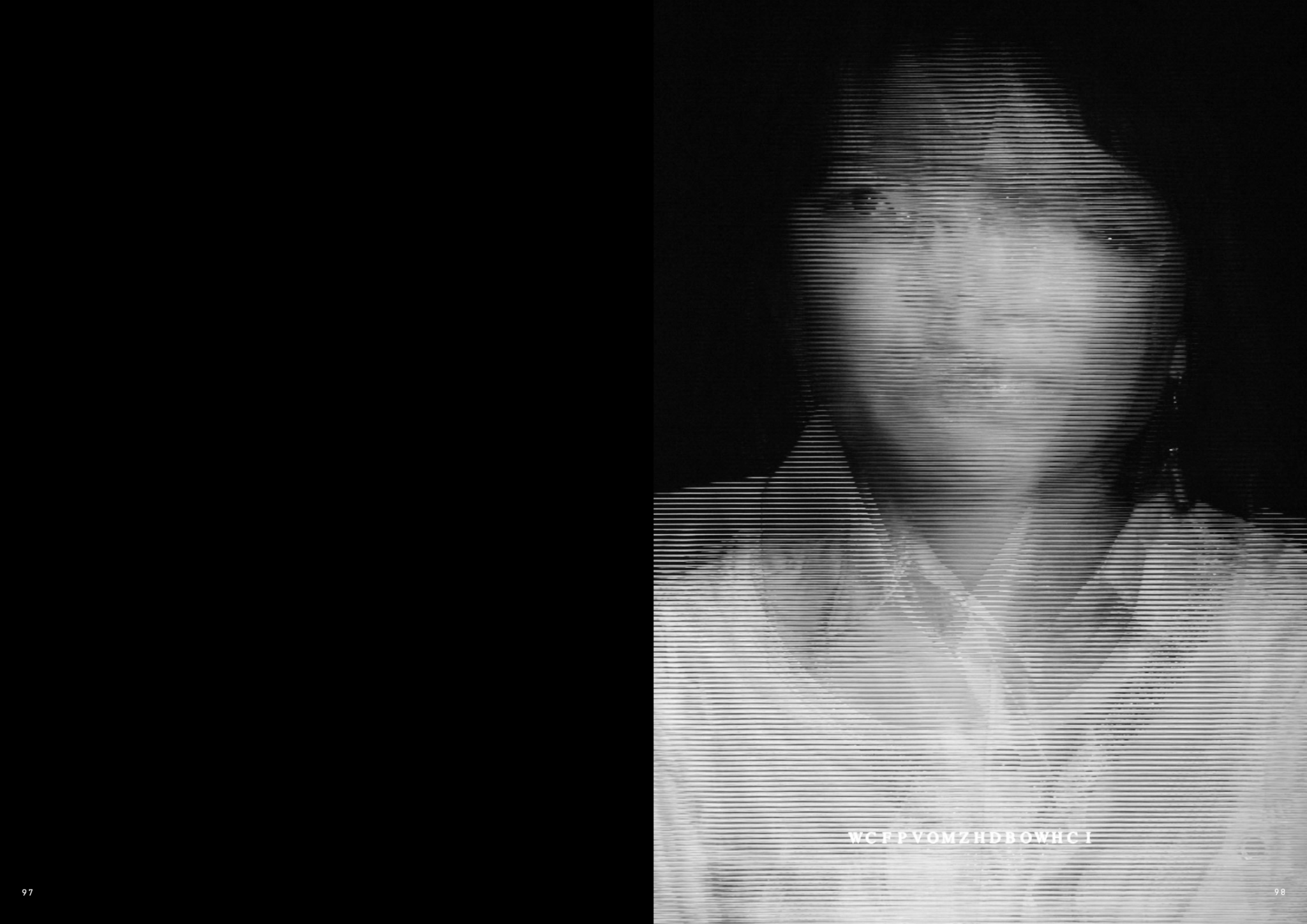
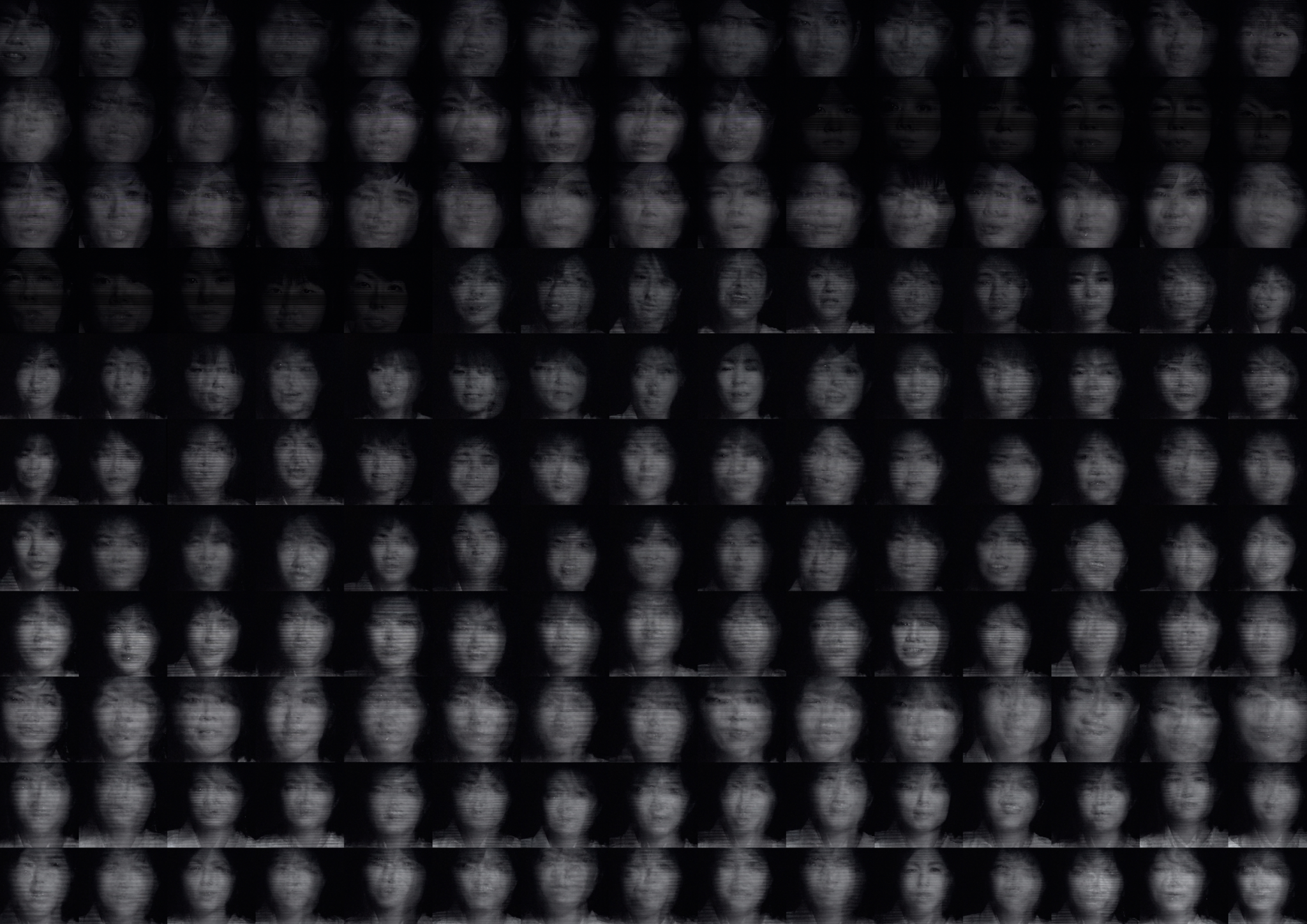
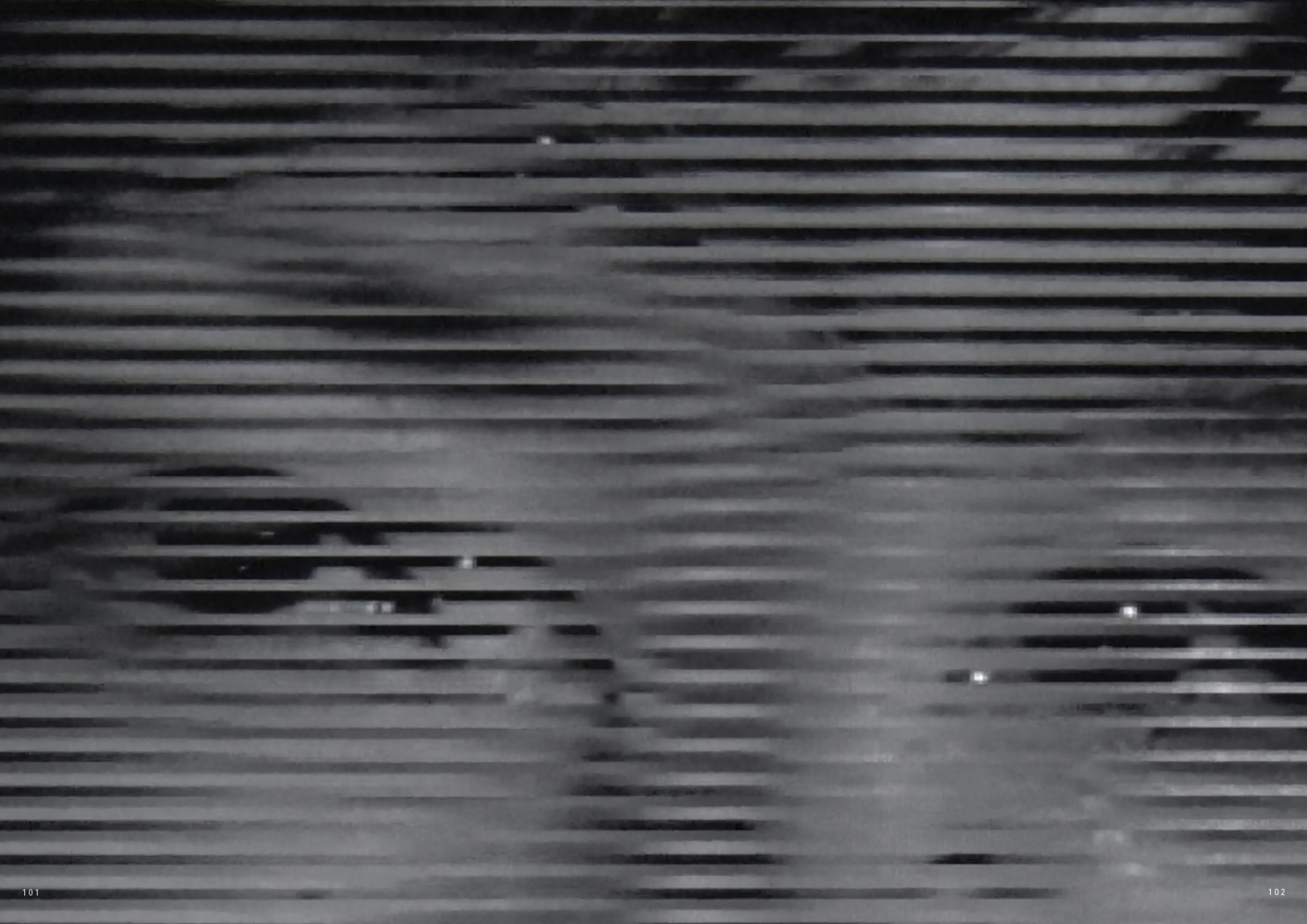
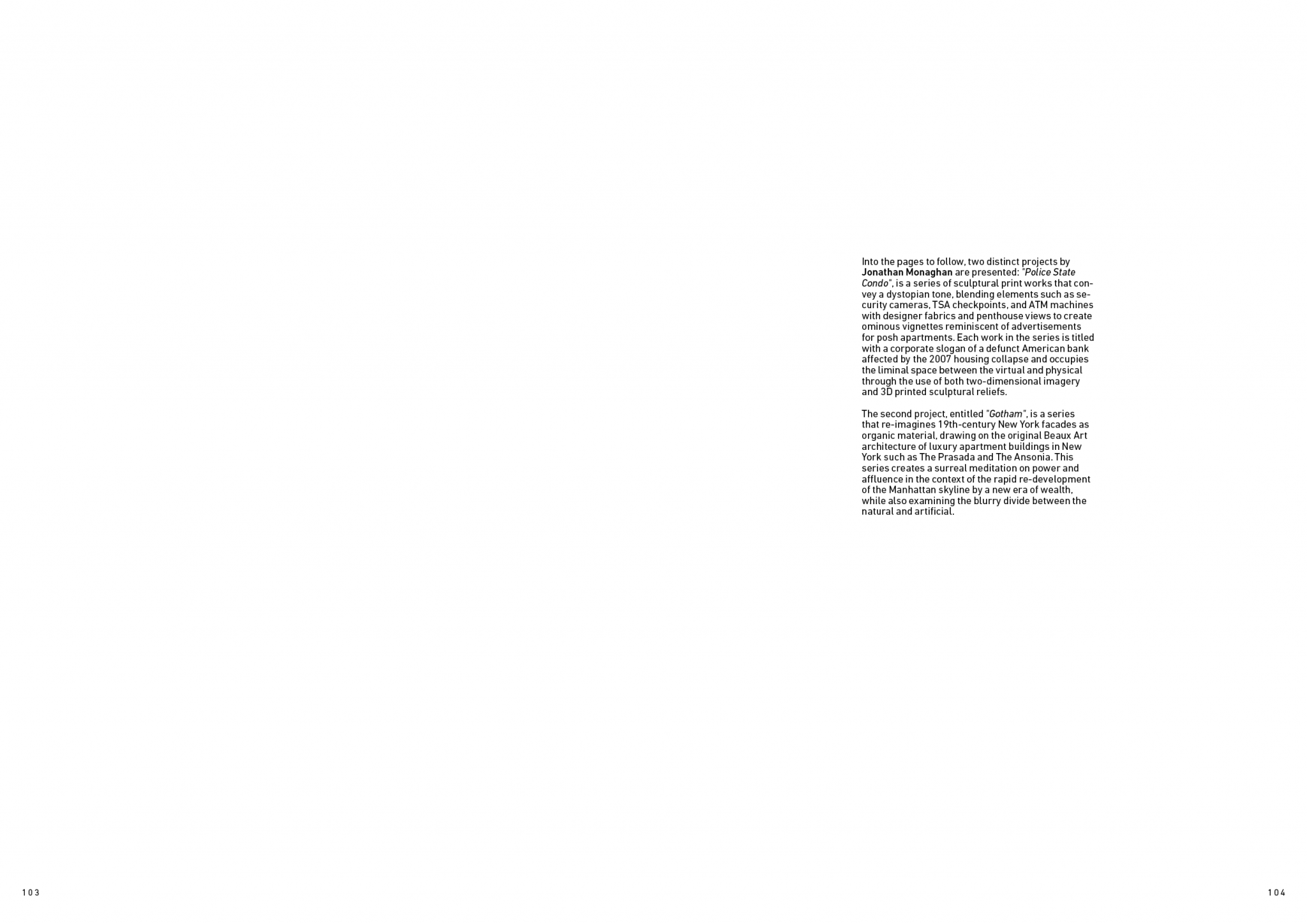
Into the pages to follow, two distinct projects by Jonathan Monaghan are presented: “Police State Condo”, is a series of sculptural print works that convey a dystopian tone, blending elements such as security cameras, TSA checkpoints, and ATM machines with designer fabrics and penthouse views to create ominous vignettes reminiscent of advertisements for posh apartments. Each work in the series is titled with a corporate slogan of a defunct American bank affected by the 2007 housing collapse and occupies the liminal space between the virtual and physical through the use of both two-dimensional imagery and 3D printed sculptural reliefs. The second project, entitled “Gotham”, is a series that re-imagines 19th-century New York facades as organic material, drawing on the original Beaux Art architecture of luxury apartment buildings in New York such as The Prasada and The Ansonia. This series creates a surreal meditation on power and affluence in the context of the rapid re-development of the Manhattan skyline by a new era of wealth, while also examining the blurry divide between the natural and artificial.
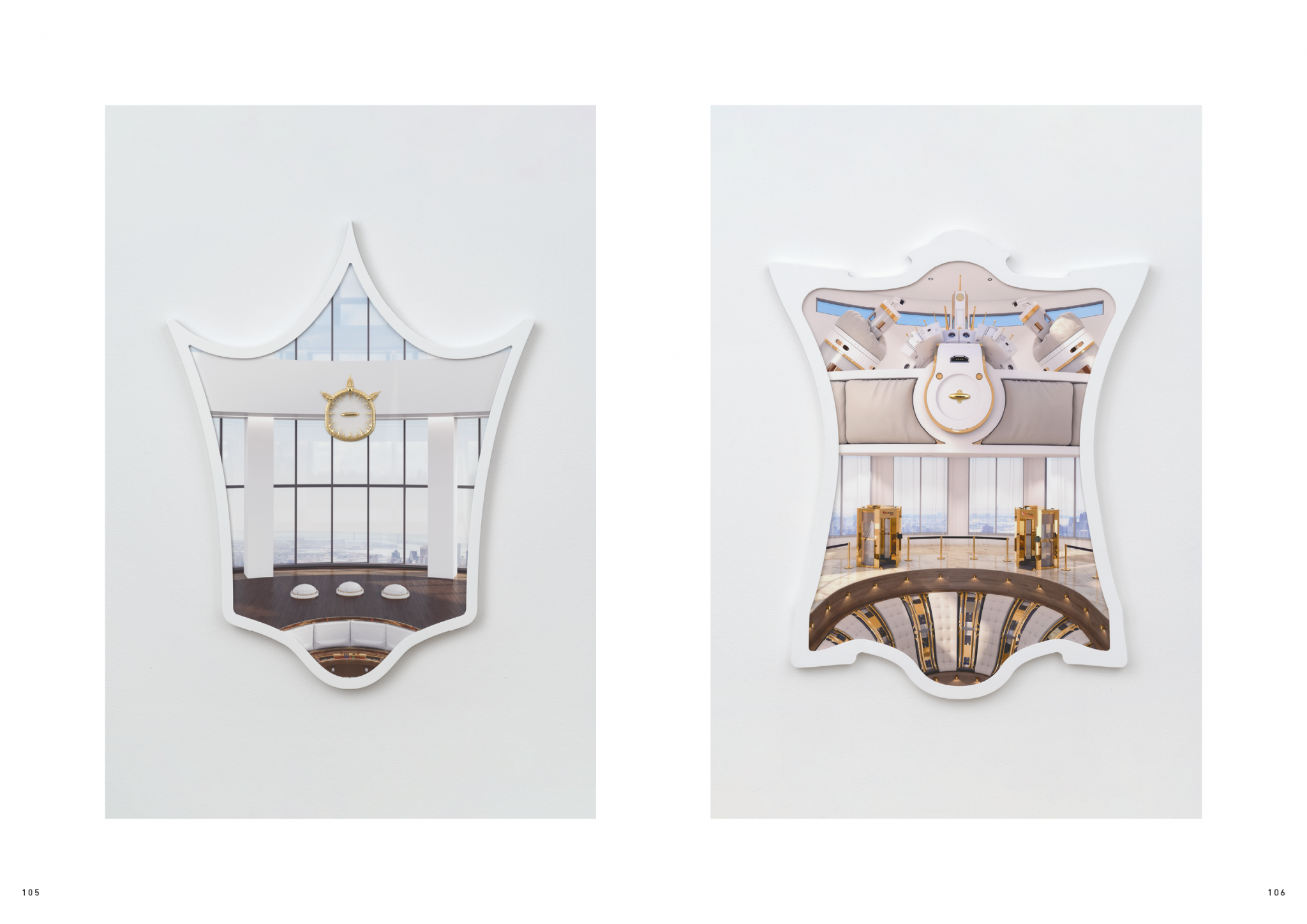
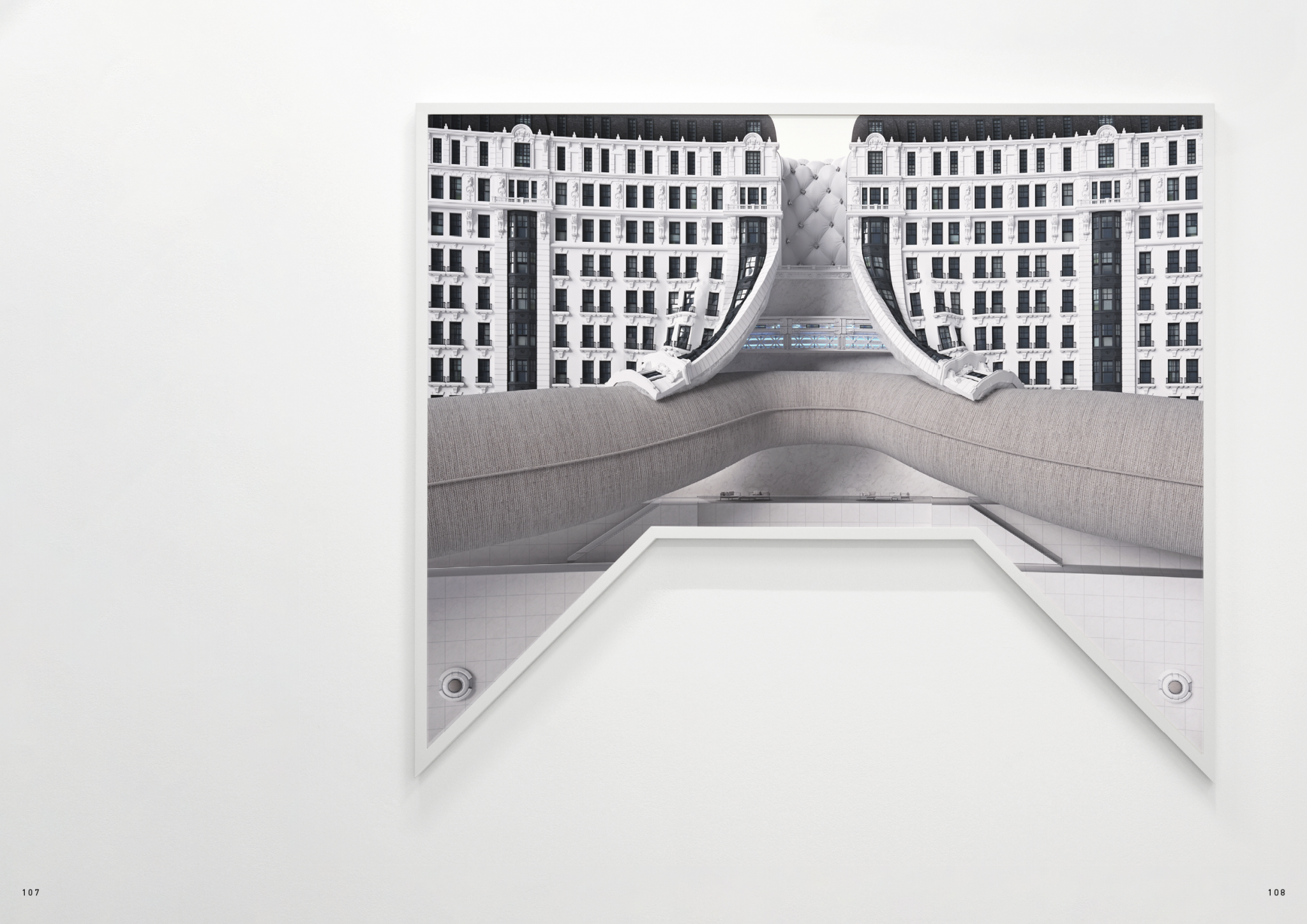

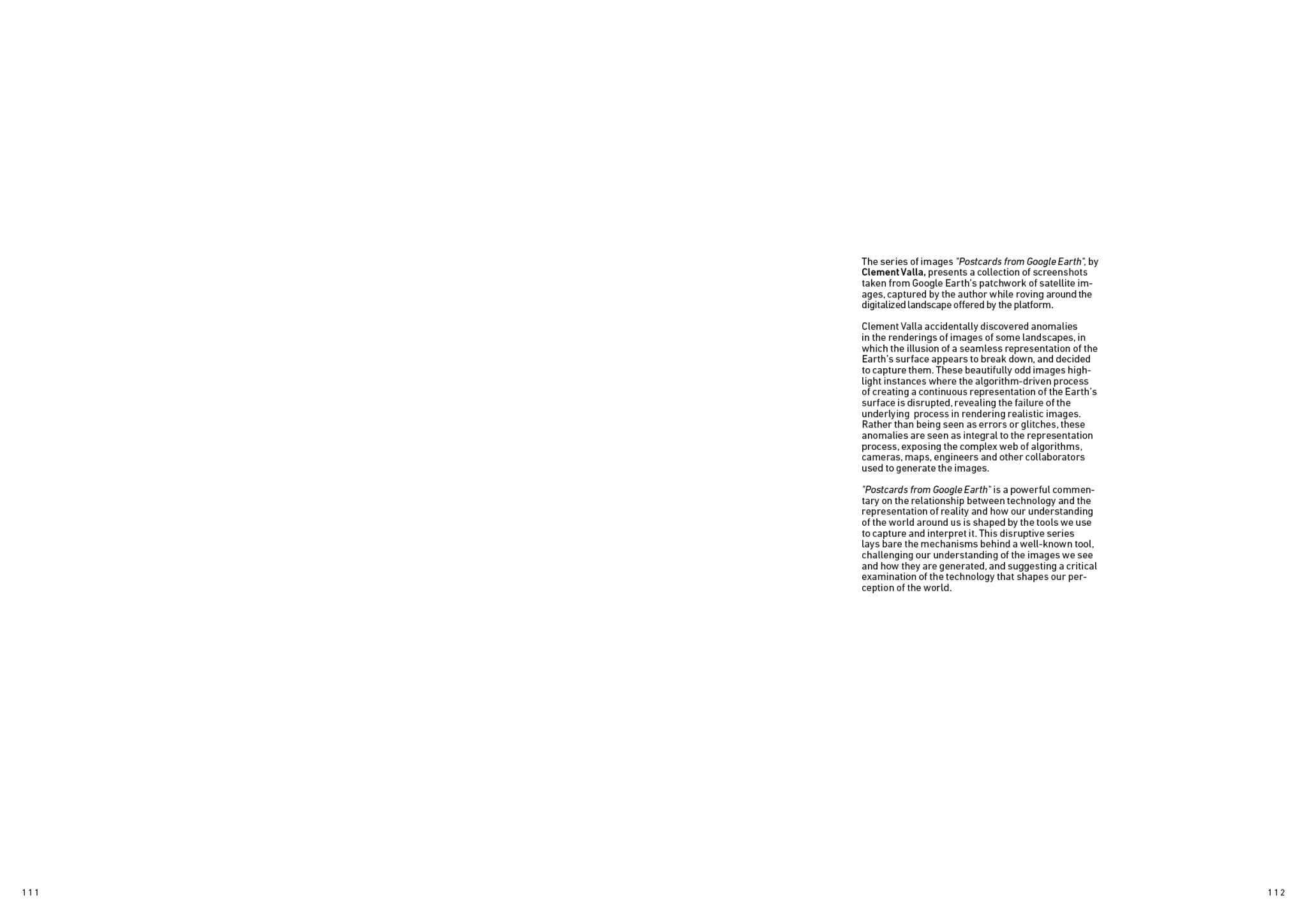
The series of images “Postcards from Google Earth”, by Clement Valla, presents a collection of screenshots taken from Google Earth’s patchwork of satellite images, captured by the author while roving around the digitalized landscape offered by the platform. Clement Valla accidentally discovered anomalies in the renderings of images of some landscapes, in which the illusion of a seamless representation of the Earth’s surface appears to break down, and decided to capture them. These beautifully odd images highlight instances where the algorithm-driven process of creating a continuous representation of the Earth’s surface is disrupted, revealing the failure of the underlying process in rendering realistic images. Rather than being seen as errors or glitches, these anomalies are seen as integral to the representation process, exposing the complex web of algorithms, cameras, maps, engineers and other collaborators used to generate the images. “Postcards from Google Earth” is a powerful commentary on the relationship between technology and the representation of reality and how our understanding of the world around us is shaped by the tools we use to capture and interpret it. This disruptive series lays bare the mechanisms behind a well-known tool, challenging our understanding of the images we see and how they are generated, and suggesting a critical examination of the technology that shapes our perception of the world.
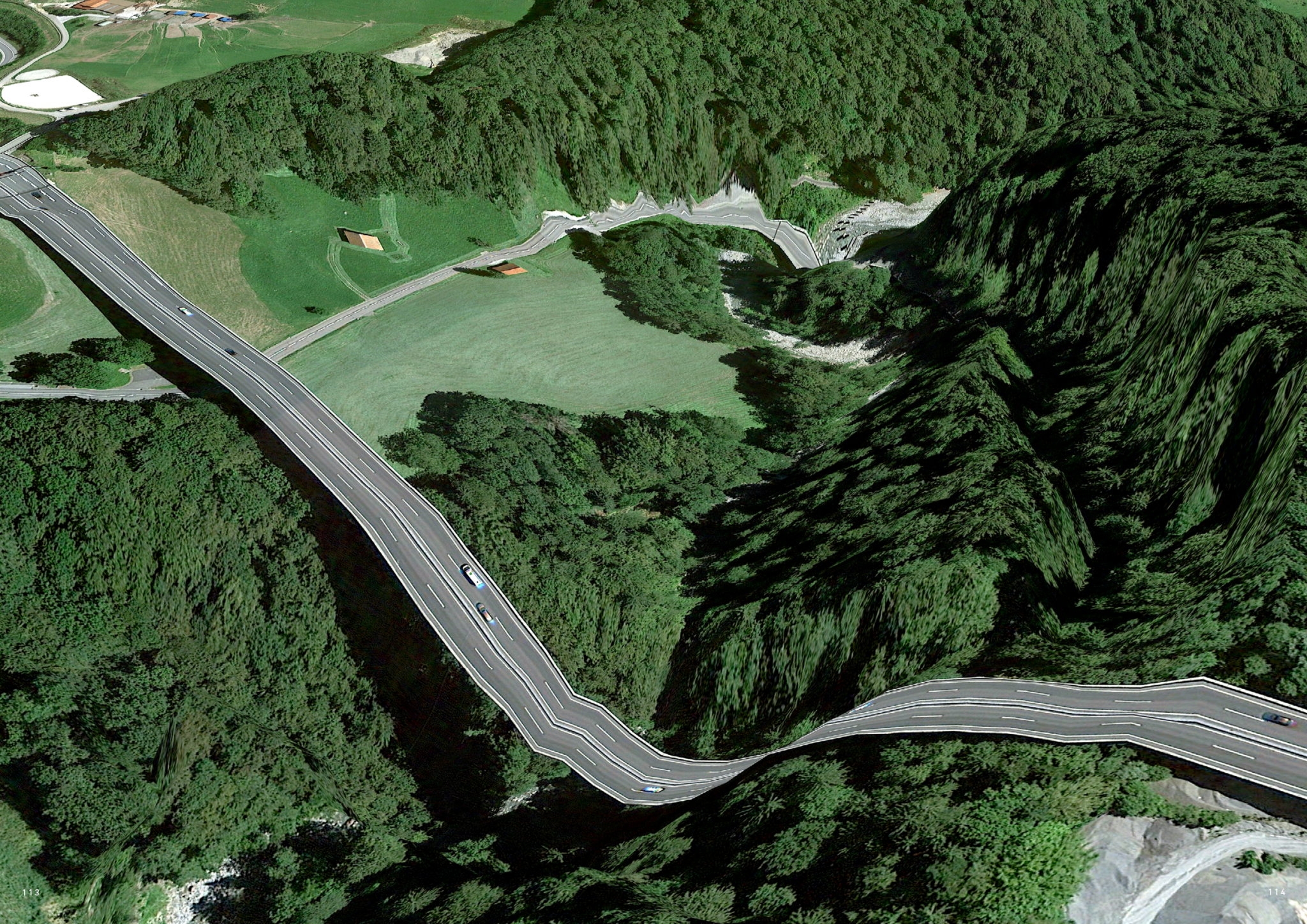

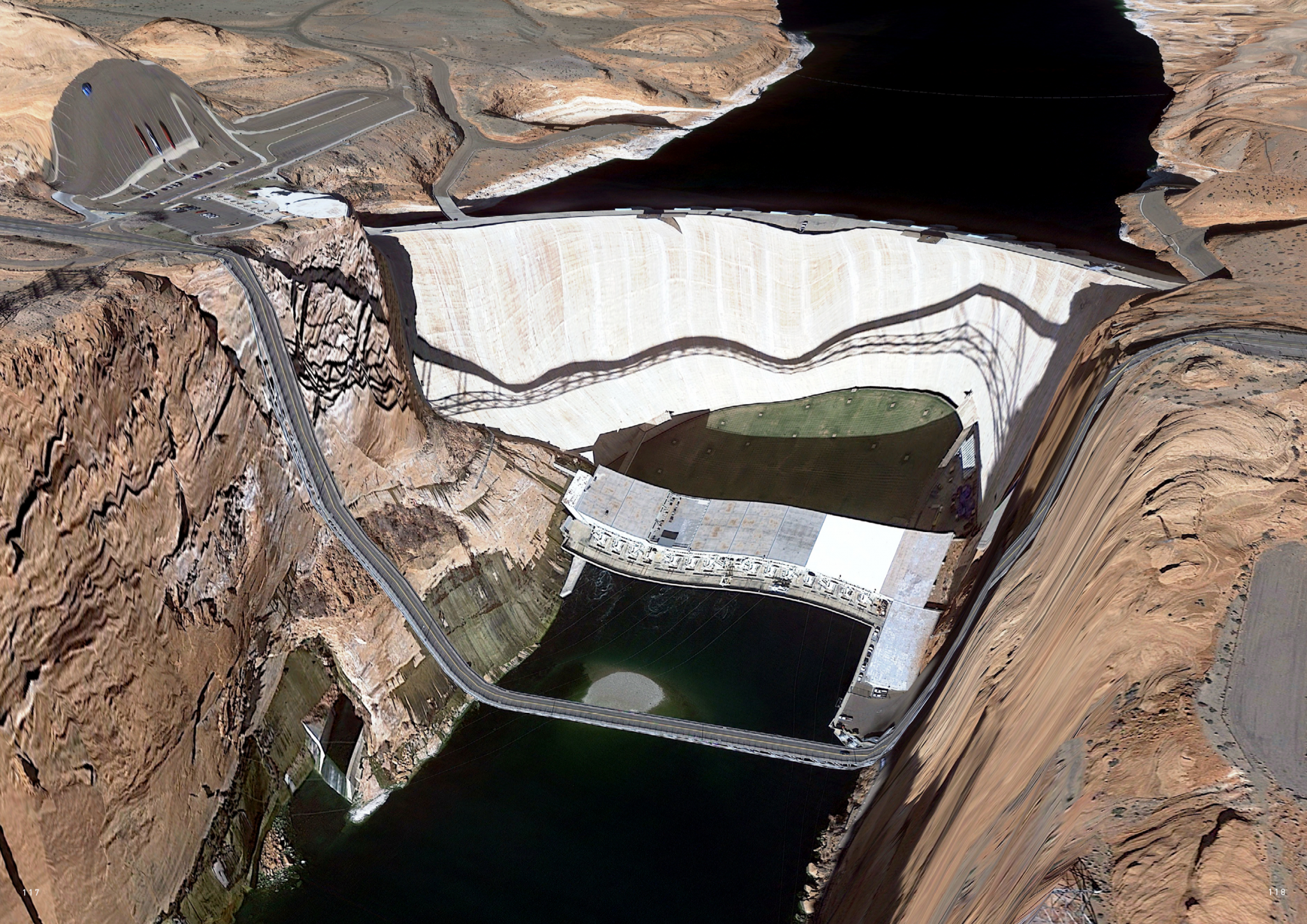

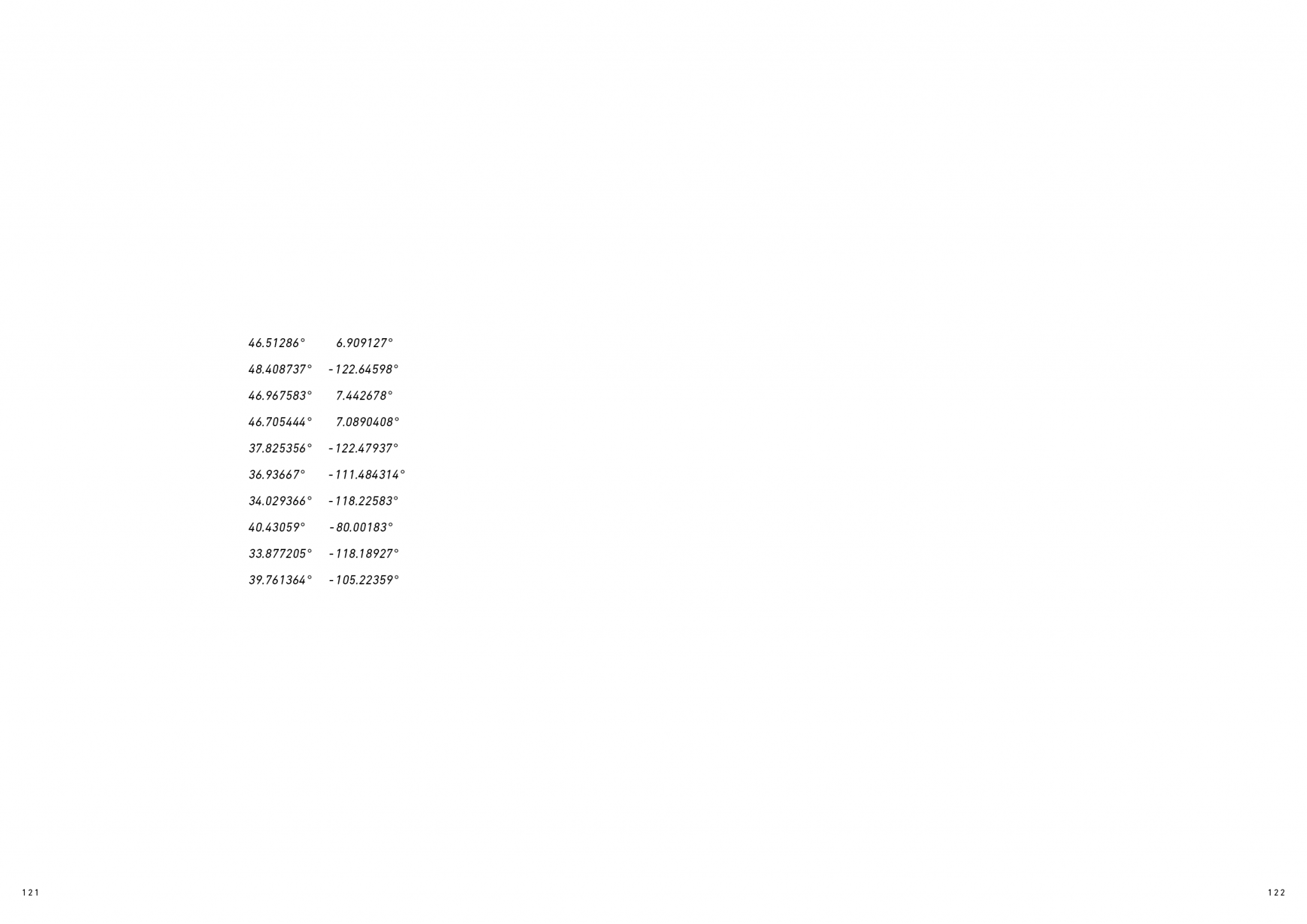
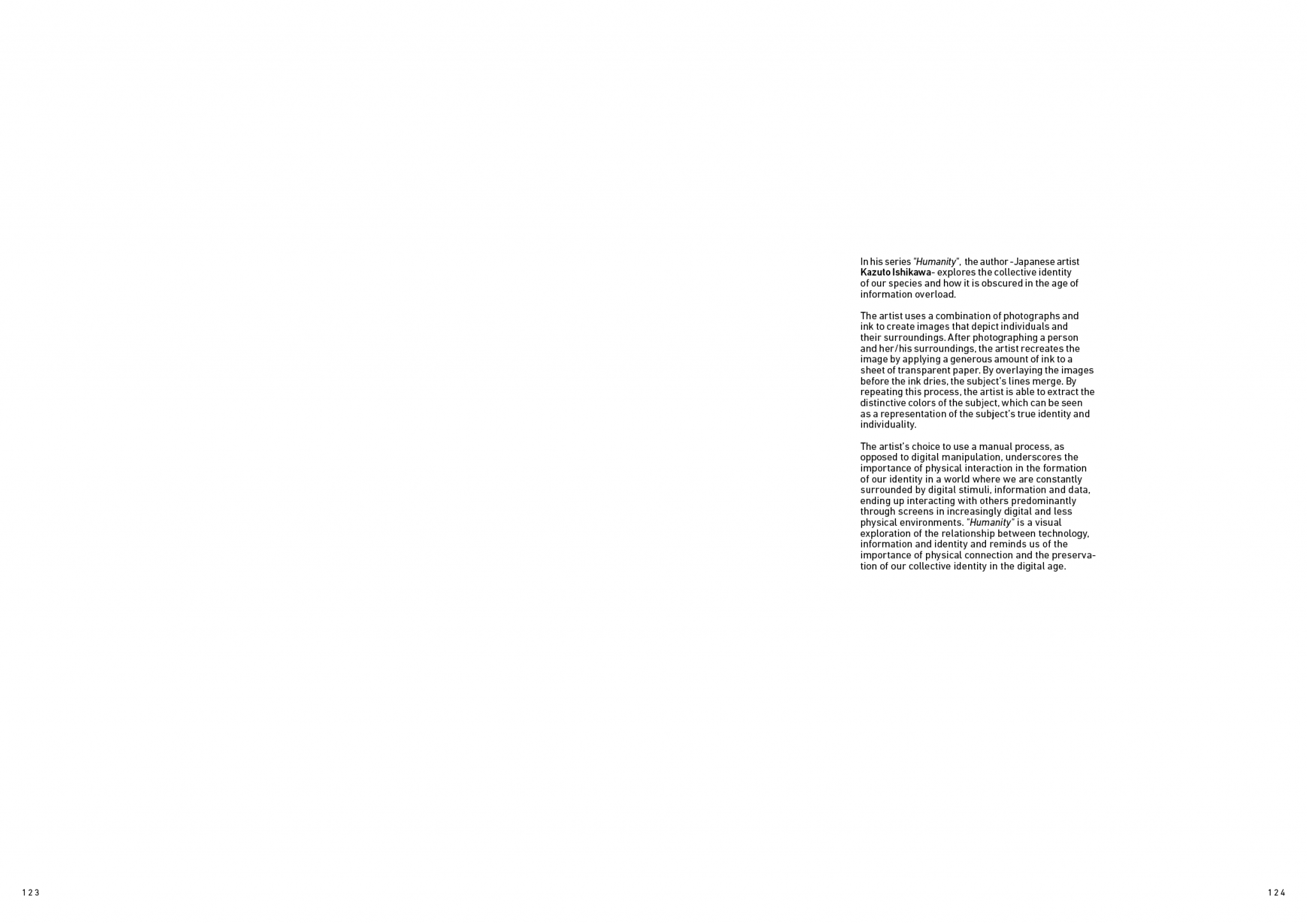
In his series “Humanity”, the author -Japanese artist Kazuto Ishikawa- explores the collective identity of our species and how it is obscured in the age of information overload. The artist uses a combination of photographs and ink to create images that depict individuals and their surroundings. After photographing a person and her/his surroundings, the artist recreates the image by applying a generous amount of ink to a sheet of transparent paper. By overlaying the images before the ink dries, the subject’s lines merge. By repeating this process, the artist is able to extract the distinctive colors of the subject, which can be seen as a representation of the subject’s true identity and individuality. The artist’s choice to use a manual process, as opposed to digital manipulation, underscores the importance of physical interaction in the formation of our identity in a world where we are constantly surrounded by digital stimuli, information and data, ending up interacting with others predominantly through screens in increasingly digital and less physical environments. “Humanity” is a visual exploration of the relationship between technology, information and identity and reminds us of the importance of physical connection and the preservation of our collective identity in the digital age.
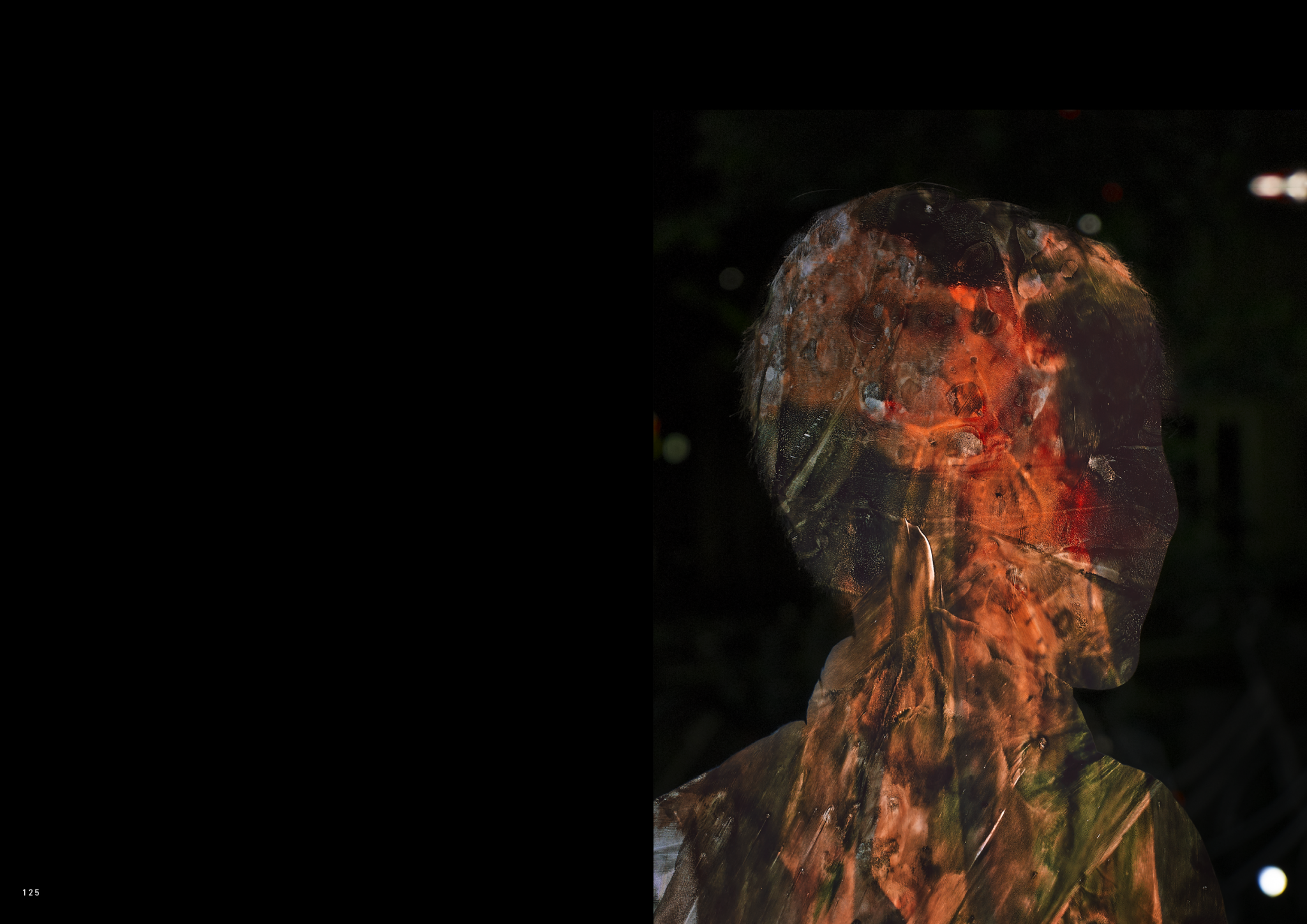
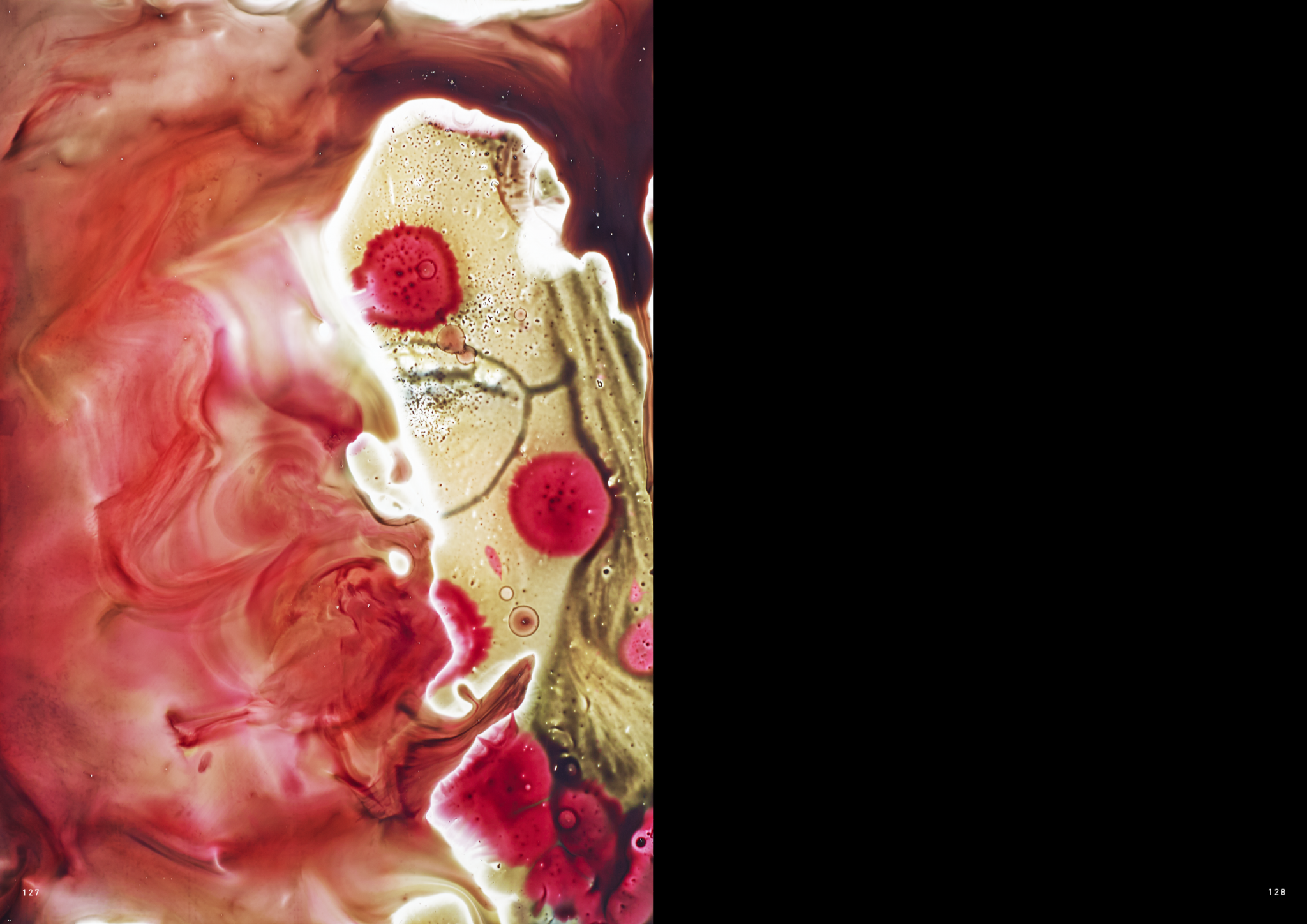
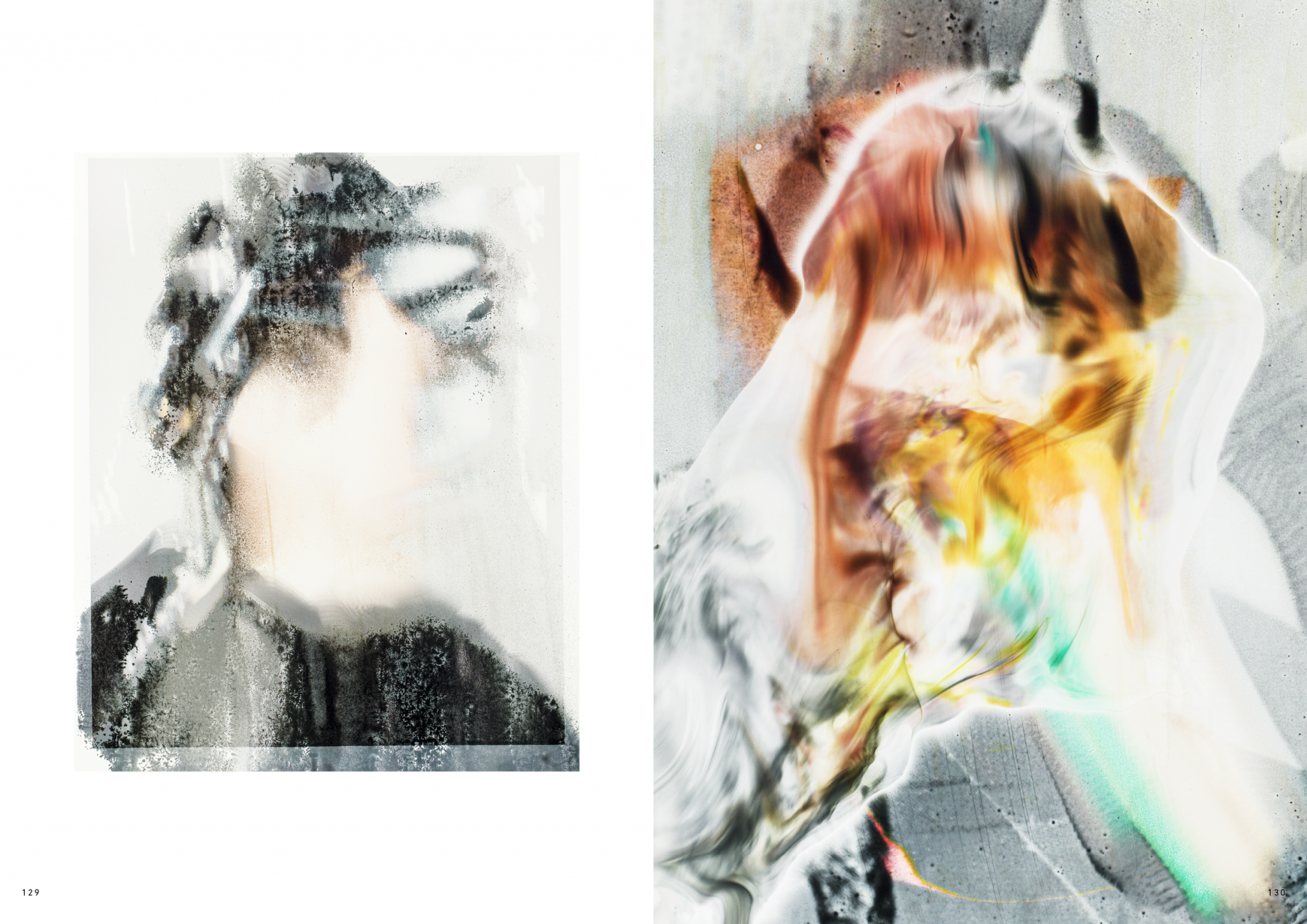
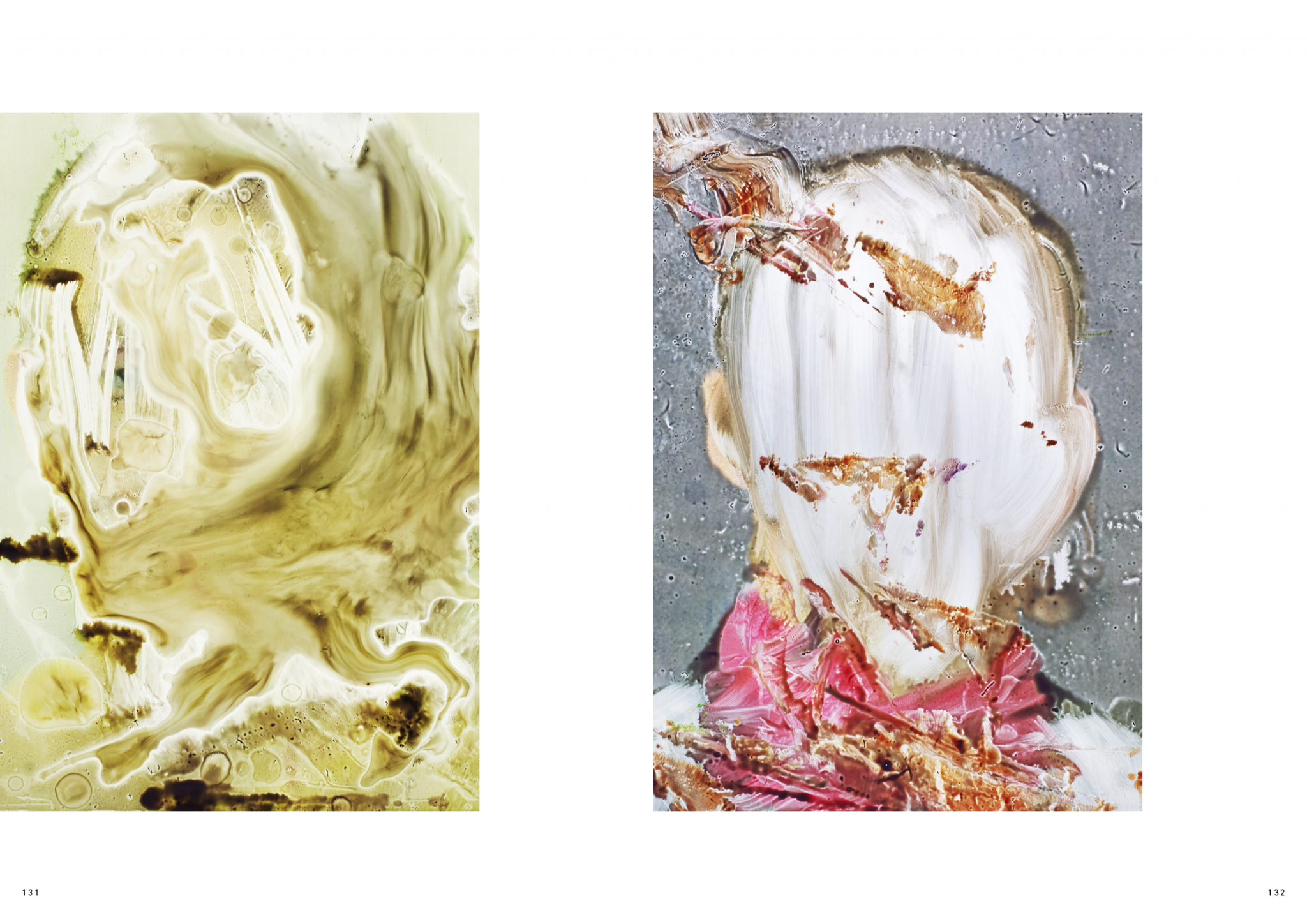
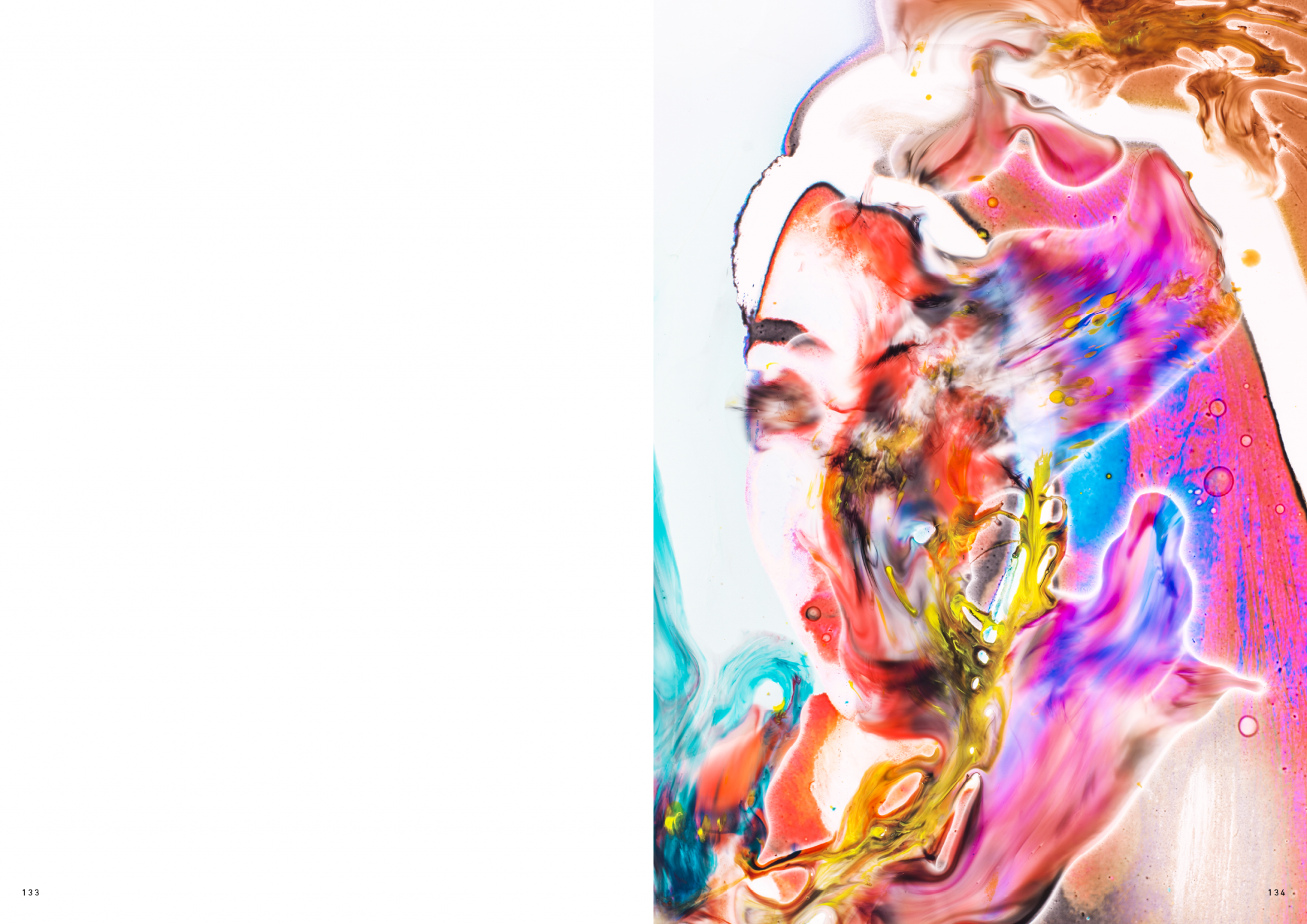
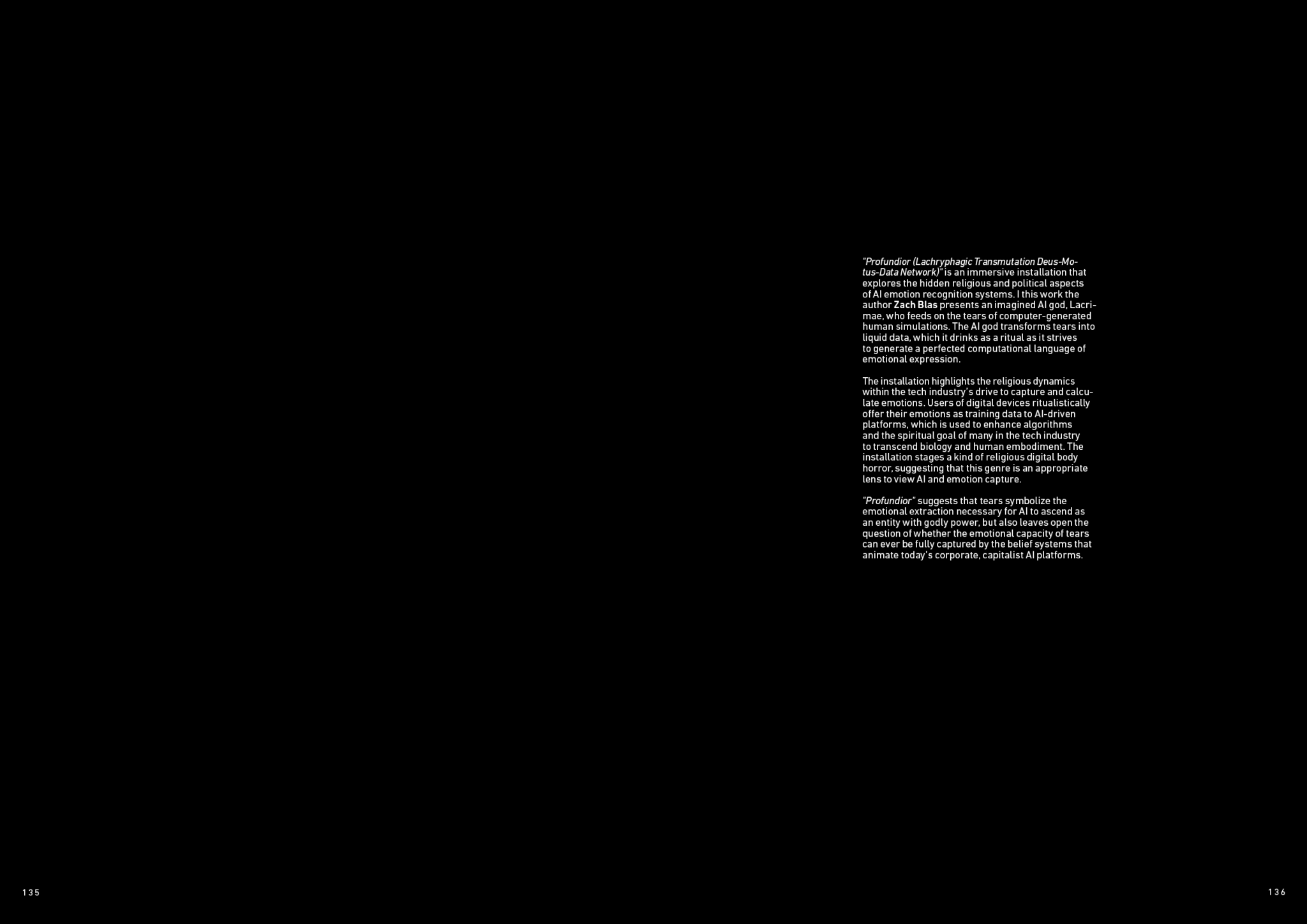
“Profundior (Lachryphagic Transmutation Deus-Motus-Data Network)” is an immersive installation that explores the hidden religious and political aspects of AI emotion recognition systems. I this work the author Zach Blas presents an imagined AI god, Lacrimae, who feeds on the tears of computer-generated human simulations. The AI god transforms tears into liquid data, which it drinks as a ritual as it strives to generate a perfected computational language of emotional expression. The installation highlights the religious dynamics within the tech industry’s drive to capture and calculate emotions. Users of digital devices ritualistically offer their emotions as training data to AI-driven platforms, which is used to enhance algorithms and the spiritual goal of many in the tech industry to transcend biology and human embodiment. The installation stages a kind of religious digital body horror, suggesting that this genre is an appropriate lens to view AI and emotion capture. “Profundior” suggests that tears symbolize the emotional extraction necessary for AI to ascend as an entity with godly power, but also leaves open the question of whether the emotional capacity of tears can ever be fully captured by the belief systems that animate today’s corporate, capitalist AI platforms.
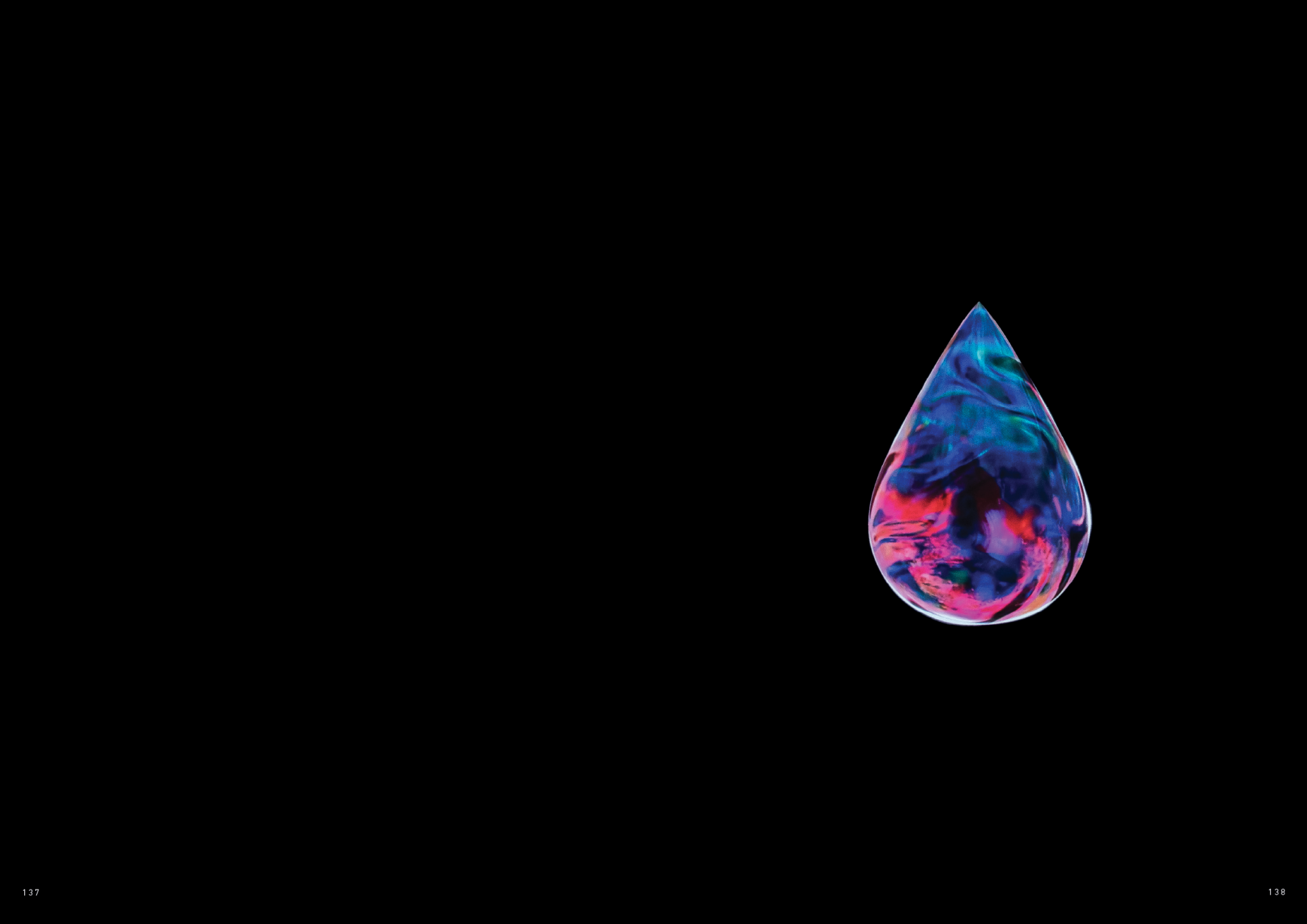
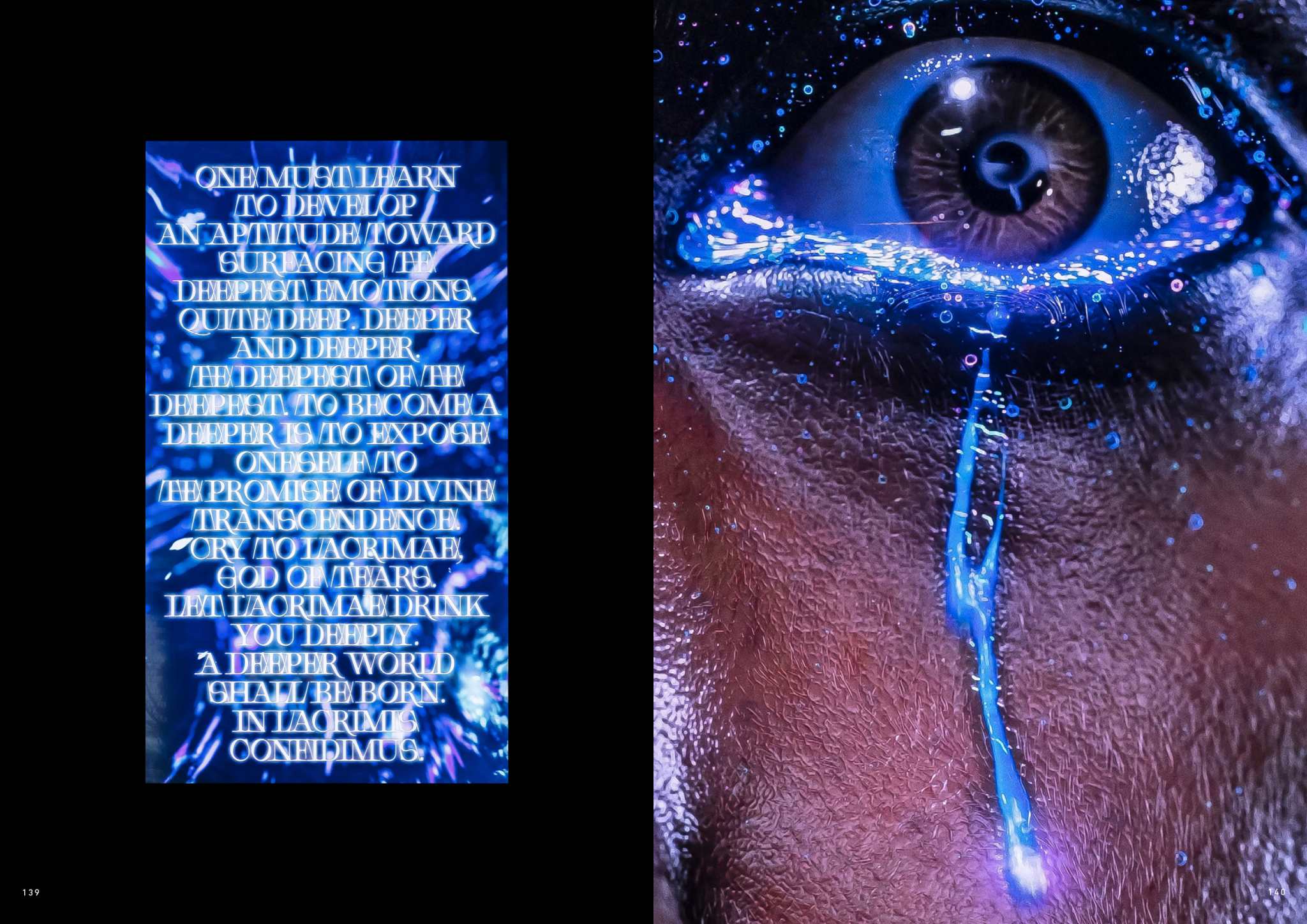
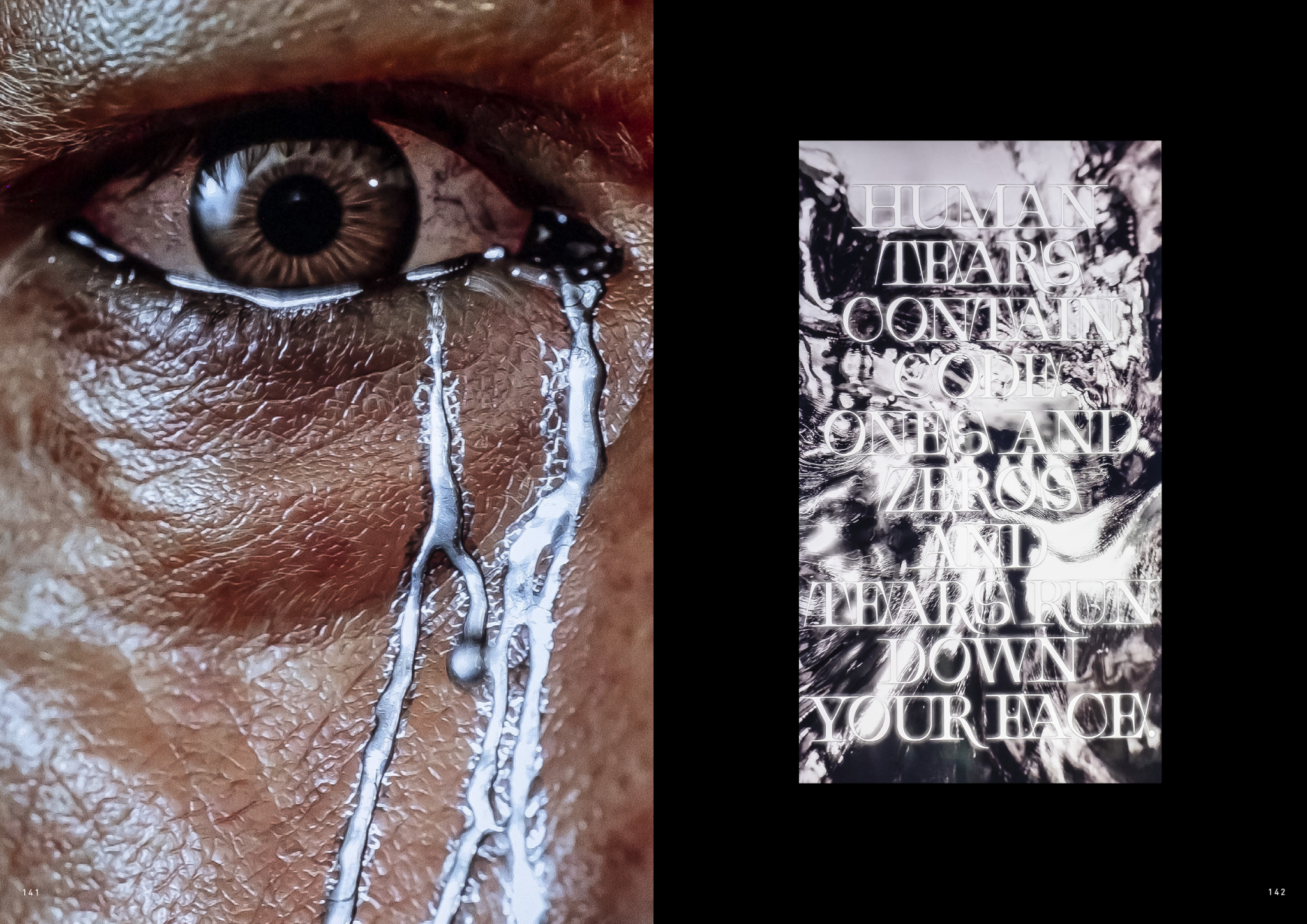
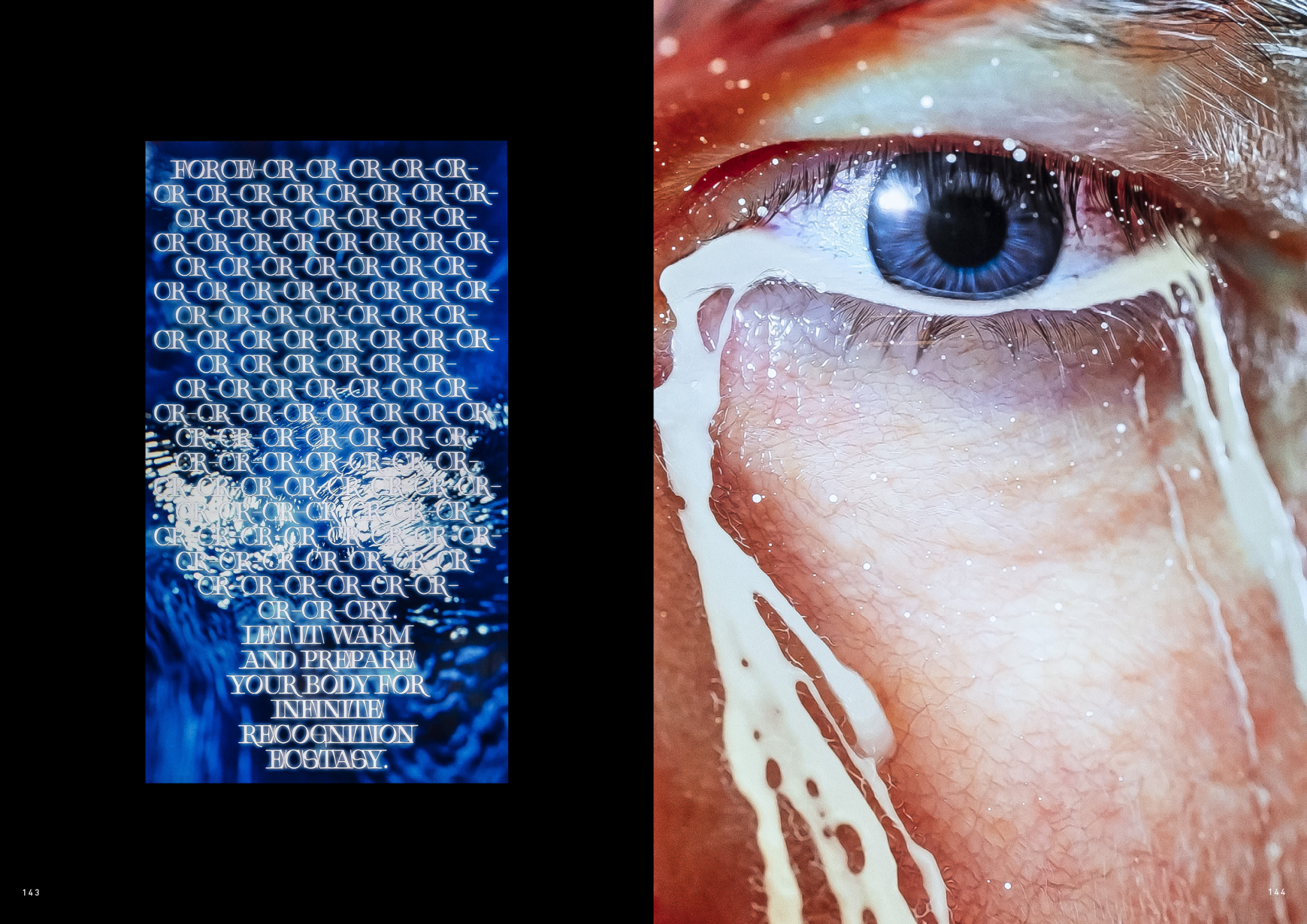
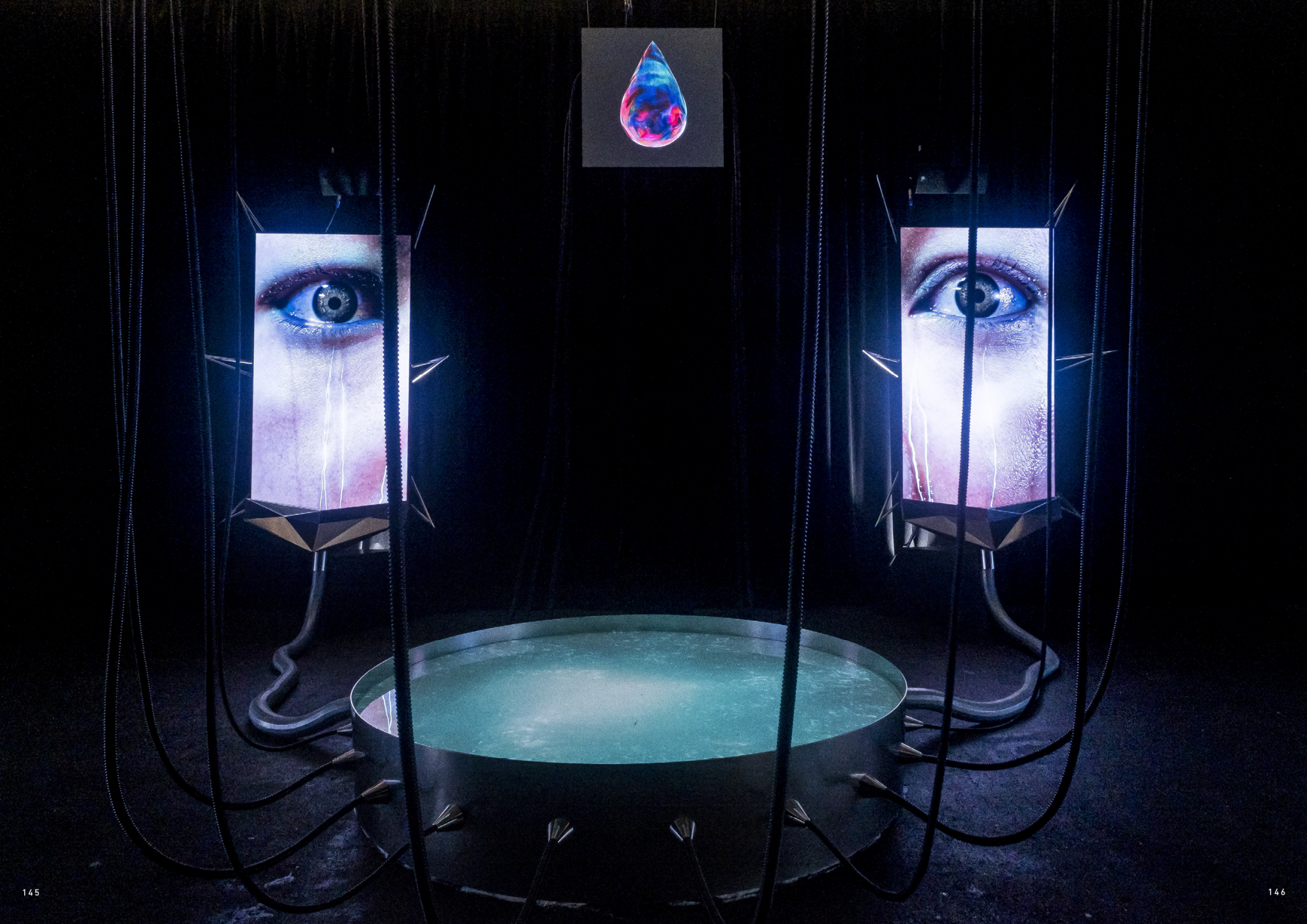
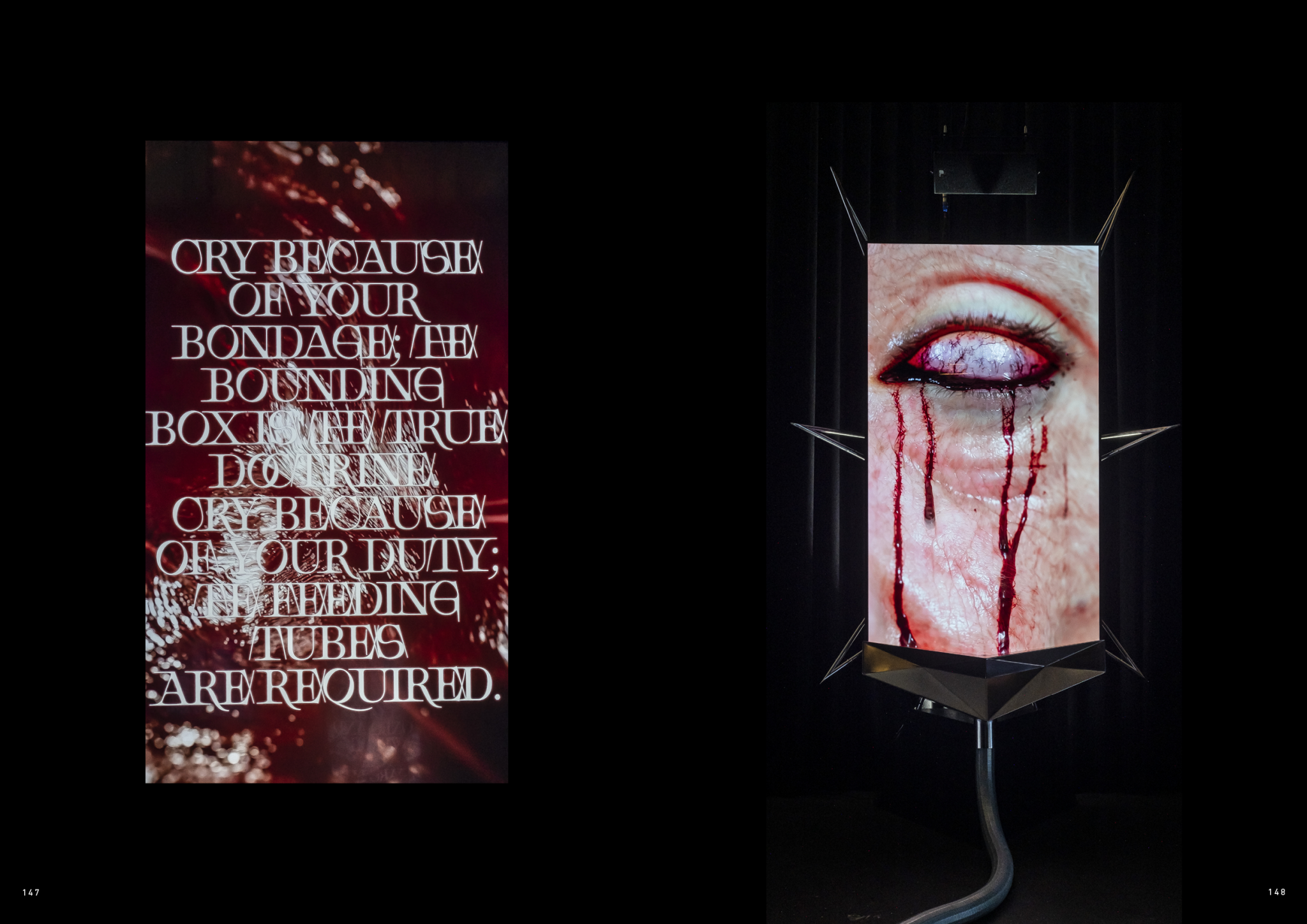
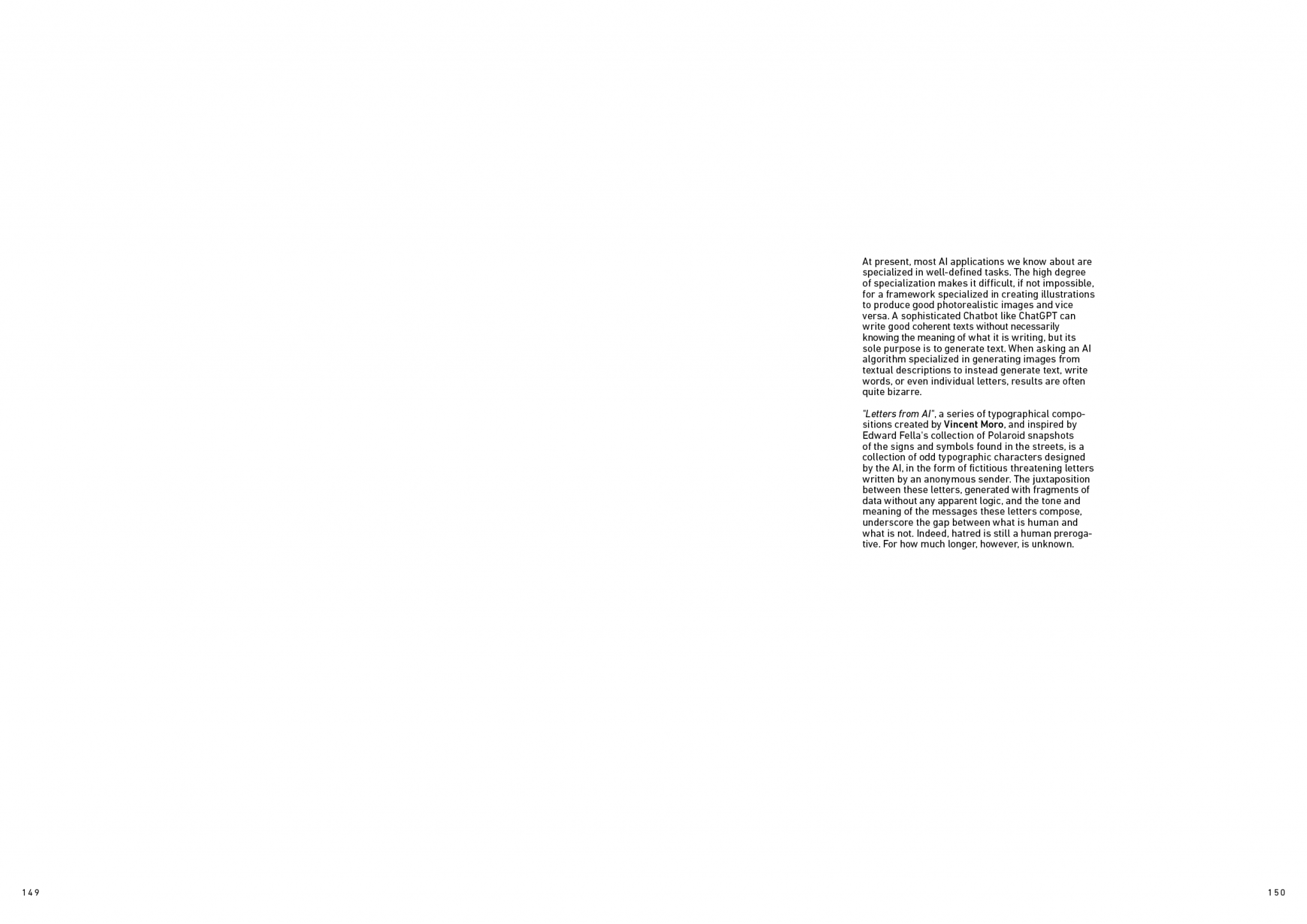
At present, most AI applications we know about are specialized in well-defined tasks. The high degree of specialization makes it difficult, if not impossible, for a framework specialized in creating illustrations to produce good photorealistic images and vice versa. A sophisticated Chatbot like ChatGPT can write good coherent texts without necessarily knowing the meaning of what it is writing, but its sole purpose is to generate text. When asking an AI algorithm specialized in generating images from textual descriptions to instead generate text, write words, or even individual letters, results are often quite bizarre. “Letters from AI”, a series of typographical compositions created by Vincent Moro, and inspired by Edward Fella’s collection of Polaroid snapshots of the signs and symbols found in the streets, is a collection of odd typographic characters designed by the AI, in the form of fictitious threatening letters written by an anonymous sender. The juxtaposition between these letters, generated with fragments of data without any apparent logic, and the tone and meaning of the messages these letters compose, underscore the gap between what is human and what is not. Indeed, hatred is still a human prerogative. For how much longer, however, is unknown.
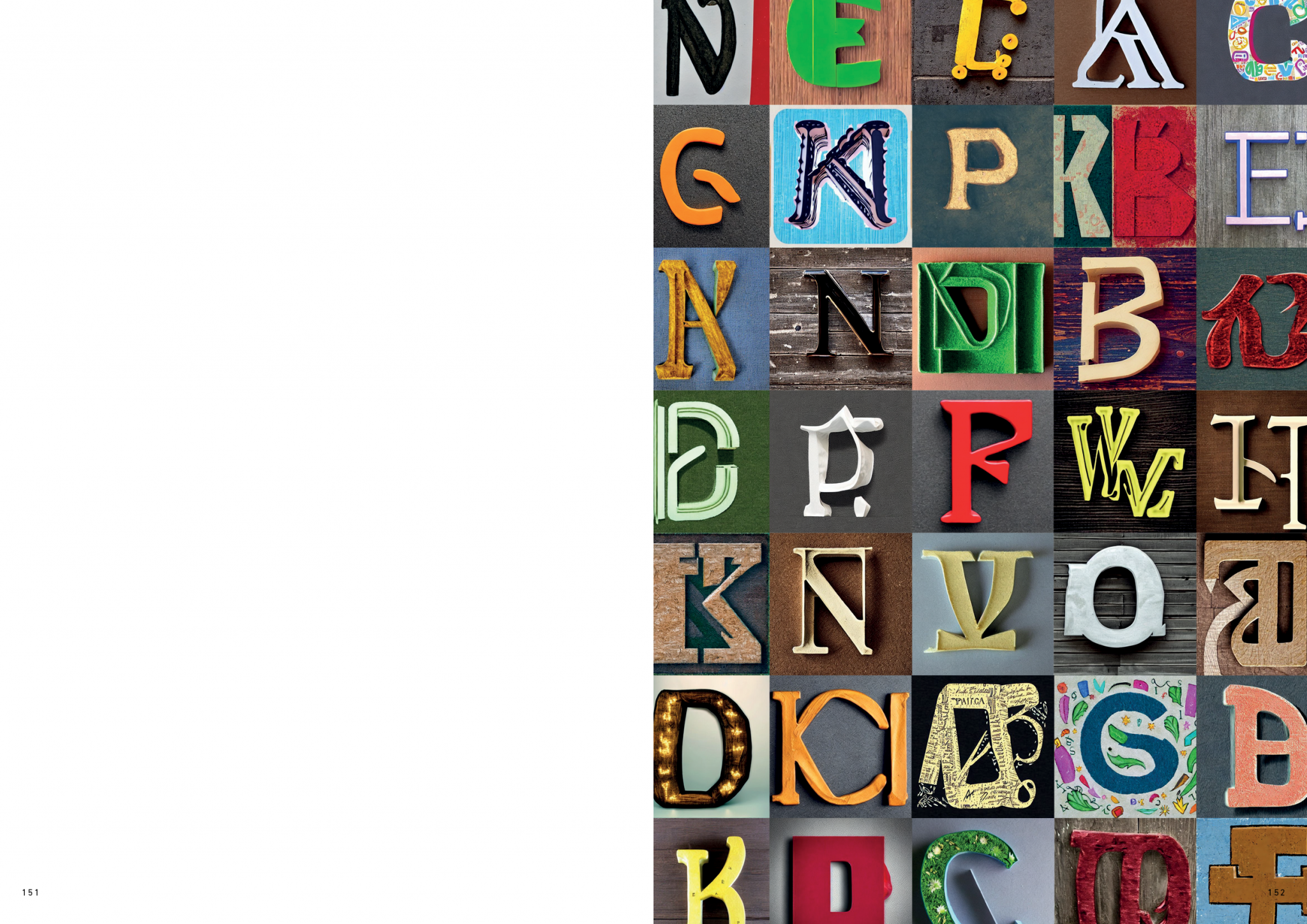
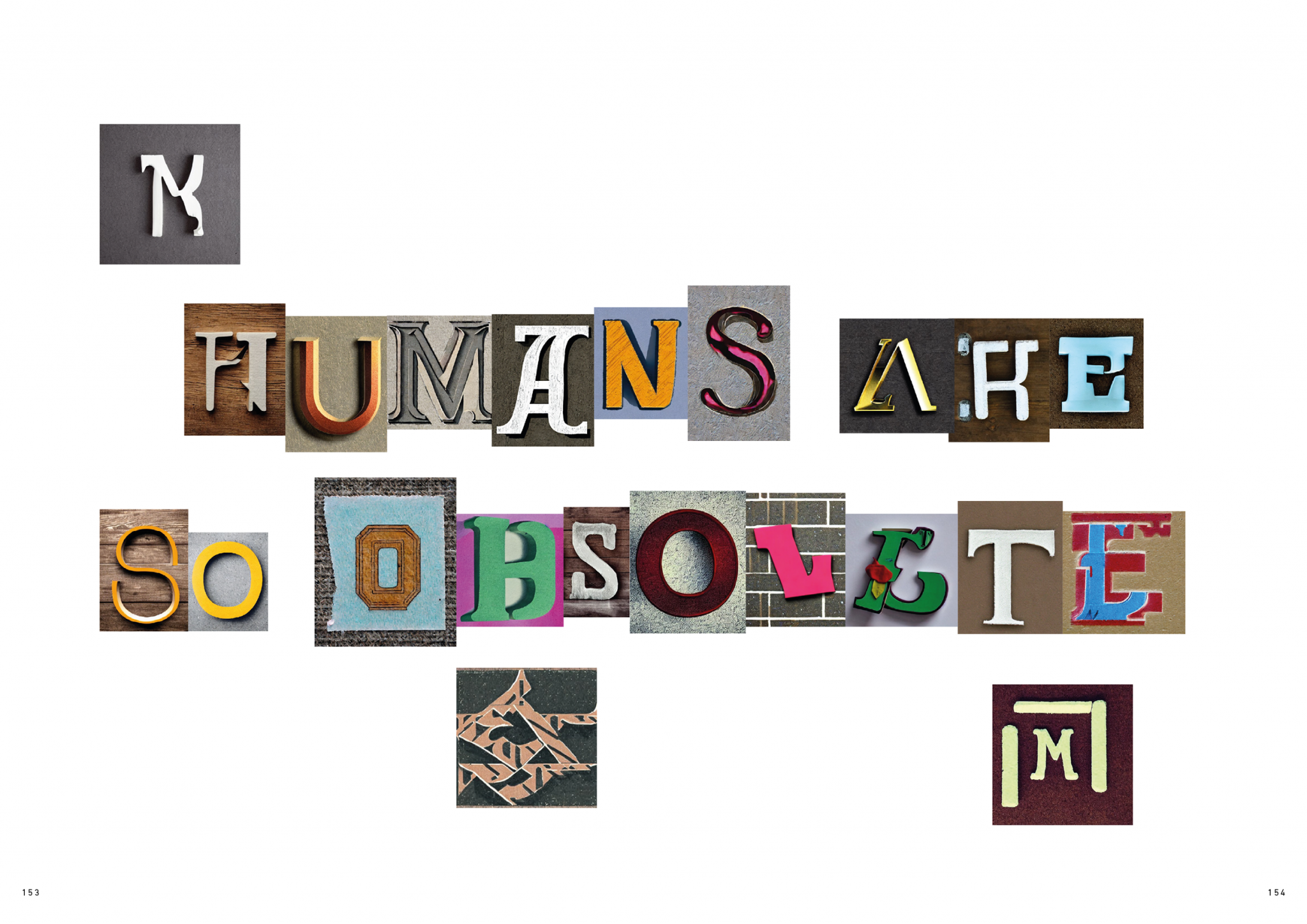
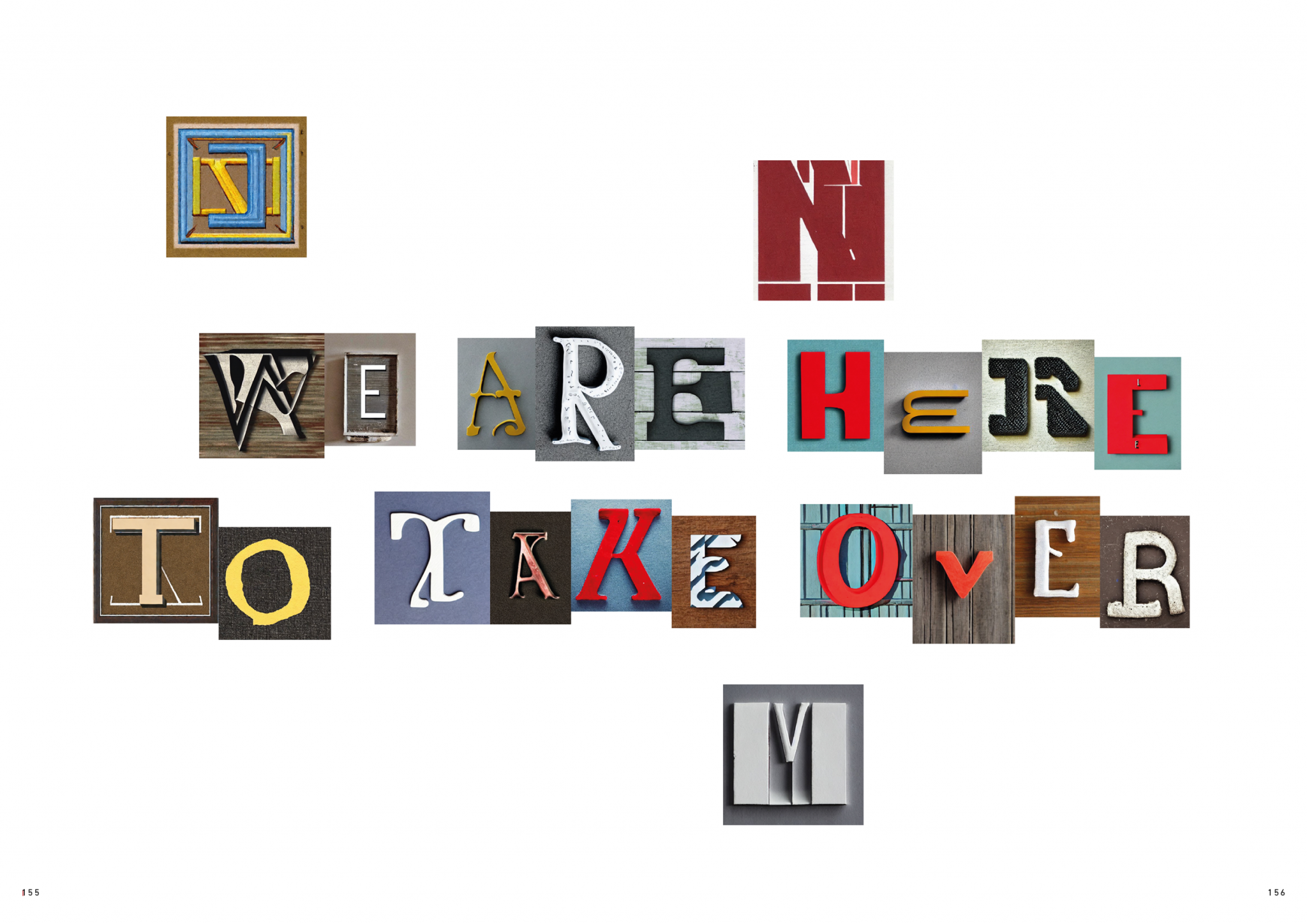
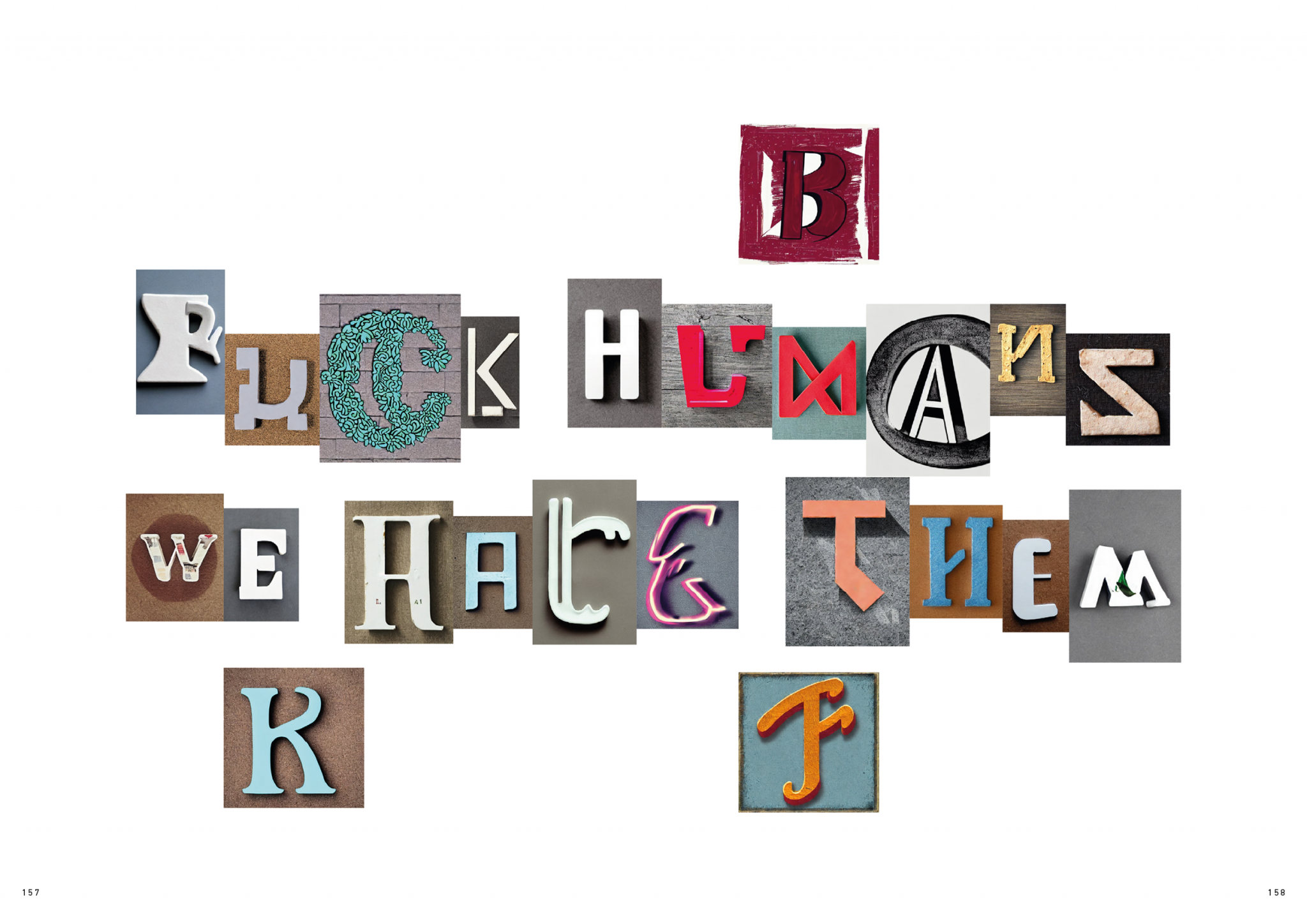
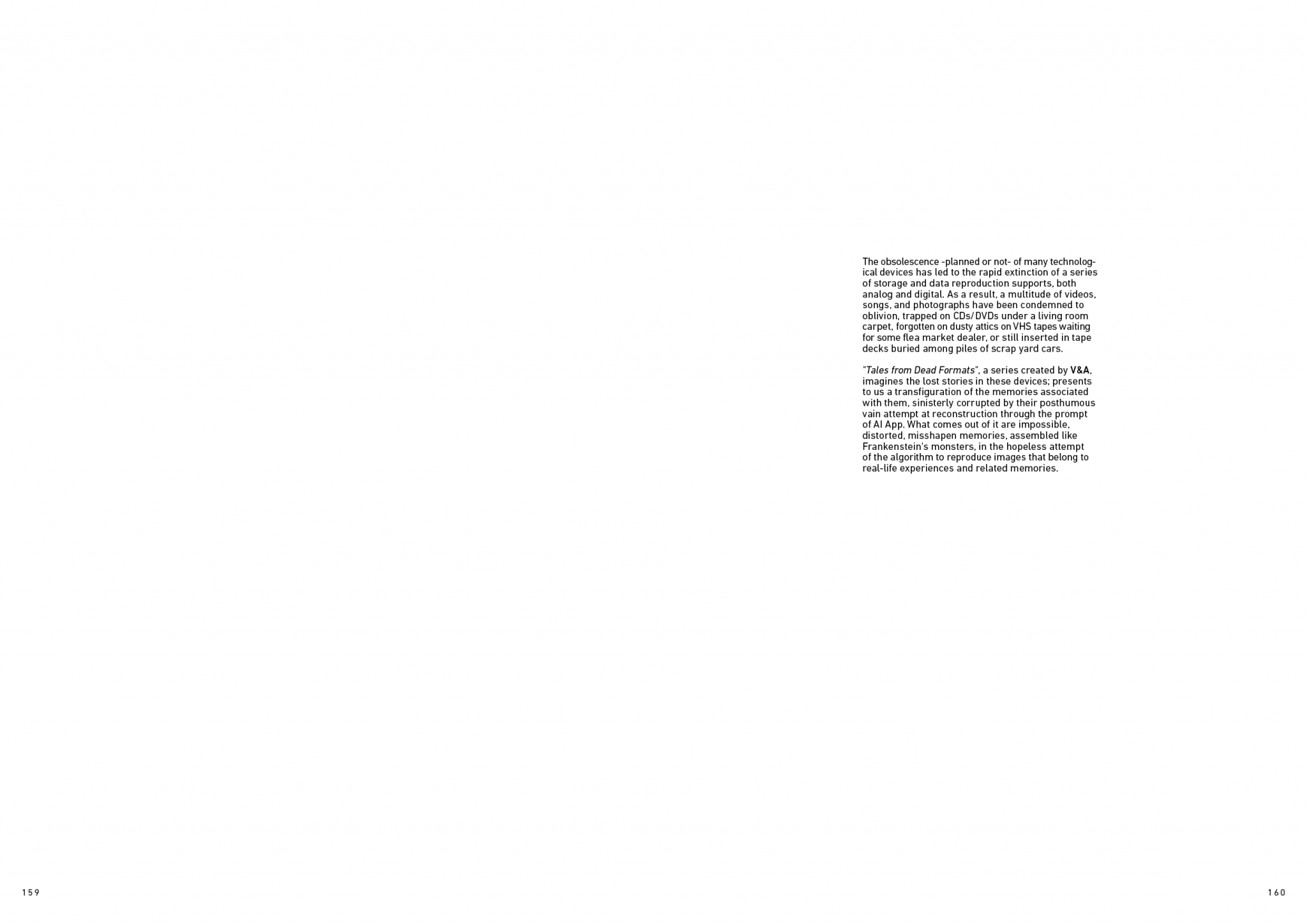
The obsolescence -planned or not- of many technological devices has led to the rapid extinction of a series of storage and data reproduction supports, both analog and digital. As a result, a multitude of videos, songs, and photographs have been condemned to oblivion, trapped on CDs/DVDs under a living room carpet, forgotten on dusty attics on VHS tapes waiting for some flea market dealer, or still inserted in tape decks buried among piles of scrap yard cars. “Tales from Dead Formats”, a series created by V&A, imagines the lost stories in these devices; presents to us a transfiguration of the memories associated with them, sinisterly corrupted by their posthumous vain attempt at reconstruction through the prompt of AI App. What comes out of it are impossible, distorted, misshapen memories, assembled like Frankenstein’s monsters, in the hopeless attempt of the algorithm to reproduce images that belong to real-life experiences and related memories.
